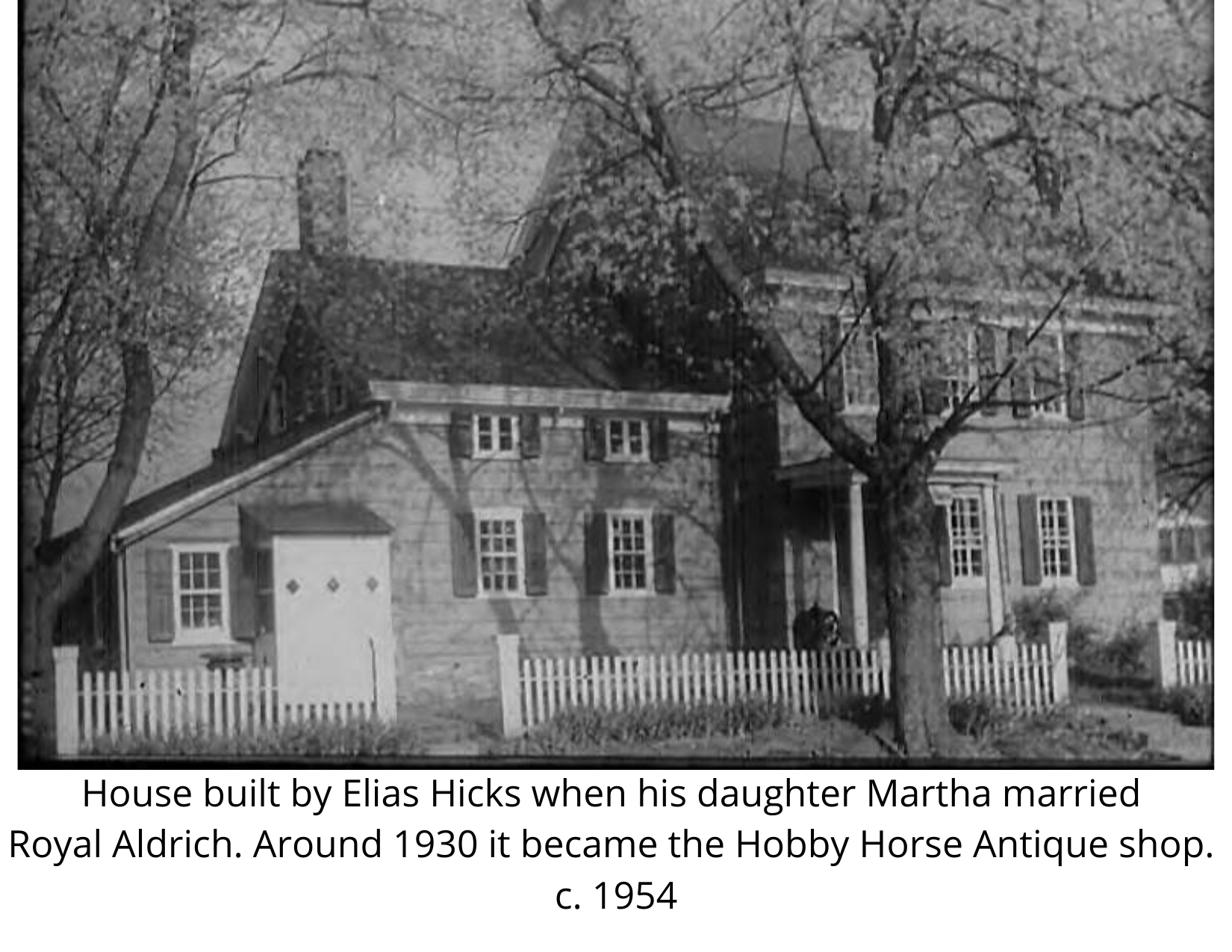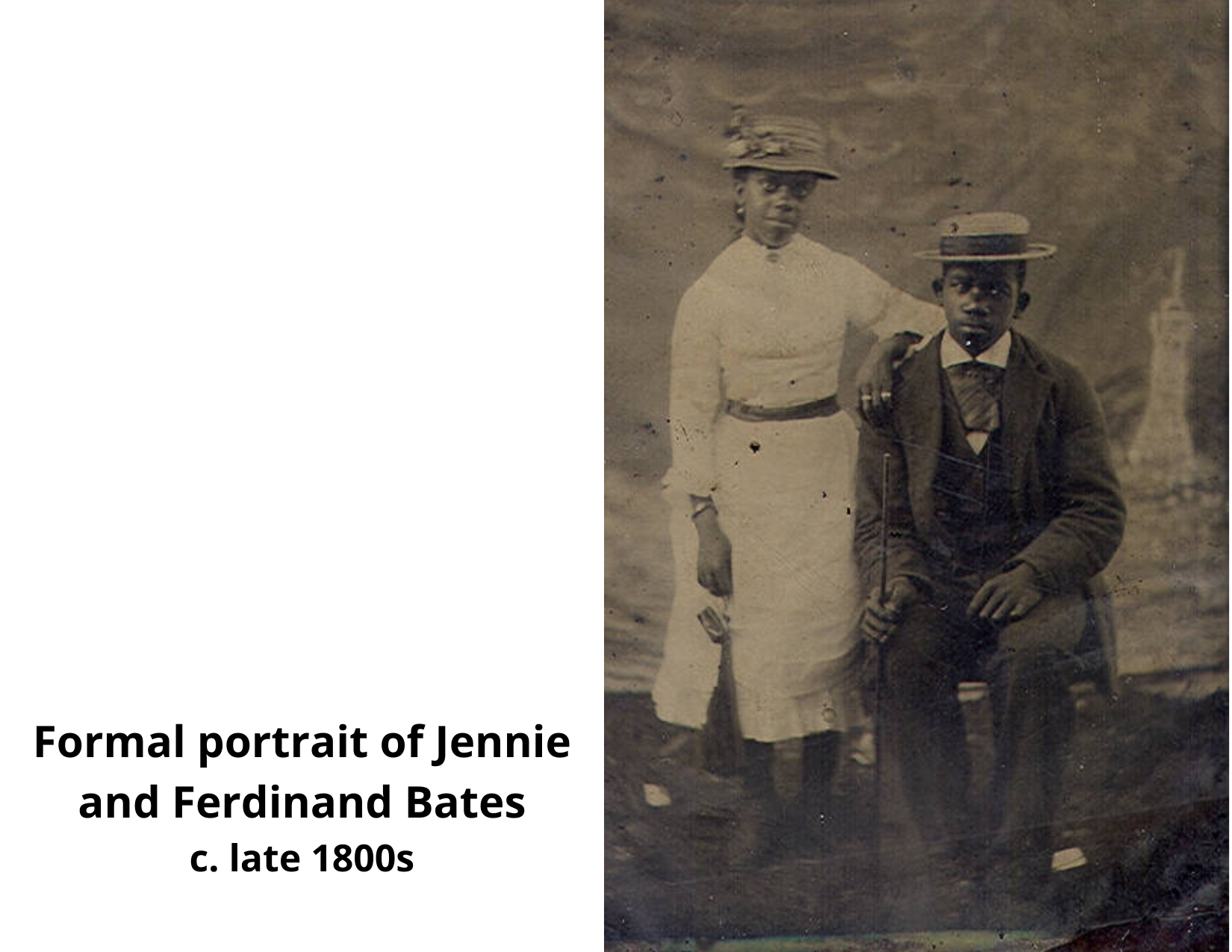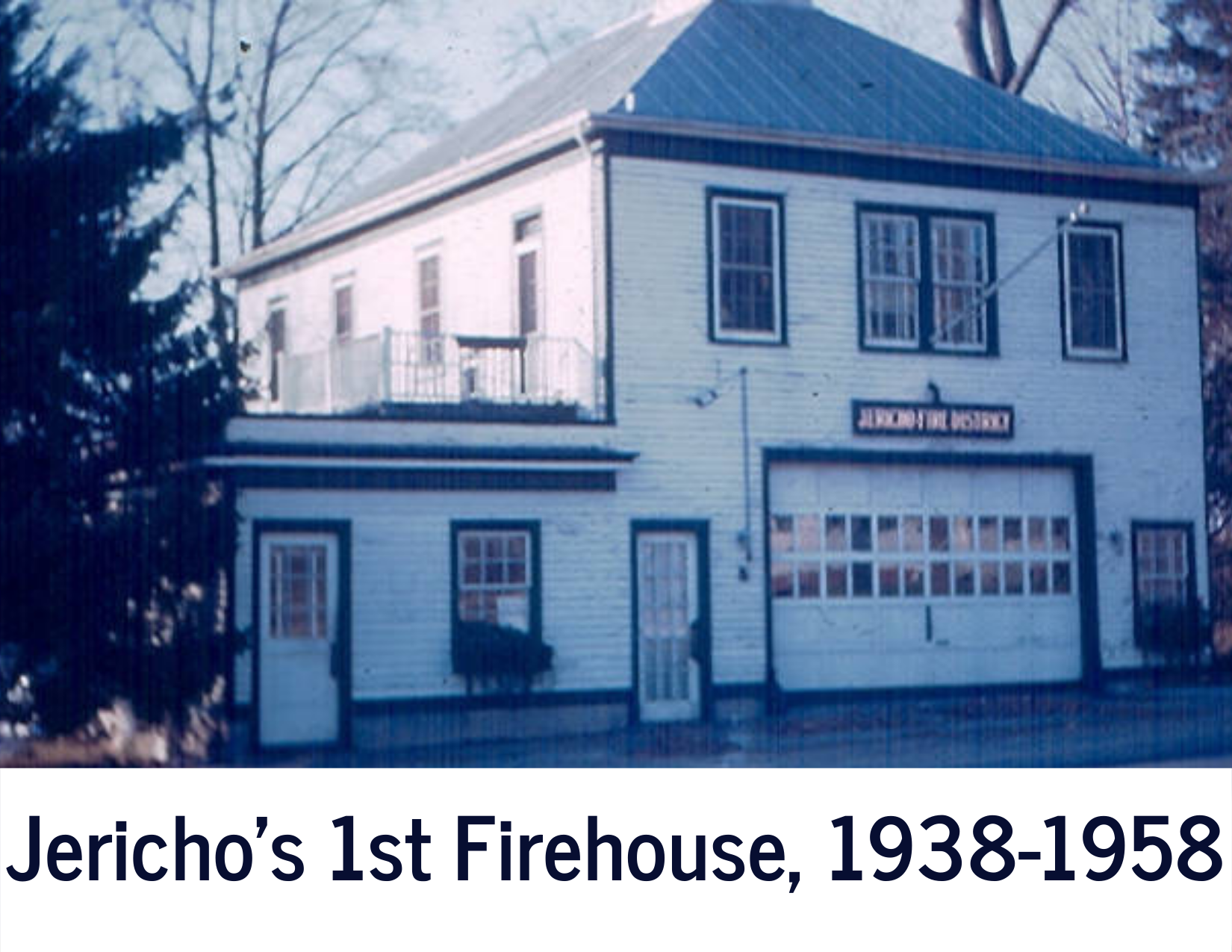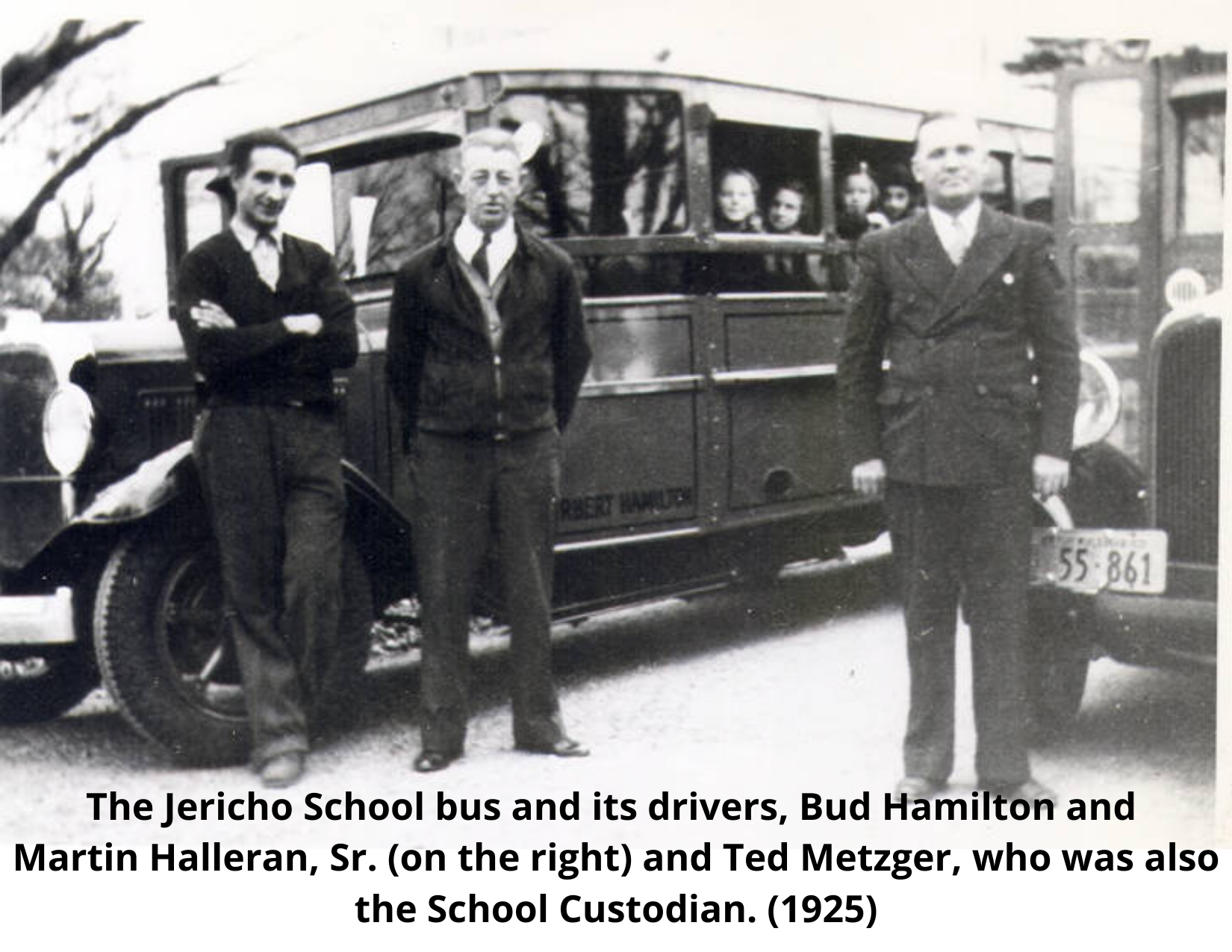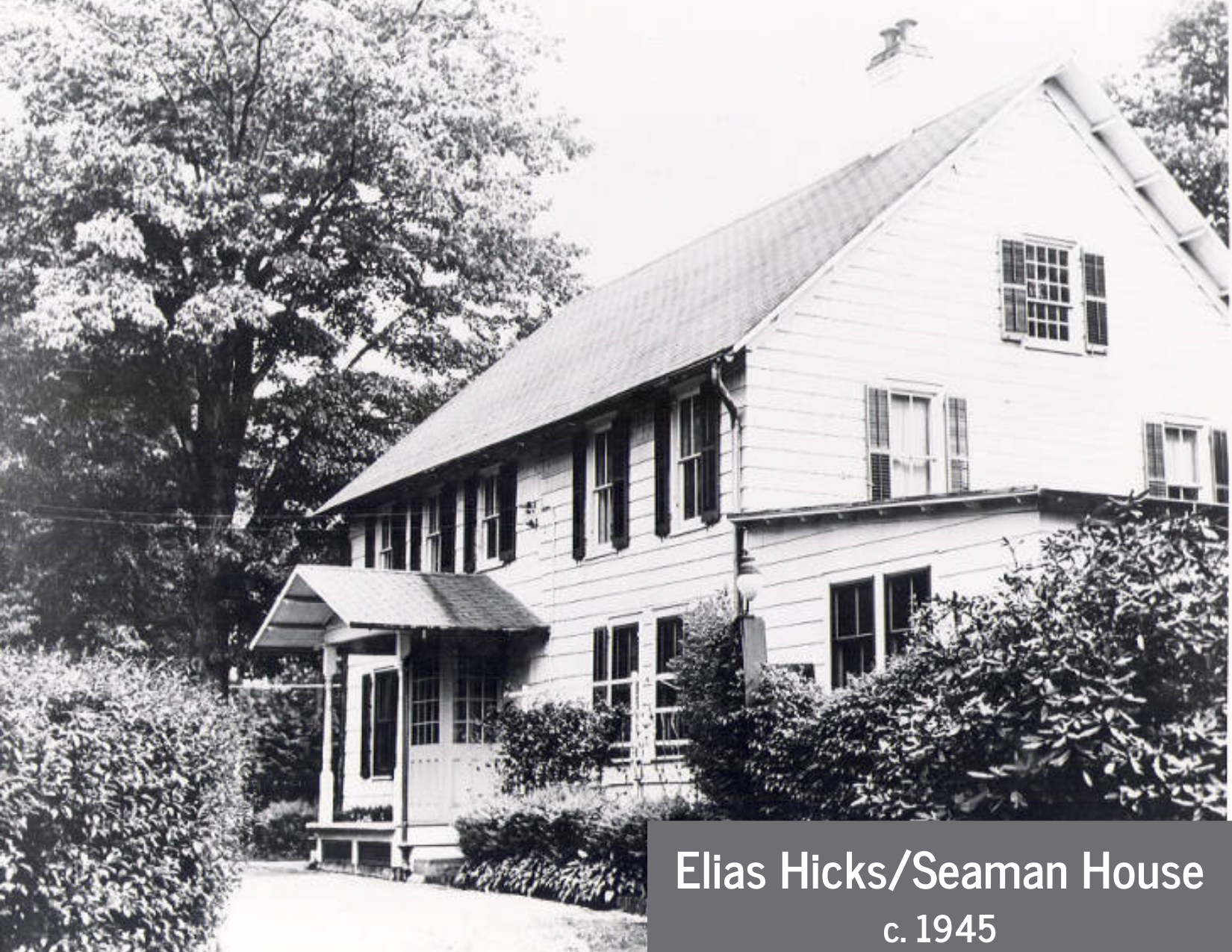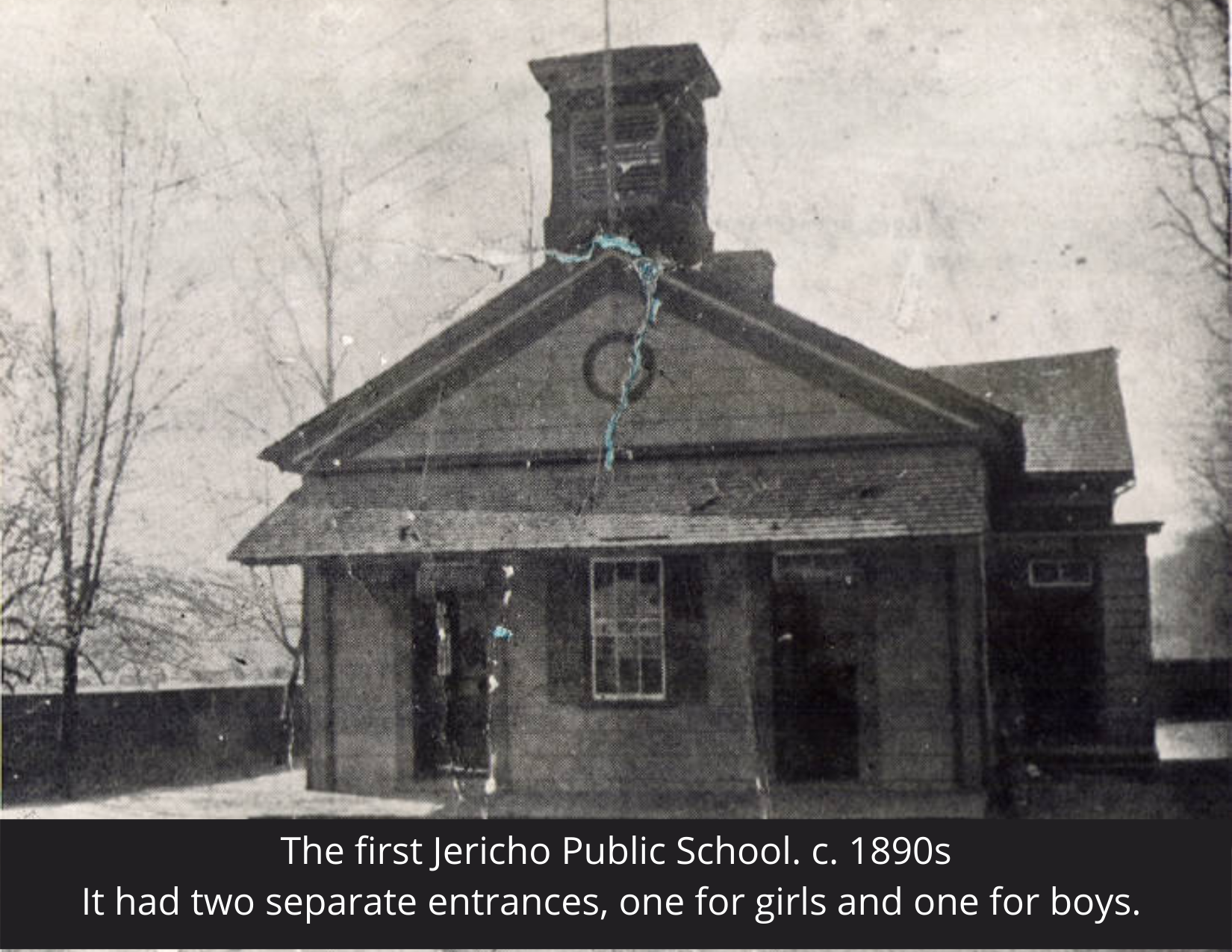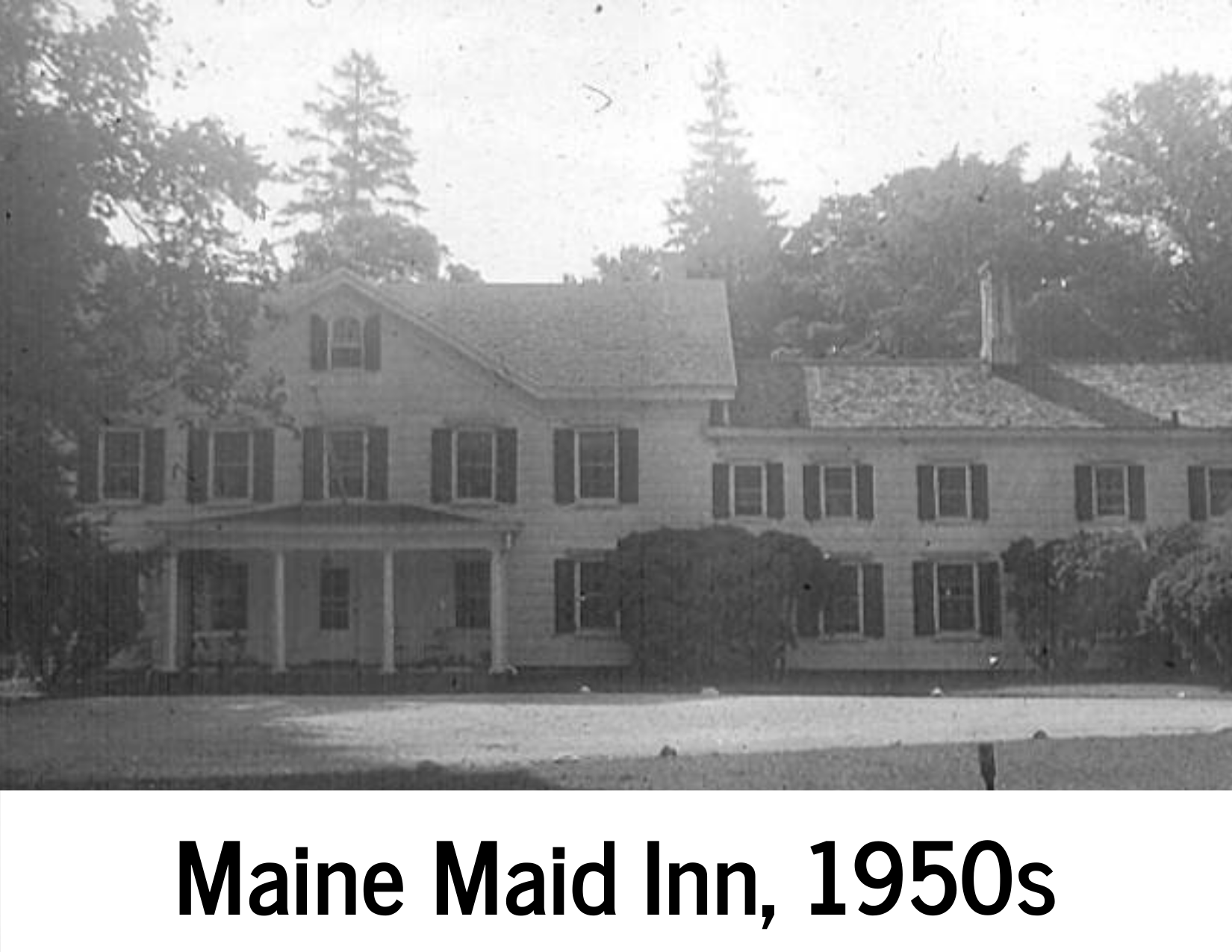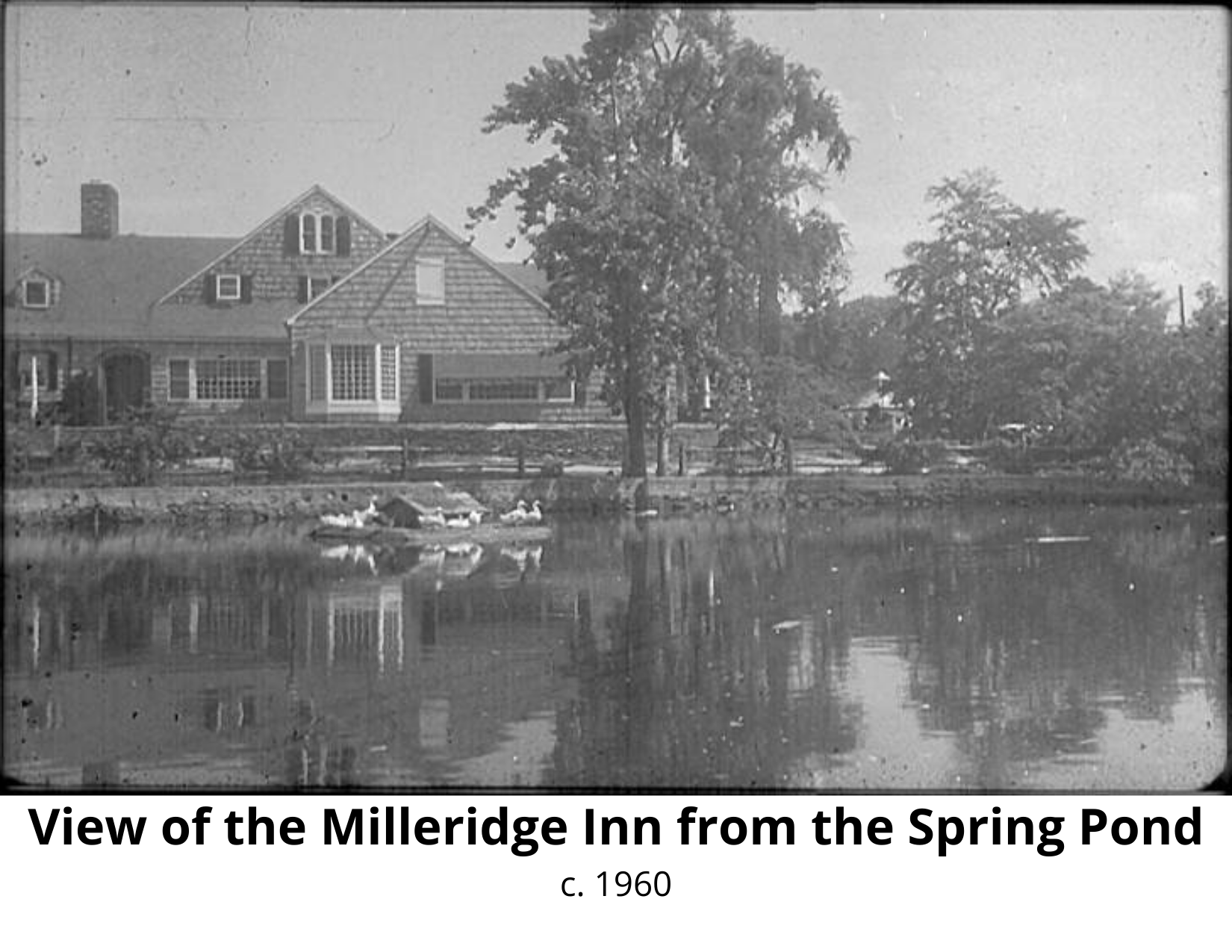Introduction
The following items are listed in alphabetical order for an easy search for subjects relating to Jericho’s history - long ago and recent facts as well. If you need more in-depth information than what is found on these pages, please visit our Local History Collection and Archives on the second floor. Call to schedule a visit or email bmurphy@jericholibrary.org and our Local History Librarian, Betsey Murphy, will get back to you as soon as possible. To search for a topic, click on the letter of the alphabet you are interested in. People’s names are listed with last names, first = “H” for: Hicks, Elias. For buildings or places go to their name = “G” for the George A. Jackson School, or "J" for the Jericho Cider Mill.
A | B | C | D | E | F | G | H | I | J | K | L | M | N | O | P | Q | R | S | T | U | V | W | X | Y | Z
A
Abbe, Kathryn McLaughlin (1919-2014) and James E. (1913-1999) = Kathryn and her twin sister, Frances McLaughlin Gill, were born in Brooklyn in 1919. They studied photography at Pratt Institute, became full time professional photographers in 1941 and rose to the top in their profession. Kathryn married James Abbe, Jr., also a professional photographer in 1946. After three children Eli, Lucinda and Thomas, the family moved to Brookville Road and joined the Jericho Society of Friends. “Jimmy” bought a summer cottage in Montauk overlooking the ocean where they summered for the next 70 years. They devoted their time to children, photography, travel, reading and the Quakers. Kathryn served as Clerk of the Jericho Friends Meeting for 25 years. James died Oct. 7, 1999 at age 87. Kathryn died on Jan. 18, 2014, at age 95. They are buried in the Jericho Friends Burying Ground. See also: Twins on Twins, 1980, Crown Books. JPL Circ. [ 155.444 A] and Twin Lives in Photography, 2011, JPL Circ. [Bio Abbe].
Abbe, Thomas = “Tom” is the youngest son of James and Kathryn Abbe. Tom, a photographer and antique car dealer, and his wife, Koren have two sons, Gabriel and Ethan. They lived in a house on his parent’s property on Brookville Road and were frequent patrons of the Jericho Public Library. After Kathryn died in 2014, the property was sold - Tom and family moved to Englewood, Florida.
AHRC Foundation = originally founded in 1950, as a day school for "special needs" children, with Margaret Reiss as President. A lovely mansion, "Big Tree Farm" on Wheatley Road in Brookville, has been used since 1968 as the Children's Education Center. Helen Kaplan served as president from 1961 to 1988 and expanded their services throughout Long Island and New York. It is a popular charity and is successfully operating today.
Albertson, Emma (1852-1937) = See: Underhill, Emma Albertson
Albright, Joseph Medill Reeve Paterson (1937-) and Madeleine J.K. (1937-2002) = He is the grandson of Joseph Medill Patterson, the publisher of The Daily News and husband of Madeleine, the first woman US Secretary of State, and nephew of Alicia Patterson, founder of Newsday. They lived on Remsen Lane, Upper Brookville, from 1961-1967 and divorced in 1982.
Aldrich, Royal (1769-1839) = a Quaker tanner from the Uxbridge Meeting in Worcester, Mass. He was the son of Stephen and Mary Aldrich of Northbridge, Massachusetts. In 1792, Royal married Martha Hicks (1771-1862), the eldest daughter of Elias and Jemima Hicks in Jericho. They lived in a house Elias had built for them on Jericho Turnpike. There are no records of children. They are buried in the Jericho Friends’ Burying Ground. See also: Hicks, Martha and family.
Aldrich, Winthrop Williams (1885-1960) = Grandon of English immigrants and son of Senator Nelson, of Rhode Island and Abigail Aldrich. He had a law degree from Harvard, passed the NY Bar in 1912, and married Harriet Alexander in 1916. They built Broadhollow in I926 on Cedar Swamp Road. Winthrop was one of eleven children, his sister Abby was married to John Rockefeller, Jr. See also: Broadhollow
Algonquian people = original inhabitants of Long Island, aka “Native Americans.” They did not develop into a tribal system until after 1650 when the Europeans gave them names for the areas they inhabited. See also: The Algonquian Peoples of Long Island from Earliest Times to 1700. JPL LI Coll. [R 970.4] and We Are Still Here. JPL, LI Coll. [R 970.4] both by John Strong.
AME Zion Church or “Colored Church” = it was originally built as a Dutch Reformed Church about 1871 on property donated by Lewis Ficken on the Oyster Bay Road (now Rte. 106). It closed in 1881 when the Dutch Reformed congregation could no longer support a satellite church. Evidence shows it became an AME Zion Church (African Methodist Episcopal) sometime later - it is marked on a framed 1923 Hagstrom map in our archives as the “colored church.”
Arstark, Lester D. (1924-c.1979), Janice Corn Arstark and daughter, Dru Arstark = purchased the Seaman/Elias Hicks house from the owner at that time, Henry Willets Underhill in 1960. They lived there for 12 years, until 1973 when the property was purchased by Nassau County to become an Elias Hicks Museum. That plan never materialized, but the property was preserved as part of the Jericho Historic Preserve in 1972.
B
Bachteler, Lawrence F. Sr.(1924-1984-) and Lawrence F. Bachteler, Jr (1948- ) = both father and son served as Fire Chiefs of the Jericho Fire Department. They were trained volunteers. Lawrence, Jr. served as Fire Chief from 1979 to 1982 and his father served from 1982 to 1984. See also: Fire Chiefs of Jericho
Bates, Isaac (1823-?)and Elizabeth Willis Bates (1828-1885) = a free black couple who were married in 1867 in Syosset by John Cooke, “Minister of the Gospel.” Isaac was reported to be “half Indian” by his granddaughter Florence who donated an arrowhead he made to the JPL archives. Isaac and Elizabeth were the parents of Ferdinand Bates and the grandparents of Florence B Tollaver. They are buried in the Jericho Quaker Burying Ground. [Isaac Bates was first married to Catherine Stench (b.1820-185?) in 1844 in TOBAY. They had 2 daughters who were Ferdinand Bates half-sisters and Florence Bates' aunts.]
Bates, Ferdinand D. (1866-1890) and Jane “Jennie” Louisa Parker (1870-?) Bates = Ferdinand was the son of Isaac and Elizabeth Willis Bates. There were a free black couple who may have lived in “Guinea Woods.” Jennie and her mother, Elizabeth Willis had worked as seamstresses for the Underhill family. They are buried in the Jericho Quaker Burying Ground. Jennie and Ferdinand were married in 1887 and had 4 children, Valentine, Florence, Helen and another girl. Valentine Bates lived with a German family in Hicksville and was the first “colored” pupil to attend Hicksville school. Jennie married Frederick Tollaver in 1896 in Hempstead. See also: Tollaver, Florence B.
"Bayberry Downs" = See: "Windfall," (the Francis Tilden Nichols mansion, off Rte. 107 in Brookville/Muttontown)
Bayer, Elvira [Mrs. Charles L.] (1877-1961) = owner of the former Valentine Hicks house, a widow of Charles Bayer, an Oyster Bay furrier, and mother of three girls. She sold her property on Old Jericho Turnpike to Percy Roberts to be used as the Maine Maid Inn, in 1950. One of the Bayer daughters married and lived in a “new,” c.1960, house across the road, referred to later as the Cheshire House.
Beckerman, Julianne Wesley (1969-) = former mayor of Muttontown. She is married to Adam Beckerman.
Bicentennial Fair of 1976 = as it was celebrated in Jericho. JPL Archives has photos of a large fair held in a big field, most likely in July. The Library had an exhibit table there. The Fair featured costumes, old cars, etc. See: LI Coll. photo album and New York Heritage Digital Collections.
Birchwood Civic Association or BCA = founded in 1956 as a non-profit Neighborhood/Block Association. It encourages residents to be active and care about their community. It serves as a means of providing updated information to mitigate any negative impact to the area. They collect dues and send out a newsletter. They also hold an annual BBQ near the Cantiague Elementary School.
Bogart, Rev. David Schuyler (1770-1839) = son of Nicholas and Annatje Bogart. David attended Columbia College, served in the Union Army, married Elizabeth Platt and had 4 children. He served as pastor at the Brookville (Dutch) Reformed Church from 1813 to 1826 when he retired because of poor health. Rev. Bogart died in 1839 and is buried in Green-Wood Cemetery in Brooklyn.
Book of Discipline = one of the books issued by the Yearly Meeting of the Religious Society of Friends laying out the ideals of Quaker faith and practice. It was read aloud several times a year in the local Meetings and was permitted to be changed or updated as needed.
Borley, Frank (c.1905-1990?) = a Burke Ave resident of Jericho. One of the original founders of the Jericho Fire Department.
Bowne, Martha Valentine Willets (1850-?) = daughter of William S. Willets (1822-1864) and Mary Valentine (1823-1891). In 1871, she married Sidney Breese Bowne (1849-1915). They had 3 boys, but only Herbert Sidney Bowne (1878-1951) survived. They were members of the Jericho Quaker Meeting.
Boyce, Harrison Hurlburt (1882-19??) = Resident (in the Valentine Hicks House) of Jericho (on Old Jericho Turnpike) and inventor of the Boyce Moto Meter (Motometer Co. Inc.), a thermostat for automobile radiators to prevent radiator overheating. He partnered with George Henry Townsend II, president of Moto Meter C of NY to help finance the invention. He had an office on Broadway at 58th Street, and later in LI City, NY. See also: Boyce Moto-Meter, Maine Maid Inn, and the JPL LI Coll. Archives for the landscape plans
Boyce Moto-Meter = invented by Harrison H. Boyce, a Jericho resident, filed the first patent on the Moto-Meter about 1912. He and his partner, George Henry Townsend II launched the company which was an immediate success. They dominated the market after they won several lawsuits against similar devices. Automobile engines in those days frequently overheated. The Moto-Meter perched on the hood of the car like an ornament and warned the driver when the engine was getting too hot. It became standard equipment on 50 different brands of American automobiles. They produced over 10 million by 1927. Townsend sold the company for several million dollars just before the Stock market Crash of 1929.
Braner, Linda E. (1902-1992) = Linda and her husband Henry moved from Queens to Jericho in 1952. She had no children but dressed in costume and went to the schools to teach the students about colonial times on Long Island. An amateur photographer, Mrs. Linda Braner took hundreds of pictures and slides. She recorded the destruction of old Jericho by the New York State D.O.T. from the mid- 1950s into the 1960s. These photographs are a big part of the JPL archival collection. In 1960, our self-appointed historian wrote a history of Jericho as seen through the story of the Jericho Post Office in a 21-page booklet called, "The Mailman Cometh to Jericho." It was illustrated by John F. Schwind and went to 3 printings, 1960, '72 and '80. The unsold copies became the property of the Jericho Library after her death in 1980.
Broad Hollow House = home of F. Ambrose Clark on Powell Lane, Old Westbury. The property is now part of SUNY Old Westbury after a fire destroyed the mansion in 1968. See also: Clark, F. Ambrose
Broadhollow = a Brookville mansion on (Route 107) Cedar Swamp Road, built by Winthrop Aldrich in 1926 and designed by his older brother William Aldrich, an architect. Broadhollow was sold about 1950 to Alfred Gwynne Vanderbilt. In 1956 it was purchased by James P. Donahue, Jr. who died in 1966. Percy Uris was the next owner. His wife continued to live there until her death in 1985. The best pieces of their period furnishings were auctioned by Christies in Nov. 1985. The mansion was the site of a “Decorator’s Showcase” in 1989. Today the estate is divided up into an enclave of many large homes surrounding the original main house. See: The Contents of Broadhollow JPL LI Coll [R. 728.09747 C] and Broadhollow LI Coll. [R 728.09747 M]
Broadway = the main street (6 lanes) running north/south through Jericho. In the past it was called the Oyster Bay Road, the Hicksville Road and now Broadway and Route 106/107. It splits at the Jericho Turnpike intersection. Route 107 forks a bit northwest on Cedar Swamp Road towards Glen Cove. Route 106 goes northeast toward East Norwich and into Oyster Bay.
Broadway Mall = built in 1956 on the site of St. John’s Protectory Orphanage, this shopping mall was originally called Mid Island Shopping Plaza, with Gertz Department Store as the main attraction for shoppers. In 1968 it was enclosed for indoor shopping. In 1989 it was renamed Broadway Mall and today it is called Broadway Commons.
Brookville (Incorporated in 1931) = a village just north of Jericho. In the 1950s Brookville annexed Wheatley Hills and doubled the size of the village. See also: Lost Village of Wheatley by Randall J. Leboeuf, Jr. JPL LI Coll. [R 974.7245 L]
Brookville Cemetery = Just north of Northern Blvd. at Brookville Road and Wolver Hollow Road.
Brookville, Old (Incorporated in 1929) = a 3 square mile village just north of Jericho. It is part of the North Hill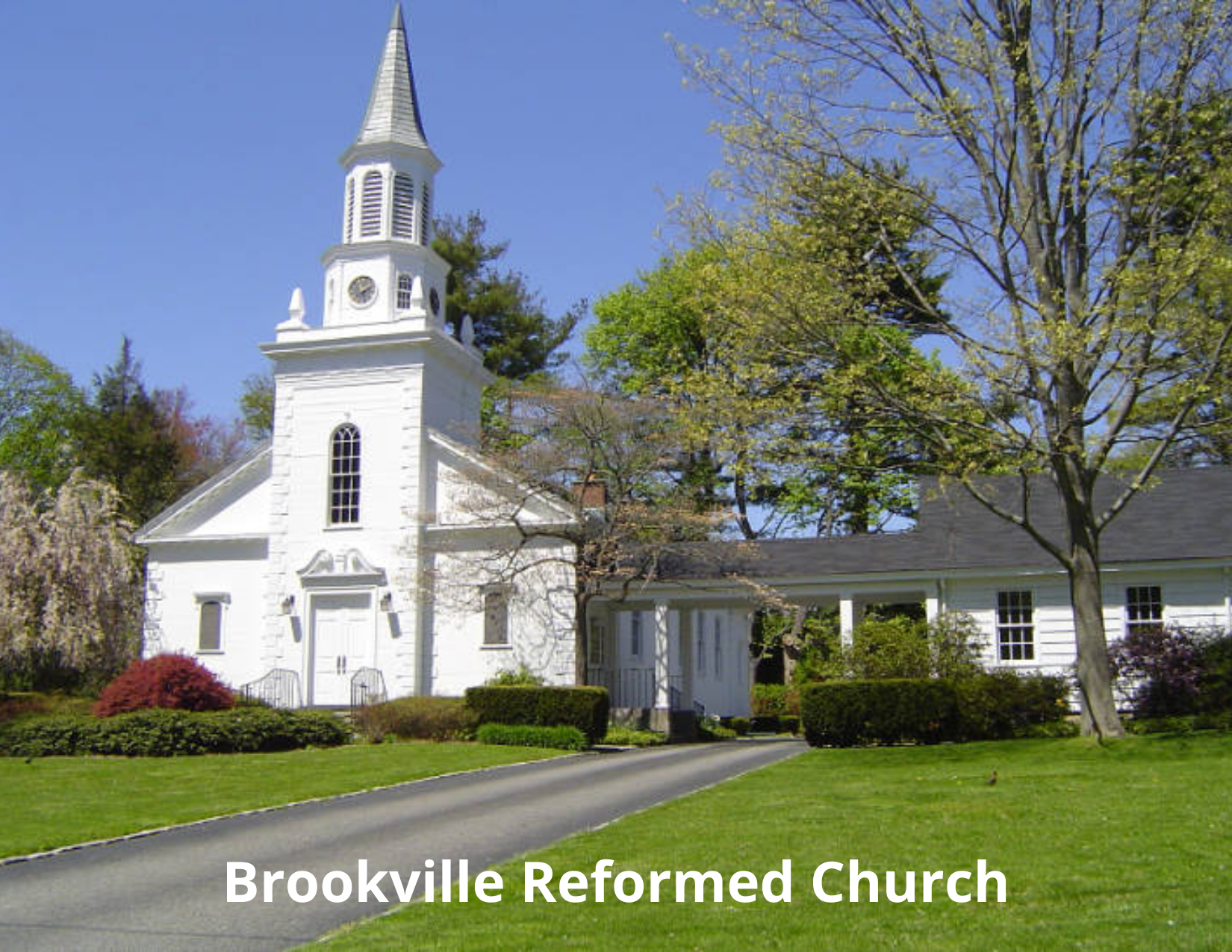 s School District.
s School District.
Brookville Reformed Church (1732) = formerly called the Dutch Reformed Church, it was formed by members of the Protestant Dutch Congregation of Oyster Bay in 1732 so local people could worship in the Dutch language in Wolver Hollow. They purchased land and built a crude hut. It served for one hundred years before a proper church building was erected on Brookville Road, just south of Northern Blvd. Rev David Schuyler Bogart (1770-1839) became pastor of the Dutch Reformed Church at Brookville (then called Wolver Hollow) in 1813. He served that congregation and another one in Lake Success until 1826. He retired because of ill health and died in NYC. Reverend Robert Quinn served as the first full-time minister in 1832. He lived in the parsonage built in 1835 on Northern Boulevard. In 1870 the minister preached on Sundays in the (1st) Jericho Public School building. In 1880, with the growing congregation they built a small chapel just north of the Jericho Cider Mill. (It later became the AME Zion Church or “Colored Church” for several years.) The Brookville church building was re-built in 1924 after a serious fire and was re-dedicated in 1926. The church building was again restored and re-dedicated in 1991. See also: Brookville Reformed Church and Houses of Worship. See also: Chapter 15 in Jericho the History of a Long Island Hamlet JPL Circ. and LI Coll. [974.7245 J]
Brookville, Upper (Incorporated in July 28, 1932) = a village just north of Jericho, originally to be named Lower Brookville. A wealthy longtime resident, Mrs. Iselin said that she refused to live in “lower anything,” so the village was named Upper Brookville. See also: The History of Upper Brookville 1932-1982 by John Rawlinson, JPL LI Coll. [R. 974.7245 R]
Bruce, Alisa Mellon (1901-1969) = daughter of banker Andrew W. Mellon and the ex-wife of American Ambassador David K. Bruce (1898-1977). They had a daughter Audrey in 1934 and divorced in 1945. Alisa left a 121-acre estate with a 32-room mansion on Jericho Turnpike at the Syosset/Woodbury border which is now an Oyster Bay Park/golf course and catering spot.
Broome, Ray (1897-1975) = Ray, one of the founding organizers of the Volunteer Fire Department, was elected the first Jericho Fire Chief from 1933 to1934. He was in charge of the Firehouse and firefighting. He also worked on one of the Brookville estates as a caretaker. See also: Page, Ernie, the first live-in custodian and dispatcher.
Burden, Arthur Scott (1881-June 1921) and Cynthia Roche Burden (1882-1966) = built Oak Hill on Cedar Swamp Road and Fruitledge Rd., Brookville. The couple were married from 1905 to 1921. Burden died at age 42 from serious head injuries incurred while playing polo. Cynthia married Guy Fairfax Cary in 1922. See also: Cary and Oak Hill
Burrill, Middleton Shoolbred (1858-1933) = son of John E. and Louise M. Burrill, he attended Harvard (1874-79). He graduated from Columbia Law School in 1881 and married Emilie Neilson (1862-1945). They had two girls and a boy, but only one daughter, Louise (“Leonie”) lived to adulthood. Burrill was a wealthy lawyer and financier, and the family lived in a beautifully renovated townhouse at 36 E. 38th St. in NYC, which is now a landmark. In 1906 “Jericho Farm,” their summer estate was designed by John Russell Pope and built on nearly 1,000 acres on the north side of Jericho Turnpike, southwest of Cedar Swamp Road. Burrill died in 1933 and is buried in Greenwood Cemetery. Mrs. Burrill donated her Simplex open “touring” car to be used as a hose truck by the newly formed Jericho Fire Department in 1933. In 1953 the estate was sold and most of the property became the Meadow Brook Club. See also: JPL LI Coll. photo album
C
Cantiague Elementary School (1962) = located at 678 Cantiague Rock Road, Jericho, this was the 5th elementary school opened in Jericho. It was built in 1962 to serve the West Birchwood community and cost $1.5 million, at the time, to build.
Cantiague Park (1961) = 480 West John Street, Hicksville. It is an active Nassau County Park with a swimming pool and indoor skating rink today.
Cantiague Rock = a large boulder, allegedly sat where Robert Williams signed the “purchase” of the Jericho area; 6 thousand acres in 1648, with “Pugnipan”, a Native American. This land purchase has been called several names over time including, the “Springs,” the Williams’ “Plantation”, and “Lewsum” or “Lusum.” The Williams purchase today would include most of the Town of Oyster Bay. The rock was moved from its original location and relocated to Cantiague Park in the early 1960s. See also: Cantiague Park
Cantiague Rock Road = runs from Jericho Turnpike south to West John Street in Hicksville.
Carll, Albert G. (1818-1872) = the oldest son of Dr. Selah S. Carll, Albert was Jericho’s 4th Postmaster from 1839-1841. He served again from 1844-1852 and a third time from 1854 to 1859.
Carll, Dr. Selah S. (1789-1857) = sixth generation descendant of Thomas Carll (or Carle or Carl) of Hempstead. He was the son of Phineas Carll, Supervisor of Huntington. A Quaker, Dr. Selah Carll moved to Jericho to establish his medical practice here. He bought land from Adonijah Underhill for $500 in 1816, built a house on Old Jericho Turnpike and had ten children. Carll became one of the first members of the Queens Medical Society and probably treated his neighbors, Elias Hicks and family. He held the office of the Oyster Bay Town Clerk for 3 years. He was school commissioner, highway overseer and trustee of the Jones Fund for the Poor. He also speculated in real estate owning 19 separate parcels of land and had purchased a hotel in Hempstead with Valentine Hicks in 1847. He is buried in the Quaker Burying Ground in Jericho. His property in Jericho was auctioned off to the highest bidder, one Newberry Sprague. It later became the Ketcham/McAllister House when it was purchased in 1974 by Nassau County as part of the Jericho Historic Preserve.
Carter, William Lafayette (1889-1971) = He was born in Aucilla, Florida, came north to teach and became the principal Jericho Elementary School in the 1930s. He was an original member of the first Jericho Fire Department in 1939. He was married to Bessie L. Carter of Alabama.
Cary, Cynthia Burke-Roche Burden (1882-1966) = an Englishwoman and also Great-Aunt of Princess Diana, lived on Cedar Swamp Road and Fruitledge Rd., Brookville in a house called Oak Hill, built by her first husband Arthur Scott Burden, who died in 1921. Cynthia married Guy Fairfax Cary in 1922. The mansion was demolished in the 1950s. See also: Oak Hill
Cedar Swamp = former historical community in Nassau County, Town of Oyster Bay, presently the site of the Village of Old Brookville.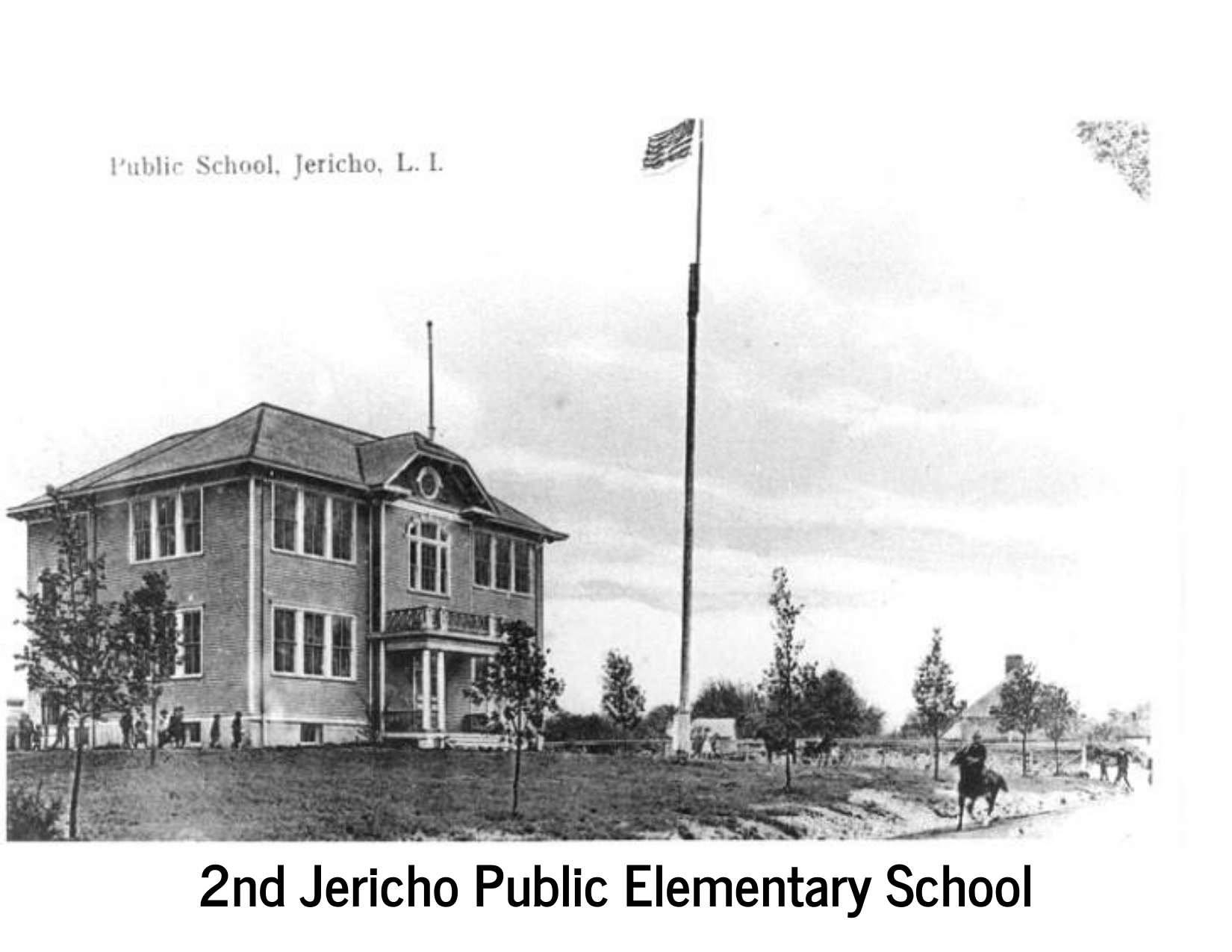
Cedar Swamp Road = another name for Route 107 which runs, from Glen Cove at the north, southeast through Jericho, where it changes name to Hicksville Road/Route 107 which doesn’t end until Merrick Avenue.
Cedar Swamp School = this was the second public elementary school building in Jericho. It replaced the original two-room school on Rte. 106. It was built on Route 107, also known as Cedar Swamp Road. This four-room wooden frame building was condemned by NY State in the 1930s as a firetrap, because it lacked fire escapes. A new eight-room, red brick single story, elementary school went up in front of the old structure which was demolished. Now, after many extensive additions, that same red brick building is officially called Jericho Middle School and Jericho High School.
Cemeteries = the Jericho Quaker Meeting House Burying Ground is the biggest and best-known cemetery in Jericho. There is an African-American Cemetery on the SE side of Brookville Rd NW of Rte. 106. The Brookville Cemetery is off Northern Blvd. and Wolver Hollow Road. The Dodge Cemetery is on Rte. 106 and is not accessible to the public. The Tappentown Cemetery off Rte. 107 (east of Cowpath and west of Fruitledge) is not accessible to the public either. Titus Burial Ground lies between Rolling Drive and Wheatley Rd. Townsend Cemetery is located on the west side of Jericho Tpke., just west of old turnpike intersection. Weekes-Ficken Cemetery on the north side of Muttontown Rd opposite Woodhollow Court. The H. Willets Underhill estate (now Bristal Assisted Living) had a family plot that was planted over in the early 1900s. Some Townsend headstones found piled in a barn were sent to the Raynham Hall Museum in Oyster Bay.
Charity Society of Jericho and Westbury = Formed in 1794 in Jericho by 30 members of the Jericho and Westbury Monthly Meeting of the Religious Society of Friends. The Charity Society’s purpose was “to help improve the condition of the poor among the black people by educating their children.” The Society went on to open schools for black children in the South as well, first in Lincoln, Virginia in 1868, later moved to the Tait property nearby. Then two in South Carolina - the Martha Schofield School in Aiken and the Lang School in Mt. Pleasant, which was later absorbed into the Charleston school system. See also: The Charity Society 1794-1994 by Edith Gaines, JPL LI Coll [R 289.6 G]
Cheshire House = a historically insignificant house built (circa 1930) on Old Jericho Turnpike next to the Seaman/Elias Hicks house. It was originally built for Muriel Bayer Cheshire (1900- 19??), (Mrs. Leslie R. Cheshire) daughter of Charles L. Bayer (1871-1938) a furrier, and Elvira Bayer who lived in the Valentine Hicks house. This house was probably a wedding gift from her parents.
Chittenden, Maynard N. (1904-1977) = one of the Jericho School bus drivers and a member of the original Jericho Volunteer Fire Department. He served as Fire Chief from 1944 to 1947. He is buried in the Jericho Friends Burying ground.
Churches, see: AME Zion Church, Brookville Reform Church, St. Paul The Apostle RC Church, Dutch Reformed Church and Houses of Worship
Cider Mills, see: Jericho Cider Mill – formerly called The Ketcham & Jagger Cider Mill and The Hicks Cider Mill. See also: Doughty, Benjamin George, Hicks, John, Tappen, Harry and Zulkofske, John & George.
Clark, F. Ambrose (1881-1964) = resided at Broad Hollow House on Powell Lane, Old Westbury (near LIE) which he had built in 1912. Heir to the Singer Sewing Machine fortune, he married Florence Stokes (1902-1950) and Augusta Davies in 1952. Ambrose was an avid horseman and breeder of racehorses. The mansion burned down about 1968, but some other buildings on the estate remain. The property is now part of SUNY Old Westbury.
Collins, Denward W. Jr. (1936 -) = “Den” worked on the Henry Willets Underhill estate from his teens in the 1950s. He was a family friend and support for Peggy Underhill in her later years and served as executor for her estate. An architect by profession, Den also served as president of the Nassau County Historical Society for twenty years and is still an active member of the Board of Trustees.
Conroy, Janice S. = was the 21st Postmaster in Jericho in 1989.
Convery, Kathleen (1920 - ) = born in Scotland, daughter of Henry and Annie Convery, twin sister of Mary Convery. Pictured in Jericho School Class of 1936-37. She married Ralph O. Bedient (1914-?). They had a daughter Kathleen and a son Michael.
Convery, Mary (1920- ) = twin sister of Kathleen. The twins also had a brother and 2 more sisters.
Council Rock, Oyster Bay = the traditional location of Friends Meetings, one of which was attended by George Fox in 1672. Here he met with the Wright's, Underhill's and Feeke's at a Quaker Meeting during his visit to America. It has an official marker on Lake Ave. just south of W. Main Street
Crane-Simplex automobile (1904-1924) = built in New York by Smith & Mabley it was among the most expensive, powerful and well-built cars of the time. Originally built in 1904, mostly with Mercedes parts, it was called the S & M Simplex. After a bankruptcy it became the Simplex Automobile Company in 1907 and the car was re-designed. In 1915 it was bought by the Crane Motor Car Company of Bayonne, New Jersey and the car was called the Crane-Simplex. Mrs. Middleton Burrill donated her 1910 Simplex open “touring” car to the Jericho Fire Department. It was converted into a hose truck by the Jericho Volunteers to be used until they could afford to purchase a real fire truck.
Curth, Frank (1893/4-1991) = Frank owned the former Maltby Garage that started as a blacksmith shop around 1883 on the northwest corner of Jericho Turnpike at Oyster Bay Road. He made it into a garage with a machine shop in the back where he did engine and parts repair for aviators from the nearby airfield. There was a barbershop on the second floor. In the early 1900s it became “Locomobile Headquarters,” home of the only American car to win a Vanderbilt Cup race. Frank Curth sold the property in 1933 to the Fire Department to become the first Jericho Firehouse.
D
Davis Bottling Works = a mineral soda company up until 1894 when Edgar Davis sold it. It may have become the Hicksville Bottling Company after that although the family may have still had an interest in the company according to family stories. The bottles are collectable.
Davis, Edgar (c. 1838-1906) = farmer, schoolteacher, owner of the Davis Bottling Works near the Hicksville town line. He served as Jericho’s 9th Postmaster (1866-1870) and Justice of the Peace (1867-1869). He married Phebe D. Smith, had a daughter, Laura in 1870 and son, Francis (Frank) in 1874. The couple are buried in the Jericho Friends Burial Ground.
Davis, Francis ("Frank") B. (1870-1935?) = son of Edgar and Margaret. He married Lillian in 1905.
Davis, Francis Horatio (1910-2003) = a Burke Ave. Jericho resident, he was the son of Frank and Lillian Davis, and grandson of Edgar Davis. He married Mary Scholar. They had Lois, James and Ralph.
Davis, James F. (1942- ) = son of Francis and grandson of Edgar, a member of the Jericho High School Hall of Fame and graduate of Cornell University. Davis currently lives in Hayesville, North Carolina.
Delgado, Richard = was the 23rd Jericho Postmaster in 1990.
DiGiacomo, Thomas F. = was the 20th Jericho postmaster from 1988-1989.
Dodge Family Cemetery = located on Route 106. It is not accessible to the public. Members of the Dodge, Wiggins, Wright, Baker, and Brown families are buried here. A marker for a John Seaman and markers for Thomas and Elizabeth Black were also found.
Doremus, William H. (1938-2010) and Doremus, Ellen E. = previous owners of the Underhill estate at 310 Jericho Turnpike. Ellen (Ellen Korry-Doremus) is an accomplished painter and designer. She moved to the "dower house" a smaller house on the property and maintained a studio there after they divorced. Bill died suddenly in NYC, so the property was inherited by their 2 sons. It was finally sold to The Bristal Assisted Living because private buyers didn't want to deal with the conservation clauses TOBAY had put on the property. Ten acres of the 80 acres of the property were donated to the TOBAY as "open" land, after another 80 acres had been previously sold to the developers of the Hamlet Estates houses on Jericho Turnpike.
Doughty, Anna Wright (1889-1964) = daughter of William and Theresa Wright. In 1914 Anna married John Bodine Doughty, son of Benjamin George Doughty who owned the Jericho Cider Mill. They had 3 children and are both buried at Westbury Friends Meeting Burying Ground.
Doughty, Adeliza Romer Lane (1853-1945) = a daughter of Maria and Benjamin Lane, she married Benjamin George Doughty in 1882. They had one son, John Bodine Doughty.
Doughty, Benjamin (1711-1786) = son of Charles and Elizabeth Jackson Doughty, he married Hannah Williams (daughter of Jerimiah) at Cow Neck, in 1737. They had 6 children: Philadelphia, Charles, Benjamin, Hannah, Elizabeth and William.
Doughty, Benjamin (1744-1802) = son of Hannah and Benjamin, married Rebecca in 1777, is father of Isaac, Robert, Benjamin, Sarah, Elizabeth and Deborah.
Doughty, Benjamin George (Jan.1847-Oct. 1913) = Probably was born in Brooklyn or Queens. Benjamin George married Adeliza Romer Lane. They moved to Jericho in 1890, and bought the local cider mill there. The Doughty's lived in what is now the Milleridge Inn until they had a house built just north of the cider mill on the Oyster Bay Road (Rte. 106). He is listed in the 1910 Census as “Cider Maker,” and owner. He was also an amateur photographer and left a large collection of more than 100 glass negatives dating from 1890 which are now housed in the JPL Archives. He and Adeliza had one child, John Bodine Doughty (1873-1953).
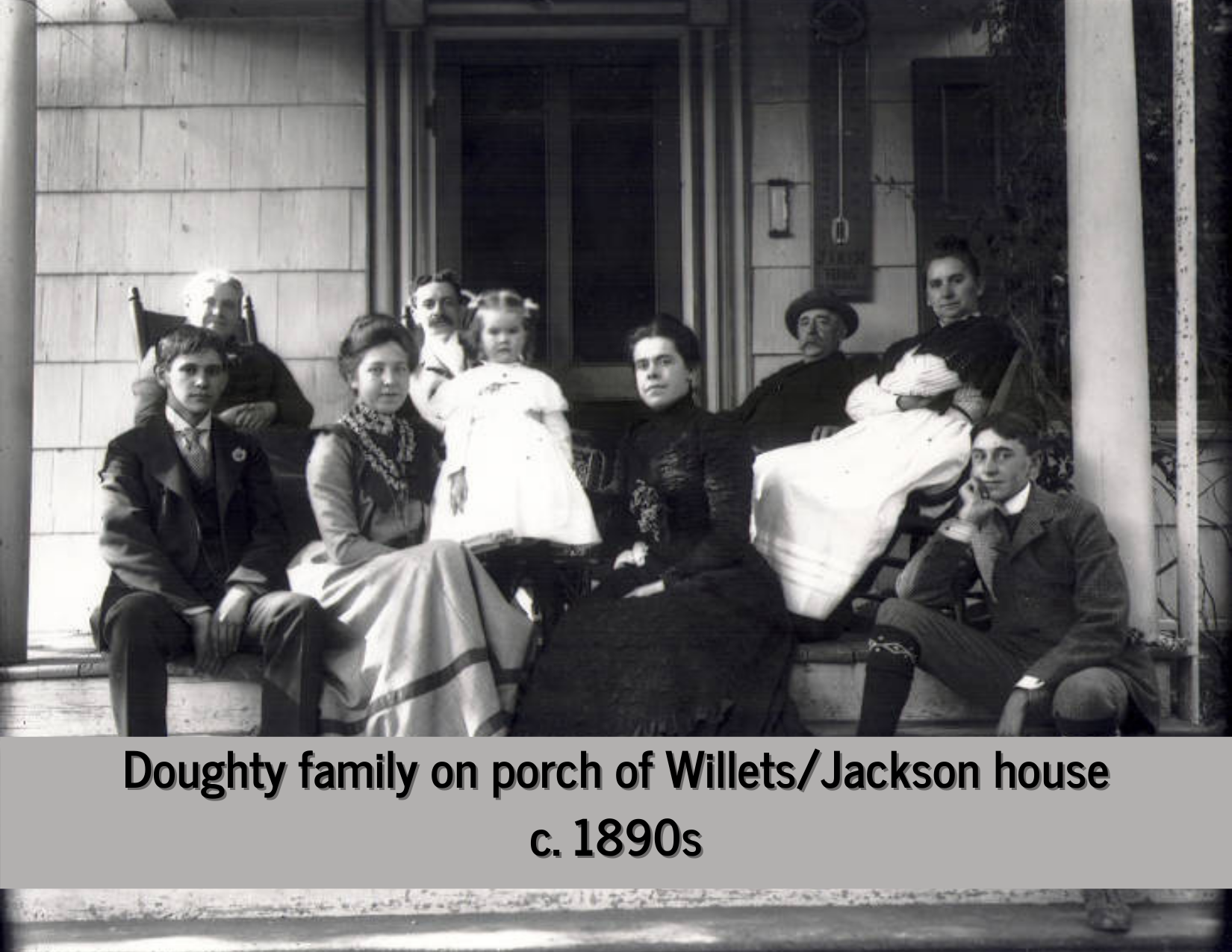 | 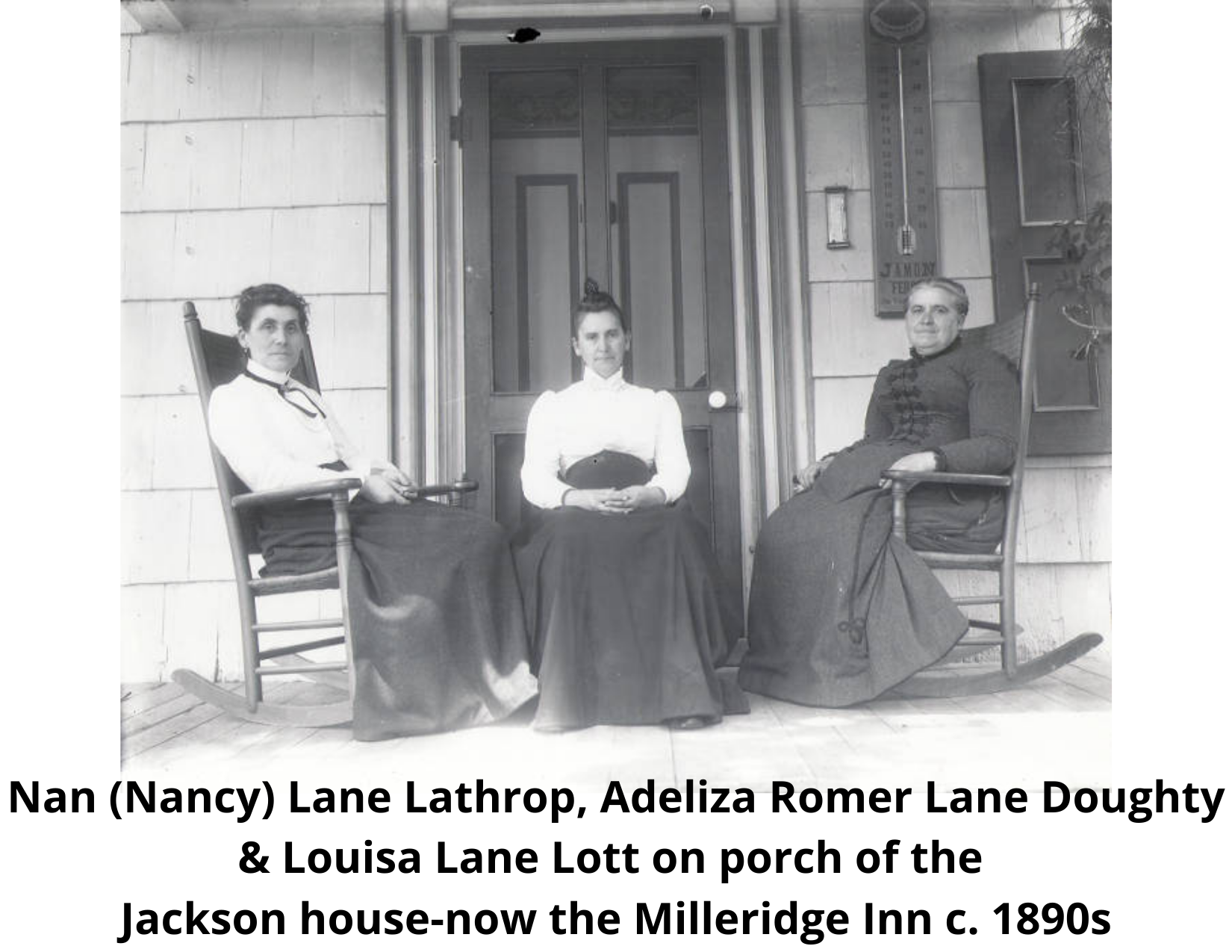 | 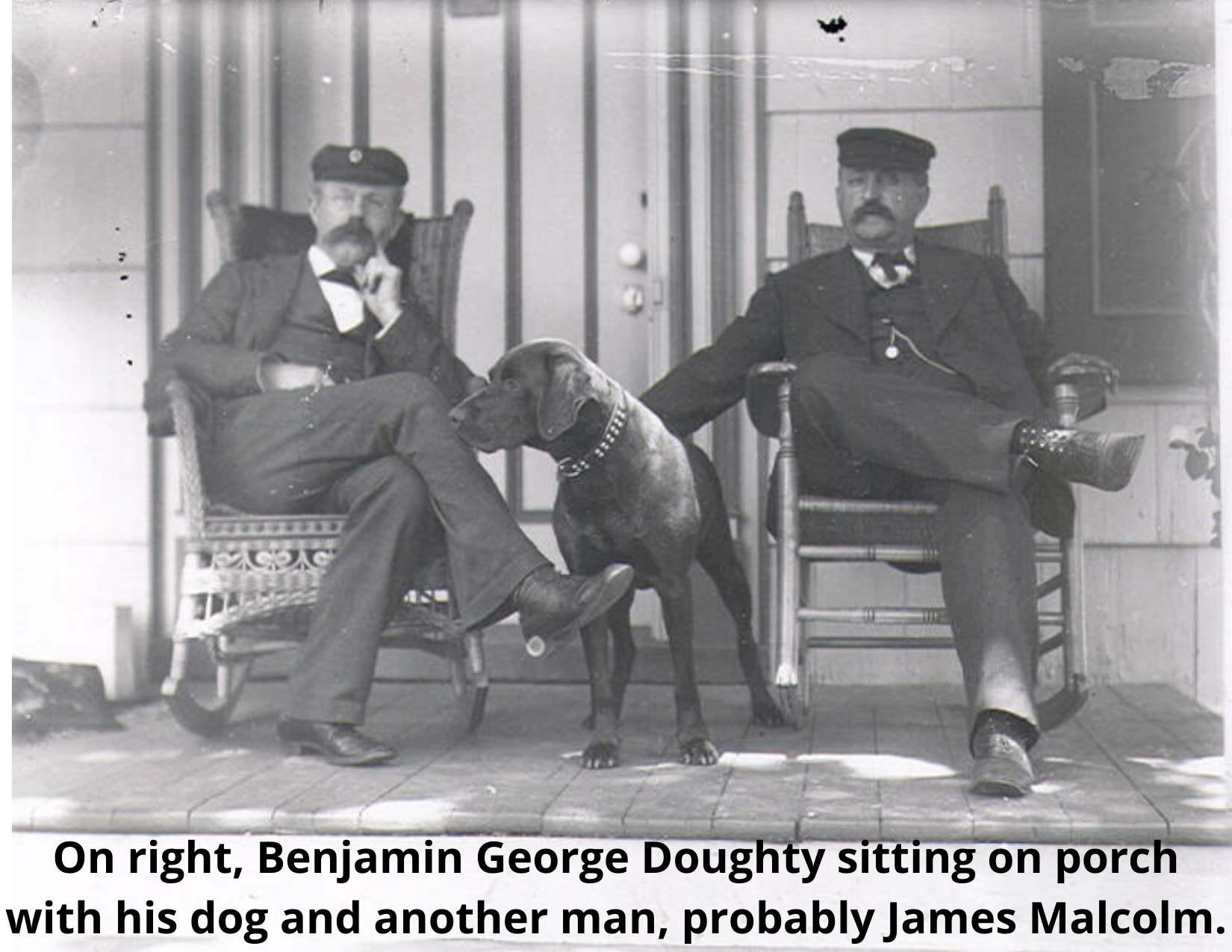 |
Doughty, B. George (1917-1999) = son of John Bodine Doughty and the last member of the Doughty family to own the Jericho Cider Mill. George was born in Jericho. George was born in Jericho. His family lived in the Willets/Jackson house that is now the Milleridge Inn while their new house on (Rte. 106) the Oyster Bay Road was being built. George married Marie and had 2 daughters, Becky and Lydia. He worked for Republic Aviation Corp as well as owning the cider mill. He sold the Jericho Cider Mill to John Zulkofske around 1938. When he retired he and Marie moved to St. Augustine, Florida in 1969. After George died, his family moved to North Carolina in 2000. His daughter, Lydia Doughty Delrossi is now in Aiken, SC. His other daughter, Becky Doughty died on May 26, 2017 from injuries she suffered in a bad car accident the previous December. She left a son, Jon Eli Ortiz.
Doughty, Doris Anna (1924-2003) = daughter of John B. and Anna W. Doughty, sister of George and Jean M. Doughty. Seen in Jericho School Class photo of 1936/37. Doris married Thomas F. Cullen. They had a son, Benjamin T. Cullen (1969-1977). They are buried in LI National Cemetery, E. Farmingdale, NY.
Doughty, John Bodine (1873-1953) = the only child of Benjamin George and Adeliza Romer Lane Doughty. John graduated from Columbia University as a Civil Engineer in 1906 and married Anna Augusta Wright in Jan, 1914. Children = Benjamin George Doughty (1917-1999), Doris Anna Doughty Cullen in 1925, Jean Doughty Davis in 1927.
Dutch Reformed Church (1732- ) = See: Brookville Reformed Church
E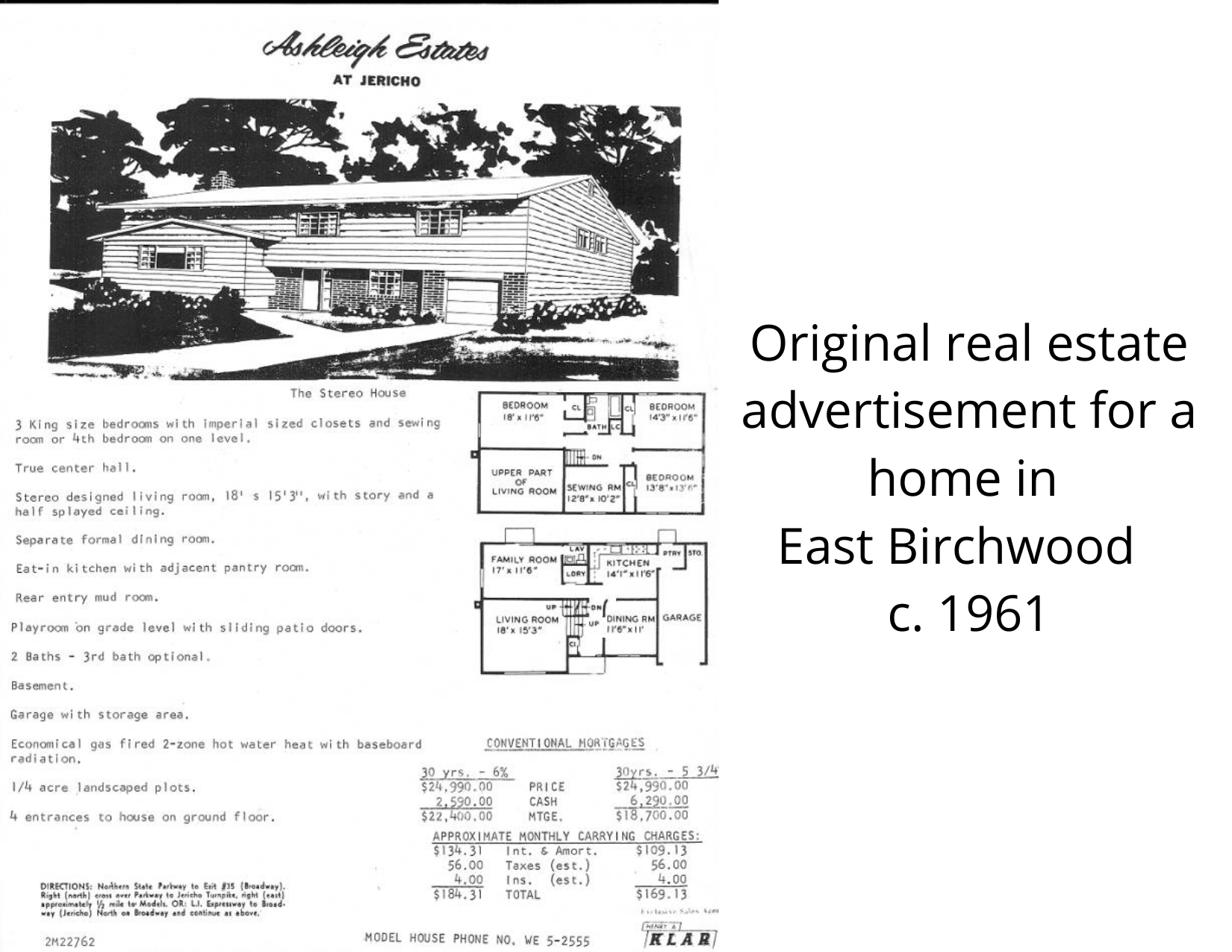
East Birchwood = The first large real estate development in Jericho with 1,350 square foot, split-level and ranch styles houses built in the 1950s, lying east of Broadway (Rte. 106-107) and south of Jericho Turnpike.
East Birchwood - Model House Names = The Birchwood, the Capri, the Continental, the Eldorado, the Hollywood, the Jericho, the Majestic Riviera and the Savoy.
Ellison, Jacob = served as Jericho’s 6th Postmaster from 1841 to 1844.
Emory, Esther Jackson Hicks (Nov. 1902-June 2004) = Esther was the daughter of Henry Hicks (1870-1954) and Caroline Jackson Hicks. Her father owned and operated Hicks Nurseries in Westbury. She graduated from Friends Academy and Swarthmore College. Esther was a teacher and librarian. She married John Martin Groome Emory (1899-1966) [son of George Searing Emory and Hannah Woodnutt Emory] in 1929 in a Friends' ceremony at her parents' home. They had three children; David Lloyd in 1930, John in 1933, and Margaret Emory c.1943. Margaret married Christopher Stackpole in 1973. Margaret left some papers to the JPL archives in 2018. In her later years, Esther Hicks Emory lived in a cedar shingle house on the grounds of Hicks Nursery. She donated many items to our archives. Esther retired to a home in Gwynedd, PA where she passed away in 2004. They are both buried in East Cemetery, Litchfield Connecticut. See: Esther Hicks Emory Collection
F
Fairhaven Nursery = (c. 1950s-1970) A local nursery located on the south of the LI Expressway near Fairhaven Apartments and a Robert Hall Clothing store.
Ficken, Lewis (1842-1897) = a cabinet maker, carpenter and farmer, possibly born in Hanover, Germany. He married Mary Ann Malcolm in New York City in 1839. They had 2 girls Mary Ann and Emma and two boys, George and Martin who was apprenticed to a blacksmith in 1870. Lewis donated some of his land to build the AME Zion Church on Rte. 106 in 1871. He died in 1897 and the executor of his estate was James Malcolm.
Fielitz, Ralph (1915-?) = Jericho Fire Chief, 1957 to 1959.
Fire Chiefs of Jericho = see list on page 96 of “Jericho, the History of a Long Island Hamlet” book. Recent chiefs not listed are: David Ginzburg, 2011; Carl Johnson, Jr, 2013; John Lottes, 2015; Steven Cohen, 2017.
Fire Commissioners = First Commissioners in charge of the Jericho Fire District in 1933 were Frank Borley, Percy Remsen, James Hewlett, Frank Humphreys and Alex Robertson
Fire Department (March 23, 1933 to present) = George (“Lott”) and Martin Halleran met with Daniel Underhill, Frank Tappan, Percy Remsen, Jack Robinson, George Jackson, Drs. William and Arthur Malcolm, Frank Borley and Ray Broome to create a Jericho Fire Department. They had collected money to buy an old garage owned by Frank Curth. Ray Broome was elected the first Fire Chief and Ernie Page was hired to be live-in custodian and dispatcher. The new firemen became certified in 1934 and Mrs. Burrill donated her old Simplex touring car to be converted to a hose truck.
Firehouses = In 1933 the first Firehouse was established in Frank Curth’s (originally Maltby’s) old garage on the northwest corner of Jericho Turnpike and the Hicksville Oyster Bay Road (aka Broadway). In 1958 a 2nd modern red-brick Firehouse was built at 411 N. Broadway. A substation later went up at 680 Cantiague Rock Road and in 2007 an ultra-modern firehouse opened at 424 N. Broadway.
Flicken, Lewis = donated land to build the AME Zion Church on Rte. 106 in 1871. He died in 1897.
"Fort Nonsense" = an alleged British Fort in Jericho, circa 1776, probably a fortified farmhouse on the Townsend/Jackson/Malcolm property. It was probably called “Fort Nonsense” by the locals because of the lack of danger from the Quaker community.
Fox, George (1624-1691) = an English “Dissenter” and founding father of the Society of Friends or Quakers. In 1640 he went on a spiritual quest and came to believe that the presence of God was found in people not in churches. He preached God talked directly to people and they could talk directly to God. Fox traveled to the New World from 1671 to 1673, preaching and helping to establish organized group systems of Friends.
Freeman, Catherine, See: Trukafka, Catherine F. (1915-1999) = the 17th Jericho Postmaster/Postmistress from 1935 to 1953.
Freeman, Michael = father of Catherine, he served as Jericho’s 16th Postmaster from 1934 to 1935. He was succeeded by his married daughter, Catherine Freeman Trukafka.
Friends Academy (1876 - present) = founded in 1876 by Gideon Frost in Locust Valley as a school of secondary education for Quakers and “likeminded people.” It welcomes children of all races and creeds. Many Quaker children from Jericho attended this school. The Marion Jackson house was moved to the campus in the 1960s to become a museum, but is now being used as office space.
Friends Meeting House, Jericho = built with the help of Elias Hicks in 1787 on one acre and 20 rods of land bought from Benjamin and William Wright north of the Spring Pond. The Meeting House is still in use today. It lies southeast of Old Jericho Turnpike and north of (new) Jericho Turnpike. A wooden frame, cedar shingle building measuring 36 feet by 33 feet, 2 story with two entrances – one for women and one for men. The Elders sat on a “facing bench” in front and slightly above the congregation with a public gallery in the loft above. Iron stoves at each side kept them warm. An open sided large wagon shed (80 feet long) north of the building was for the horses and buggies. It was also used for horse trading on other days.
Friends School, Jericho (1793-1870) = built in 1793 as a small schoolhouse on the grounds of the Jericho Quaker Meeting House. Elias Hicks served as a member of the Jericho Quaker School Committee for two decades and even filled in when a teacher couldn't be found for the job. About 35 pupils paid 6 pence per day for tuition. Teachers were paid $200 to $250 per year and probably boarded locally. Lessons were very serious, and pupils were on their best behavior. Quaker books were used exclusively to promote piety. The school stayed active up to 1870 when the children attended the new Jericho Public school on the Oyster Bay Road (Rte. 106). The school building was later converted into the caretakers' cottage.
Friends, Society of = also called Quakers. Majority of the founding families of Jericho were members of this faith and have a viable Meeting House in Jericho.
G
Gaines, Edith (1933-??) = authority on Quaker practice and a Curatorial Consultant, who worked at the Sands Point Preserve. She wrote The Charity Society 1794-1994; history of the Charity Society of Jericho and Westbury Friends Monthly Meetings, 1994 LI Coll. Ref. #289.6 G
Gaines, Winnie (1919-2001) = former president of the West Birchwood Civic Association.
Gary, Elbert H. (1846-1927) and Emma Townsend Gary (1876-1934) = a lawyer and judge, he later became the founder and Chairman of U.S. Steel. He married Julia E. Graves and had two daughters, Gertrude and Bertha. After she died, Graves married Emma T. Townsend in 1905. He left a very large estate in Jericho called "Ivy Hall."
George A. Jackson Elementary School (1957-present) = The 3rd public elementary school on Maytime Drive, Jericho. It was named for School Board member and prominent Quaker family member George Ancel Jackson.
George A. Jackson. See: Jackson, George A.
Gilberg, Glenn (1947- ) = a Village Drive, Jericho resident who was the first member of the Jericho Rescue Company to serve as Fire Chief from 2009 - 2010. He is a certified Physician's Assistant and Paramedic.
Ginzburg, David (1966-) = Jericho resident, graduate of JHS in 1984, who served as Fire Chief 2000-2001 and 2011-2012.
Greenspan, Walter (1945-2012) = Born in Brooklyn, Walter was a Commodities Analyst, a resident of Jericho and the father of twin daughters. He was known by all as an amateur Cartologist and had an article published in The Long Island Historical Journal: Fall 2004, Vol. 17 No. 1-2 titled, You're Not Where You Think You Are - LI Place Names and Postal Zones. He died at age 66 of a sudden illness.
Grillo, Joseph and Grillo, Joseph J., Jr. = Jericho residents, Grillo Sr. was Fire Chief from 1969 to 1971 and his son served as Fire Chief in 1996.
Guinea Town/Woods = a freed black people’s settlement in the Westbury area believed to have been between the present LIE Service Road and Hillside Avenue along Glen Cove Road, founded with the assistance of the Jericho/Westbury Friends Society. That north/south road was called “Guinea Town Road” on maps from 1906 to 1927 and Guinea Woods Road on maps in 1939. It is speculated the name came from the large flocks of native guinea hens in the area, or the origins of many Africans -- The Guinea Coast of Africa. The name was changed around 1970 to Glen Cove Road. Older maps showed an "African Meeting House" at this location. It probably was a combination church, school and community center.
Guthe, (or Guthrie) William = the first postmaster in Jericho. He was appointed October 1, 1802, by the US Postmaster General under President Thomas Jefferson, but no documentation was found of official listings of postmaster until the 20th century. The records show he served until March 1813. The Post Office was most likely in the front parlor of his house. No other information found except for one suggestion that his name might in fact have been William Guthrie. No one of either name has been found in the area records of that time.
H
Habeck, Florence (1923-?) = daughter of Frank and Theresa Habeck. Attended Jericho school, as seen in class photo of 1936/37. She had an older sister Lillian, an older brother George and younger brother, Frank. She married William Edwards in 1946.
Habeck, George (1921-2012) = son of Frank and Theresa Habeck, married Dorothy Kosky in 1947. He had a sister Florence Habeck, attended Jericho School, as seen in class photo of 1936-37.
Halleran Brothers Garage = a.k.a. Jericho Garage and later a Mobil Station. The original building was a small blacksmith shop and p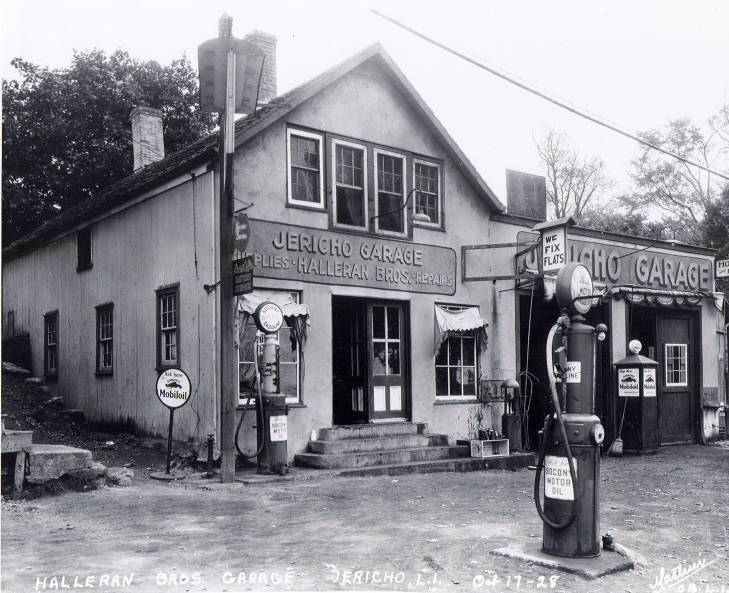 aint store owned by James K. Hicks. After that burned down in 1903 it was replaced by the General Store and a new blacksmith shop with an apartment upstairs run by the Halleran brothers. The blacksmith shop became a garage with the arrival of automobiles, so you could shoe a horse, gas up your automobile and collect your groceries and mail all in one location. In 1928 after Jericho Turnpike was moved south, the garage and General store had to move back south of the new Turnpike where they remained until the late 1950s.
aint store owned by James K. Hicks. After that burned down in 1903 it was replaced by the General Store and a new blacksmith shop with an apartment upstairs run by the Halleran brothers. The blacksmith shop became a garage with the arrival of automobiles, so you could shoe a horse, gas up your automobile and collect your groceries and mail all in one location. In 1928 after Jericho Turnpike was moved south, the garage and General store had to move back south of the new Turnpike where they remained until the late 1950s.
Halleran, Everel (c1898-1972) = married John Lott Halleran. She worked in the Jericho Post Office with her daughter-in-law Signe H. Halleran, wife of Marty.
Halleran, George Harold (c.1935-1996) = nicknamed "Bubby". George was the son of George Copius Halleran and Mary Kennedy Halleran, and brother to Margaret "Peggy" Halleran. "Bubby" married Patricia "Robin" Malloy (1936-2016) in 1960. They built a new house on his parents' property on Old Cedar Swamp Road. Robin taught school in Jericho for many years.
Halleran, George Copius (1892-1953) = son of John O'Halleran and Margaret Copius, he married Mary Kennedy (1898-1937). George served in the military, worked at Liberty Aircraft Corporation and an automotive garage. George and Mary had two children, Margaret and George H. Halleran. Mary served as a member of the Jericho School Board in the 1940s. After George died, she married Michael Horan.
Halleran, John Lott (1889-1962) = son of John and Alvina O'Halleran. He married Everel Mae Becken, (1898-1972). They had four children: John B., Lillian E, Marjorie B., and Raymond H. They lived over the garage on Jericho Turnpike. Lott and his brothers were original members of the Jericho Fire Department.
Halleran, Margaret (1930- ?) = only daughter of George C. and Mary K. Halleran. "Peggy" had a younger brother, George Jr. She married -- Gallo, a test pilot for Grumman who was killed in a crash in the c. 1948. They had a daughter Patricia.
Halleran, Martin Julius Sr. (1899- 1968) = "Marty" married Anna Beatrice Jacobus (1901-1999). They had two boys, Martin Julius Jr. and Edward. “Marty Sr.” drove the Jericho school bus and worked at the Jericho Garage with his brothers George and Lott. The Halleran men were all members of the original Jericho Fire Department. Mrs. Halleran, or "Bea," worked as a clerk in the Post Office and was president of the Women's Christian Temperance Union of Hicksville.
Halleran, Martin Julius, Jr. “Marty” (1930-1995) = married Signe Hopp Halleran on Dec. 29, 1951. Son of Martin J. Sr. and Anna Beatrice Halleran. They lived near his parents at 26A Jericho Turnpike. Marty was a member of the Jericho Fire Department, Nassau Police Department and an accomplished artist.
Halleran, Melba Louise (1930? - 20??) = daughter of Martin J. Halleran, Sr., Melba graduated from Westbury High School in 1959. Melba married Richard M. Neville in 1966. They live in Connecticut.
Halleran, Patricia "Robin" Molloy (1938-2016) = married George "Bubby" Halleran (1927-1966). "Robin" was the kindergarten teacher at Jackson Elementary School for more than 25 years.
Halleran, Signe C. Hopp (1934-1972) = was the daughter of Anders and Anna Hopp, the caretakers on the estate of Charles Leonard. In 1951, Signe married Marty Halleran, Jr. She worked in the Jericho Post Office as Catherine Freeman Trukafka’s assistant when the Post Office was still located in the General Store. In July 1953 she was appointed Postmaster, the youngest in Nassau County, and oversaw the building of the new brick post office in the shopping center next to Waldbaum’s Supermarket, now Whole Foods market.
Hally, Robert T. (1964-) = graduated from Jericho High School about 1981. He served as Jericho Fire Chief from 1992 to 1993.
The Hamlet = gated condo community built in 1982 with upscale private homes. It is located on the north service road of the LIE west of the office building complex and west of Broadway.
Hamlet East = phase two of the Hamlet condo community located on Jericho Turnpike
Hartigan, Margaret J. (1915-1998) see: Wolf, Margaret Hartigan
Healey, William = well known in the community, “Bill” was the first mailman to personally deliver mail to homes in Jericho in the 1950s.
Heron, Douglas G. (c.1950 -) = Jericho resident, from 1984 to 2002. Doug served as Fire Chief from 1990 to1991 and 1994 to 1995.
Hicksite Schism = occurred about 1800. It was so-called because Elias Hicks preached against changes demanded by the opposing members. It began after an outbreak of revivalism that brought liberal and conservative groups within the same church into conflict. Three trends developed in the Society of Friends; 1. A continuity of the Quietists’ views with an emphasis on the Inner Light; 2. A rationalistic interpretation of the Bible; and 3. An Evangelical awakening of the earlier Quakers who opposed the other two. This conflict wasn’t resolved for more than one hundred years.
Hicks Cider Mill = see: Jericho Cider Mills
Hicks, Caroline Underhill Jackson (1872-1978) = daughter of Soloman S. and Esther L Jackson, she attended Swarthmore College and married Henry Hicks (1870-1954) in 1900. "Carrie" was the mother of Esther Hicks Emory and Edwin W. Hicks. She lived on the grounds of Hicks Nursery in a cedar shingle house until her death. She is buried in the Westbury Friends Burying Ground with her husband, Henry Hicks.
Hicks, Elias (March 19, 1748-Febuary 27,1830) = one of 6 sons of John and Martha Smith Hicks, Elias became Jericho’s famous Quaker preacher. His great-great grandfather John Hicks came from England to Hempstead in 1640. His great-grandfather Thomas was Sheriff and Judge in Queens County. Grandfather Jacob Hicks was Captain of the Militia. Elias married Jemima Seaman (1750-1829) in 1771 at the Westbury Meeting House. She was the daughter of Jonathan and Elizabeth Willis Seaman of Jericho. The young couple moved to Jericho to help her parents and grandparents, John and Abigail Willis. Elias and Jemima had eleven children in all. All of their boys died young probably from a genetic disease such as Muscular Dystrophy, which left 5 living daughters (2 others died early). Elias embarked on religious missions from 1779 to the end of his life. He was instrumental in getting a Friends Meeting House built in Jericho, and a small school on the property where he occasionally taught. He preached against slavery and fought so hard for abolition that he is credited with getting New York State freed of slavery before other states. He preached against the schism within the Society of Friends believing in complete freedom of worship when others wanted to set more rules. See: Elias Hicks, Quaker Liberal, by Bliss Forbush. [Bio Hicks] See also: The Hicksite Separation, by Doherty [289.7245]
Hicks, Elias/Jonathan Seaman House = A typical Long Island farmhouse – not larger than most. Jonathan Seaman probably built the house at the time of his marriage to Elizabeth Willis in 1740. Jonathan, third generation descendant of Cap’t. John Seaman, farmed 75 acres and owned a tannery across the road. It consisted of a bark mill, a bark house and shop with a natural spring pond at the back to provide water necessary for the curing of hides. Jonathan Seaman and his wife Elizabeth had one daughter, Jemima, and three sons who all died at an early age. A few months after Jemima married Elias Hicks in 1771 the Seamans invited the young couple to come to live in Jericho and help with the farm. The grandparents, John and Abigail Willis, also lived there with three slaves. Jonathan, Elizabeth and grandfather, John, all died of an illness in 1777, leaving the property to their daughter Jemima and son-in-law Elias Hicks. They lived in the house until Jemima died in 1829 and Elias in 1830.
The next owners of the house and remaining land were James C. Haviland, Samuel J. Underhill, Isaac S. Ketcham, William Laurie, William Jagger, Jr., Francis F. Laurie, Elias Hicks Seaman, James H. Seaman, Anna Seaman, Frederick M. Selchow, Henry Willets Underhill, and lastly, Lester D. Arstark. The house and the remaining small piece of land was then purchased by Nassau County to become part of the Jericho Historic Preserve as it is known today.
Hicks, Hannah (1825-1916) = married Stephen Hicks in 1846. They had six children. In 1851 she joined the Charity Society of Jericho and Westbury (founded in 1794) as one of the first female members. Their mission statement was written, “to help improve the condition of the poor among the black people…”.
Hicks, Isaac (1815-1900) = son of John D. and Sarah Rushmore Hicks. He married Mary F. Willis and started Hicks Nursery, Westbury in 1853.
Hicks, James Knox (1845-1920) = son of James and Hannah Tappan Hicks, married Martha Russell in 1869. They had five children. After her death he married Mary Jane Weeks in 1885 but she died in 1886. In 1888 he married Annie Elizabeth Lawrence. James was the "village blacksmith" until his building burned down in 1903. He was appointed as Jericho’s 13th Postmaster from 1899 and served for 16 years until 1915. He is buried in Jericho Friends Burying Ground.
Hicks, Jemima Seaman (1750-1829) = daughter of Jonathan and Elizabeth Willis Seaman and wife of Elias Hicks. Jemima was the mother of eleven children, of whom only 4 girls survived.
Hicks, John J. (1834-1928) = a Jericho farmer, John was proud to say he voted for Abraham Lincoln. He opened a cider mill about 1877 on the Oyster Bay Road (Rte. 106) and made sweet cider, apple cider vinegar and pickles. His nephew, Harry Tappen (1892-1937) inherited the mill after John's death. He modernized it with electricity and ran it until his death in 1938. He is buried in the Jericho Quaker Burying ground. His property was bought by John Zulkofske.
Hicks, Martha (1771-1862) = Eldest daughter of Elias and Jemima Hicks, Martha married Royal Aldrich in 1792 and lived in a home her father built for them nearby.
Hicks, Rachel Seaman (1789-1878) = daughter of Gideon and Elizabeth Seaman, Rachel married Abraham Hicks in 1815. He was a nephew of Elias Hicks who died young in 1827. She also lost two of her three children. She found a calling to the Quaker ministry in the late 1830s and began to travel to other Quaker Meetings to preach, in the same manner as Elias Hicks had done earlier.
Hicks, Roy (1869-1960) = son of James Knox Hicks and Martha W. Hicks, he was the owner/operator of Jericho’s General Store and Jericho’s Postmaster from 1915-1920 with the Post Office located in his store. He succeeded his father who was Postmaster from 1899 to 1915. He was married to Myrta M. They had a son Everett R. and a daughter Dorothy. When he retired he moved to San Diego, California where he is buried.
Hicks, Valentine (1782-1850) = the fourth son of Samuel and Phebe Hicks. A successful businessman working in NYC 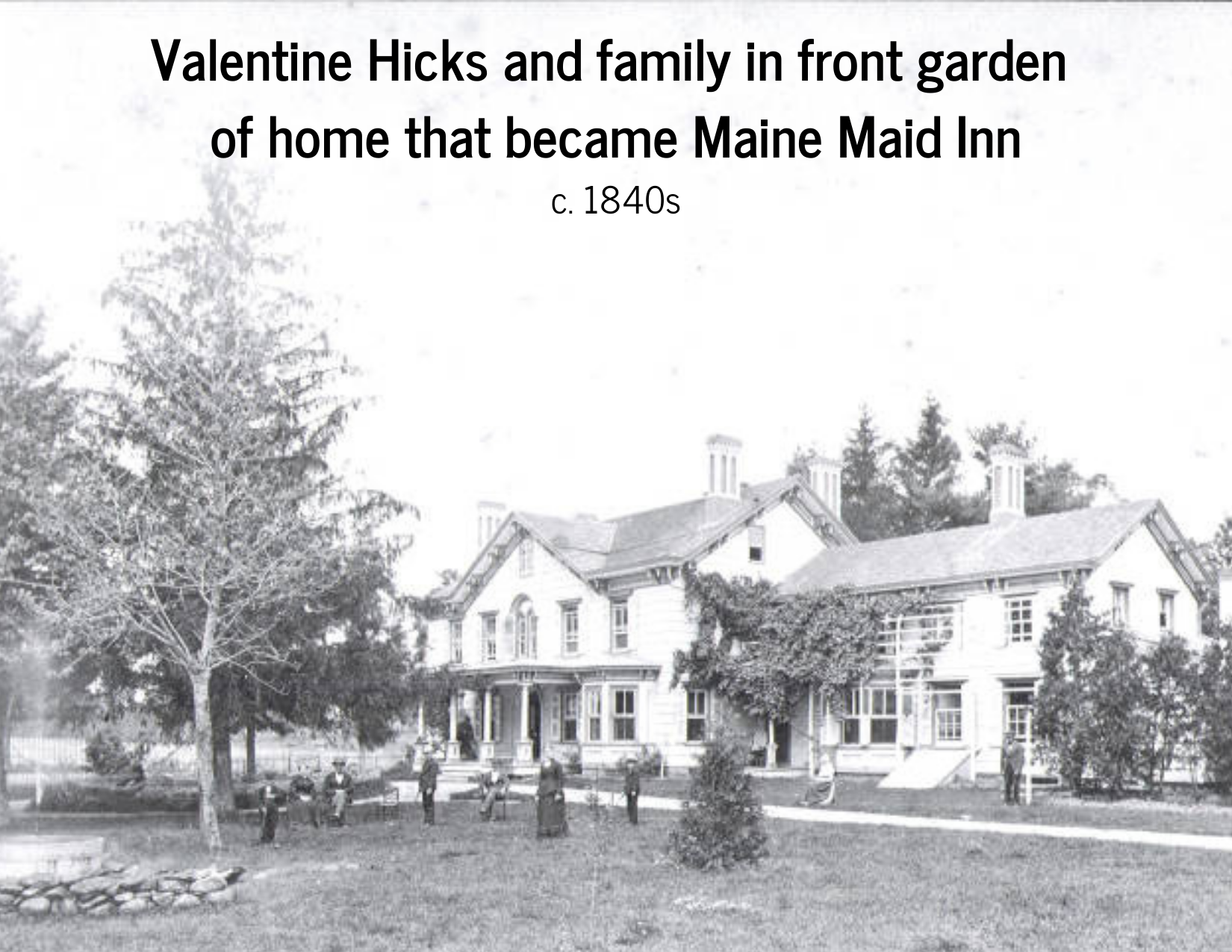 for his brother Isaac, he retired in 1810 with savings of over $50,000, which he deemed to be sufficient money for anyone. He married his second cousin, Abigail Hicks in 1804 and they moved to Jericho in 1814 with their 4 daughters. Their son Elias was born in 1815 in Jericho. They purchased the former Timothy Tredwell house across the road from Elias and Jemima Hicks. Valentine served as Jericho’s 4th Postmaster from 1826-1839 and accompanied Elias on his religious tours which covered over 2,000 miles and many activities. Valentine also became one of the officers of the Long Island Railroad Company and served as its second president in 1837 and 1838. With his brothers-in-law Robert and David Seaman he formed a development company named the Hicksville Association. After the financial panic of 1837, work stopped at the terminus of the railroad. When work finally resumed the area was named Hicksville to honor Valentine Hicks and his contribution to the area. He died at the home of his son-in-law Dr. William Seaman on March 5, 1850. Valentine’s property was sold to Samuel J. Underhill and was inherited by his daughter Phebe Seaman and her husband Elias Hicks Seaman in 1867. They lived in the 17-room house until their deaths in 1905. The property was inherited by their son, James Hicks Seaman, who owned it until 1912. It had a succession of owners, including H.H. Boyce and Mrs. Elvira Bayer until it was purchased by Percy L. Roberts and became the Maine Maid Inn in 1950.
for his brother Isaac, he retired in 1810 with savings of over $50,000, which he deemed to be sufficient money for anyone. He married his second cousin, Abigail Hicks in 1804 and they moved to Jericho in 1814 with their 4 daughters. Their son Elias was born in 1815 in Jericho. They purchased the former Timothy Tredwell house across the road from Elias and Jemima Hicks. Valentine served as Jericho’s 4th Postmaster from 1826-1839 and accompanied Elias on his religious tours which covered over 2,000 miles and many activities. Valentine also became one of the officers of the Long Island Railroad Company and served as its second president in 1837 and 1838. With his brothers-in-law Robert and David Seaman he formed a development company named the Hicksville Association. After the financial panic of 1837, work stopped at the terminus of the railroad. When work finally resumed the area was named Hicksville to honor Valentine Hicks and his contribution to the area. He died at the home of his son-in-law Dr. William Seaman on March 5, 1850. Valentine’s property was sold to Samuel J. Underhill and was inherited by his daughter Phebe Seaman and her husband Elias Hicks Seaman in 1867. They lived in the 17-room house until their deaths in 1905. The property was inherited by their son, James Hicks Seaman, who owned it until 1912. It had a succession of owners, including H.H. Boyce and Mrs. Elvira Bayer until it was purchased by Percy L. Roberts and became the Maine Maid Inn in 1950.
Hicksite Schism = occurred about 1800. It was so-called because Elias Hicks preached against changes demanded by the opposing members. It began after an outbreak of revivalism that brought liberal and conservative groups within the same church into conflict. Three trends developed in the Society of Friends; 1. a continuity of the Queitists' views with an emphasis on the Inner Light; 2. a rationalistic interpretation of the Bible; and 3. an Evangelical awakening of the earlier Quakers who opposed the other two. This conflict wasn't resolved for more than one hundred years.
Hicksville = an area named for Valentine Hicks, second president of the L.I. Railroad and credited for bringing the railroad east to this terminal at the time. Valentine had bought a large parcel of land here with his brothers-in-law in 1835 as a land development company, named the Hicksville Association.
"Highpool" = (1926-1959) the estate home built in 1926 in the French manor style for William Deering Howe on 19 acres. In 1941, he married his second wife, Elizabeth B. Shevlin. They had a son Richard Howe. After William died, Elizabeth married Russell Rutherfurd. Lutheran High School bought the home from the Rutherford estate in 1959.
Historic Preserve, Jericho (1972-today) = a 20 acre preserve created by Nassau County Legislature, under Ralph Caso, in 1972 after the destruction of Jericho Corners by the New York State Department Of Transportation. By Jericho Corners we are talking about the commercial area at the intersection of Jericho Turnpike and Routes 106/107. This is where the Fire House, General Store, Post Office, Hobby Horse Antiques Shop, a barber shop, Halleran’s Garage and several homes and barns were situated. The Historic Preserve, unknown to many residents unfortunately, is located on the north side of Jericho Turnpike, just east of Route 106. It consists of several historic homes; the Ketcham’s, the Seaman/Hicks’ and the Jackson/Malcolm’s along with the Malcolm barns. These houses have been preserved with landmark status and are listed on the NY Register of Historic Places. The Preserve does not include the home of Valentine Hicks which had been converted to the Maine Maid Inn, a successful commercial restaurant at the time. It also does not take in the Jericho Quaker Meeting House and School House/Caretakers cottage because it is owned by the Society of Friends. All the buildings in the Preserve are original and are still standing on their original foundations after more than 300 years. See: Jericho the History of a Long Island Hamlet, JPL [974.7245J] for more information
Hobby Horse Antique Shop = originally the home of Royal Aldrich and his wife Martha Hicks Aldrich and family, it became an antique shop in the 1940-50s. The house was built with the aid of Elias Hicks for his daughter in 1792. Elias also partnered with Aldrich in a tannery for many years. When Jericho Turnpike was moved in 1929 the house became an Antique shop. See also: JPL LI Coll. photo album
Hoogland, Wihelmus (c.1740-1778) = son of Dutch settlers, Abraham "Hoaglant" and Annatje Duryea in the Village of Wheatley that was back then part of the Town of Oyster Bay. He married Maria Hegeman in 1760. They had five children. He died in today's area called "Upper Brookville."
House names = names of the model homes in East Birchwood, see: East Birchwood
Houses of Worship =
See: AME Zion Church,
See: Jericho Jewish Center,
See: Jericho Friends Meeting House,
See: St. Paul the Apostle RC Catholic Church,
See: Temple Beth Torah,
See: Temple Or-Elohim
Howe, Richard Flint (1863-1943) = Richard, a sportsman, was born in Wisconsin and graduated from Harvard in 1884. In 1898, he married Abigail, "Abby," M. Deering (1867-1906), daughter of William Deering, the founder of Deering Harvester Company and later International Harvester Co. Richard and Abby were parents of William Deering Howe (1900-19480. In 1915 Richard built "Linden Hill" in Brookville. In 1926, his son William built "Highpool" on the northern part of the property. Richard died in Aiken, South Carolina, his winter home. He and Abby are buried in Locust Valley. About 1970, a portion of the property was sold to become Tam O'Shanter Country Club and "Highpool" became LI Lutheran High School. Linden Hill burned to the ground shortly after.
Howe, William Deering (1900-1948) = The son of Richard F. Howe, William was the heir to the Deering Harvester fortune. He married Polly Brooks in 1921 and built Highpool on Tappentown Road in 1926-27. They had three daughters. He was the first mayor of Brookville. They divorced in 1941 and he married Elizabeth Brite Shevlin and had a son Richard Deering Howe. After Deering died, Elizabeth married Russell Rutherfurd.
Humann, Richard A. = served as the 25th Jericho postmaster from 1944-1999. He attended Hicksville High School and played soccer.
Humphreys, Frank (c.1878-1960?) = Jericho resident and one of the first Fire Commissioners as well as serving as Fire Chief 1937-1938. See: framed photo in JPL archives
Humphreys, William (1915-2001) = son of Frank Humphreys and member of the original Jericho Fire Department. He lived on Henry Street south of the Northern State Parkway. See: framed photo in JPL archives.
Huschle, David, (1931-2015) = manager/owner from 1963 to 1978 of the Maine Maid Inn. David lived in East Norwich 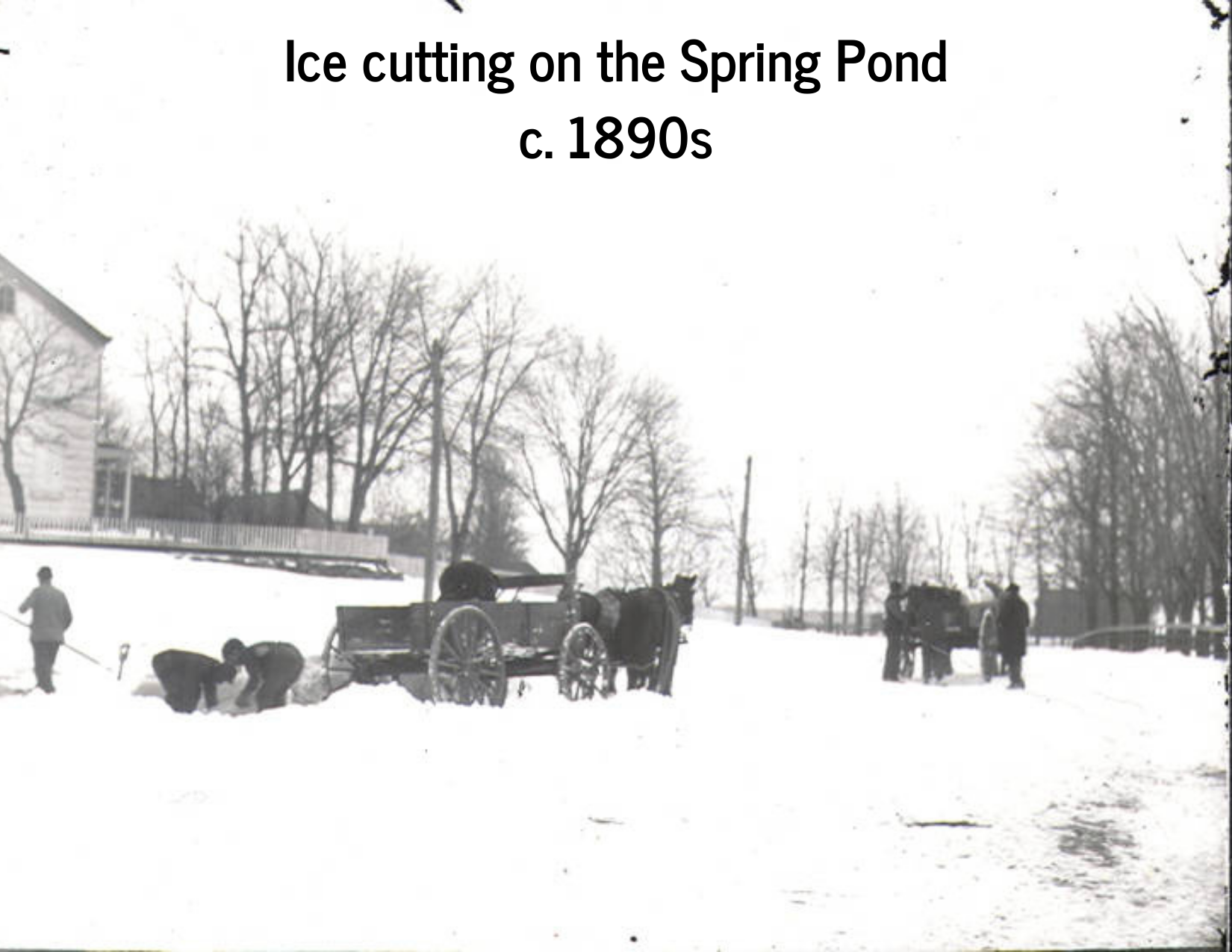 and Shelter Island, NY.
and Shelter Island, NY.
I
Ice Cutting = a common procedure on the Spring Pond in Jericho before refrigeration was available within the home. Large blocks of ice were cut by hand from ponds, lakes and other bodies of water, hauled by horse and wagon and kept in a pit or a wooden “icehouse” for family food storage.
Icehouses = wooden houses or dirt caves used to store blocks of ice to be used in the warm weather to keep food from spoiling before electric refrigeration was invented.
Ivy Hall = built in 1904 for Ralph J. and Elizabeth Preston on the north side of Jericho Turnpike. It was sold to James B. Taylor in 1906. In 1920, the estate was sold to Elbert H. Gary, a founder and Chairman of U.S. Steel. The house was demolished in 1950.
J
Jackson, Ancel Titus (1845- 1918) = son of Solomon Seaman Jackson and Annie Smithson Titus. He married Abigail Jackson around 1868. They had Gertrude, George A., Lillie, Ancel (1884-1890) and Annie Titus Jackson. They are all buried in the Jericho Friends Burying Ground.
Jackson, Annie Titus (1873-1953) = daughter of Ancel and Abigail (Abbie) Jackson. Annie married a cousin, Matthew Franklin Jackson on October 10, 1894. But M. Franklin, as he was known, unfortunately died on November 3, 1895 at age 25. They had one daughter, Marion Frances Jackson. Annie and her daughter lived in a house on Broadway (Rte.106-107) with her brother George Ancel Jackson.
Jackson, Caroline Underhill = see Hicks, Caroline U. Jackson (1872-1978)
Jackson Farm = a horse farm owned by the Stanley Jackson Family off Route 106 in Muttontown.
Jackson, George Ancel (Mar 1882-Oct 1946) = son of Ancel T. and Abigail Jackson, members of a large Quaker family in Jericho. George worked as a banker in NYC. He never married and later lived with his sister Annie Titus Jackson, the widow of M. Franklin Jackson and his niece, Marion. George later served as treasurer of the Jericho Public Schools. An elementary school on Maytime Drive, in East Birchwood was named for him in 1957.
Jackson, John (1733-1821) = a Quaker, son of John Jackson and Kesia Mott, and great grandson of Robert Jackson, one of the original settlers of Hempstead. John married Charity Tredwell in 1756. They had 4 children. After her death he married Margaret Wright Townsend and they had 5 more children, including Obadiah. In 1790, he bought Dr. James Tounsend's property on Old Jericho Tpke. John died at age 88 and is buried in the Jericho Friends' Burial Ground. His great-granddaughter, Phebe married James Malcolm and the property became known as the Malcolm House and is part of the Jericho Historic Preserve.
Jackson, Marion Frances (1895-1982) = daughter of M. Franklin and Annie Jackson, Marion lived in the family house on Broadway in Jericho with her mother, Annie and her uncle, George A. Jackson and aunt, Gertrude Jackson. She never married. After her death, the family home was landmarked and moved to the Friends Academy grounds in the 1960s. She wrote an article on the Jericho Quakers for the LI Forum magazine.
Jackson, Mathew Franklin (1870-1895) = son of Sidney and Caroline Robbins Jackson. He went by the name M. Franklin Jackson. He married Annie Titus Jackson (daughter of Ancel T. and Abbie [Abigail] Jackson) in 1894. He was the father of Marion Jackson, but died at age 25 just before she was born.
Jackson, Obadiah (1774 -1853) = Oldest son of John and Margaret Townsend Jackson. Obadiah married Elizabeth Wright. After her death he married Rachel Underhill (daughter of Adonijah Underhill) in1804. They had William M. (1806-1866) who married Sarah (Sally) Tappan (1807-1885) in 1833. In 1804, John Jackson deeded the property to Obadiah. In August of 1816 the barn was burned by Gilbert Covert who was sent to prison for ten years. A second barn was constructed then, so we know it dates from that year. The property was inherited by the oldest of Obadiah’s sons, William Jackson. Obadiah is buried in the Jericho Friends Burying Ground.
Jackson, Phebe Tappan (1803-1889) = daughter of George and Elizabeth Duryea, she married Jacob Jackson. They had three children; Henry Willis Jackson, Sidney Wheeler Jackson and Mary S. Willis Jackson. Phebe is buried in the Jericho Friends Burying Ground.
Jackson, Rachel = See: Underhill, Rachel Jackson
Jackson, Richard (1640-) = of Southold, married Agnes Washburne, whose sister, Sarah, was married to Robert Williams.
Jackson, Robert (1620-1685) = son of Richard Jackson and Isabella Maltby, Robert married Agnes Washburne (1628-?) in 1645. They lived in Hempstead and had 4 children, John, Samuel, Sarah and Martha. Their son John married Elisabeth Seaman and Samuel married Ruth. As for Robert's daughters; Martha married Nathaniel Coles and daughter Sarah married Nathaniel Moore.
Jackson, Sidney W. (1838-1910) = son of Jacob and Phebe Jackson married Caroline Robbins, daughter of Matthew Franklin and Hannah S. Robbins. Their son, M. Franklin married Annie Titus Jackson.
Jackson, Solomon Seaman (1817-1905) = son of Solomon and Mary, Solomon married Annie Titus. They had five children. After her death in 1865 he married Esther L. Post in 1867. They had a daughter, Caroline Underhill Jackson (1872-?). She married Henry Hicks in 1900.
Jackson, William (1806-1866) = the son of Obadiah Jackson, married Sarah (Sally) Tappan and they had one daughter Phebe. Phebe married James Malcolm whose family had emigrated from Scotland in 1804.
Jackson III, Stanley (c. 1980- ) = Muttontown and Oyster Bay historian. Son of Jane T. and Stanley Jackson, Jr., he graduated from Cornell University. He owns Stantiques and Collectible, Inc.
Jagger, William (1824-1890) = son of David and Maria Jagger, born in Brooklyn, married Margaret Ketcham (1821-1870),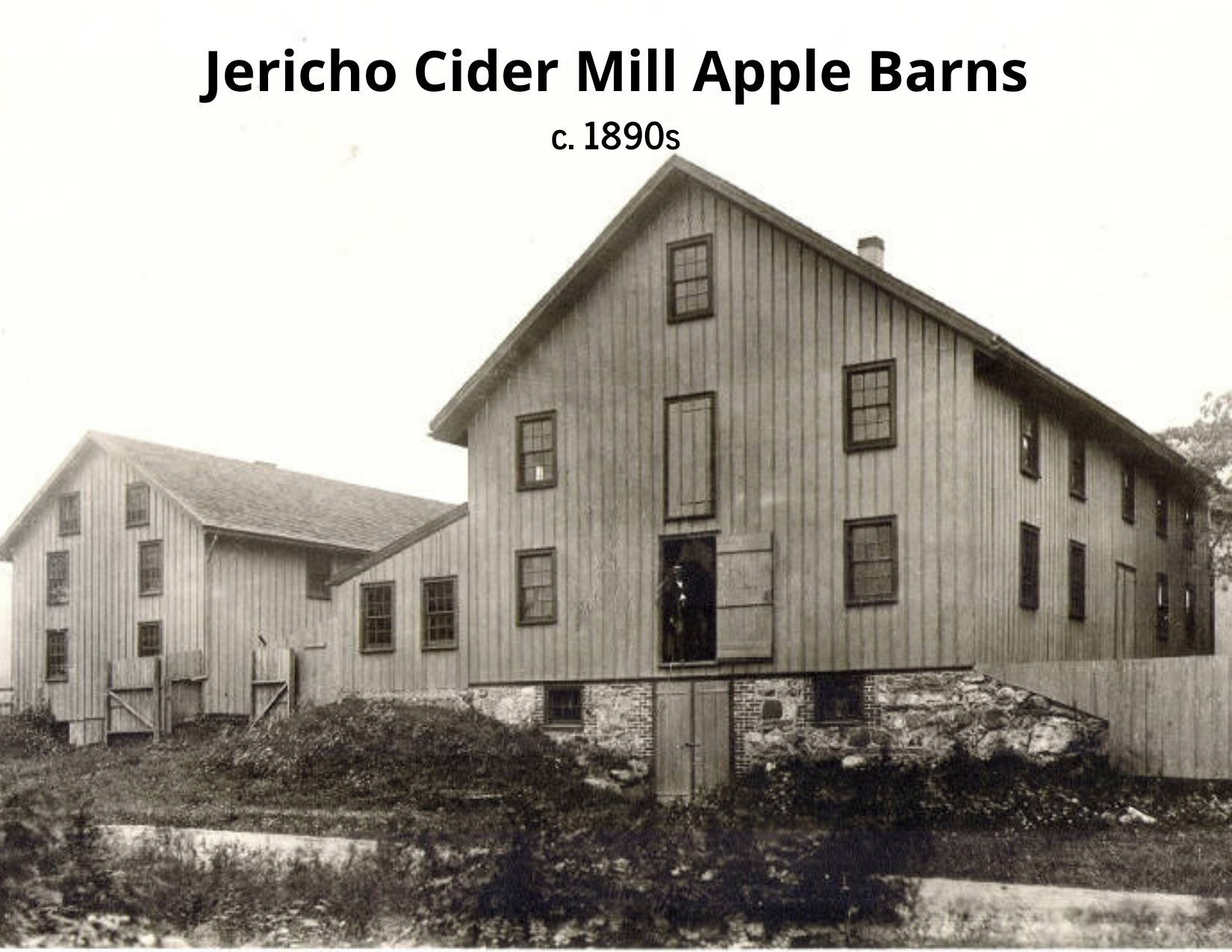 daughter of John and Rebecca in 1851. They had two daughters. He partnered with brother-in-law Isaac Ketcham in the Jericho Cider Mill. When Margaret died, he married Mary Elizabeth Seaman in 1871. See also: Jericho Cider Mills.
daughter of John and Rebecca in 1851. They had two daughters. He partnered with brother-in-law Isaac Ketcham in the Jericho Cider Mill. When Margaret died, he married Mary Elizabeth Seaman in 1871. See also: Jericho Cider Mills.
Jericho Cider Mills (c.1800s to date) = what is known as The Jericho Cider Mill had probably been an existing cider mill for some time before the Quaker gentleman, Isaac Ketcham bought the mill in 1860 when he moved a bit west down the turnpike into Jericho. Back then it was called the Ketcham & Jagger Cider Mill because he ran it with his brother-in- law, William Jagger. After Jagger died in 1890, Ketcham sold the mill and business to Benjamin George Doughty, a Quaker from Brooklyn who moved to Jericho. The Doughty family rented the Jackson house (now Milleridge Inn) until they could build a home just north of the cider mill on the Oyster Bay Road (Rte. 106) where it stands today. Benjamin Doughty made sweet cider from russet apples as well as a world-famous alcoholic champagne cider which came to a halt during Prohibition. That secret champagne process died with Benjamin Doughty. His son, John Bodine Doughy and then his grandson, George B. Doughty owned the Jericho Cider Mill until 1938 when he sold it to John Zulkofske. Around 1977, the Jericho Cider Mill was taken over by his son, George Zulkofske who ran it quite successfully for many years with the lp of his family and right-hand man, Joe Esposito. George became ill and sold it to a local fellow fireman, Ted Ketsoglou just before he died in 2016. Ted's son, Kerry is the general manager.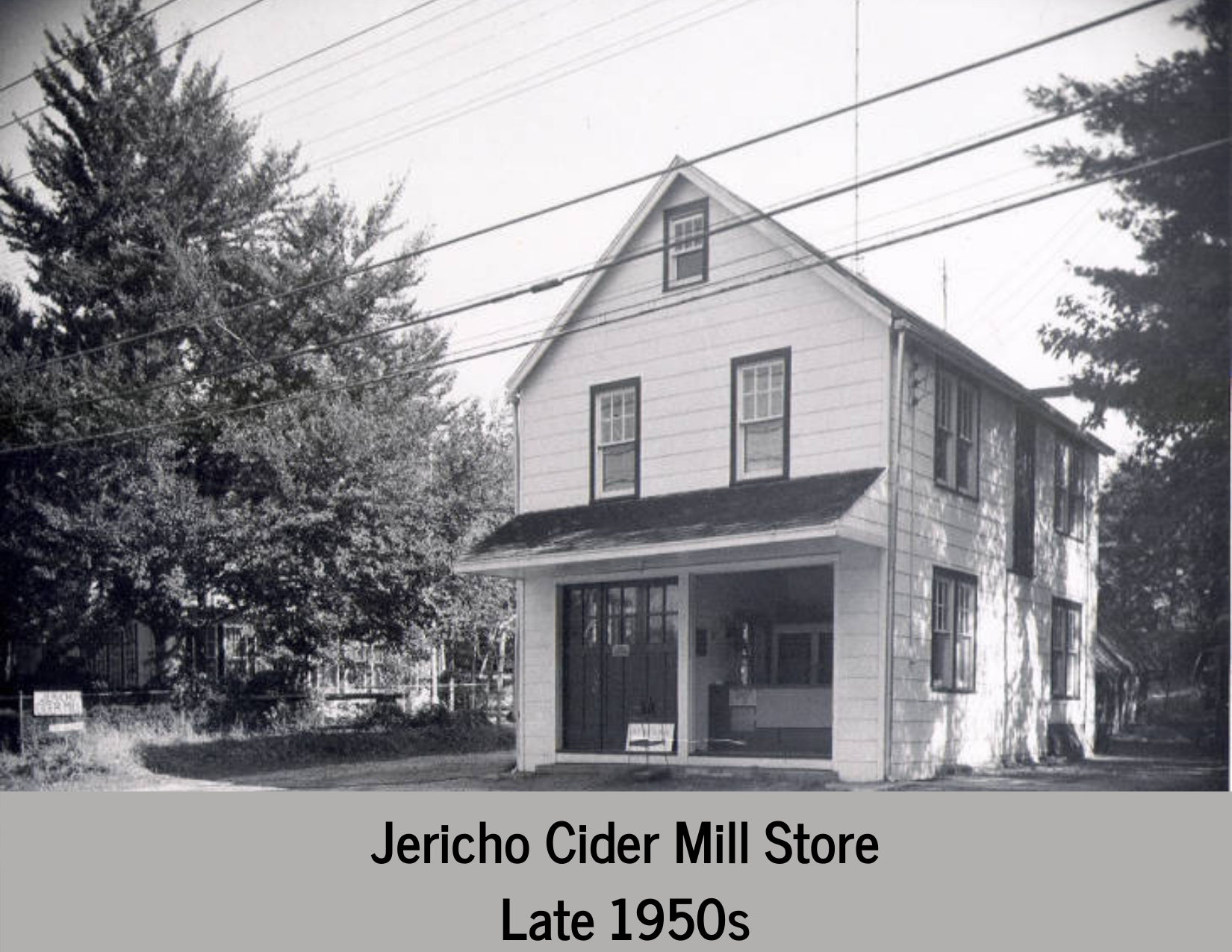
There was a second apple cider mill just to the south on the Oyster Bay Road (Rte. 106) which was opened about 1875 by John J. Hicks. He made cider vinegar as well as cider. That mill was handed down to a grandson, Harry Tappan who installed electric apple presses. In 1938, when Tappan died, John Zulkofske bought both cider mills and combined them into the single operation which we see today.
Jericho Farm = name of M. S. Burrill estate. It was sold out of the family and in 1953 it became the Meadowbrook Country Club.
Jericho Friends Burying Ground = this is the name originally given to Quaker cemeteries, but is not so common today. The Jericho Quaker (or Friends) Burying Ground has been in use since 1790 and has about four hundred graves today. Originally it was not deemed proper to mark the graves with an ornamental stone, but it was finally decided to be a necessity to mark the locations of the graves. Elias and Jemima Hicks’ tombstones have quite probably been moved from their original locations. The burials and grave locations have now been documented to the best possible accuracy. See: The Quaker Cemetery at Jericho, NY, 2002. JPL, LI Coll. [R 925.5 H]
Jericho Friends Meeting House and School House (1788- present) = To get their own Meeting House in 1787 members of the Jericho Preparative Meeting voted to build a house 36 feet by 33 feet, costing 300 pounds. The committee was Fry Willis, Elias Hicks, Adonijah Underhill, William Jones, John Willis, Edmund Willis, Thomas Willets and Jacob Willets. Their petition was approved on May 17, 1787 and the building was probably completed in 1788. In 1792 a Quaker schoolhouse was built near the front gate. Used for many years, until the Jericho Public School was established, today it serves as the caretaker’s cottage. In 1818 a porch was added on the south side to provide shelter from the elements at the two entrances. Iron stoves were added later to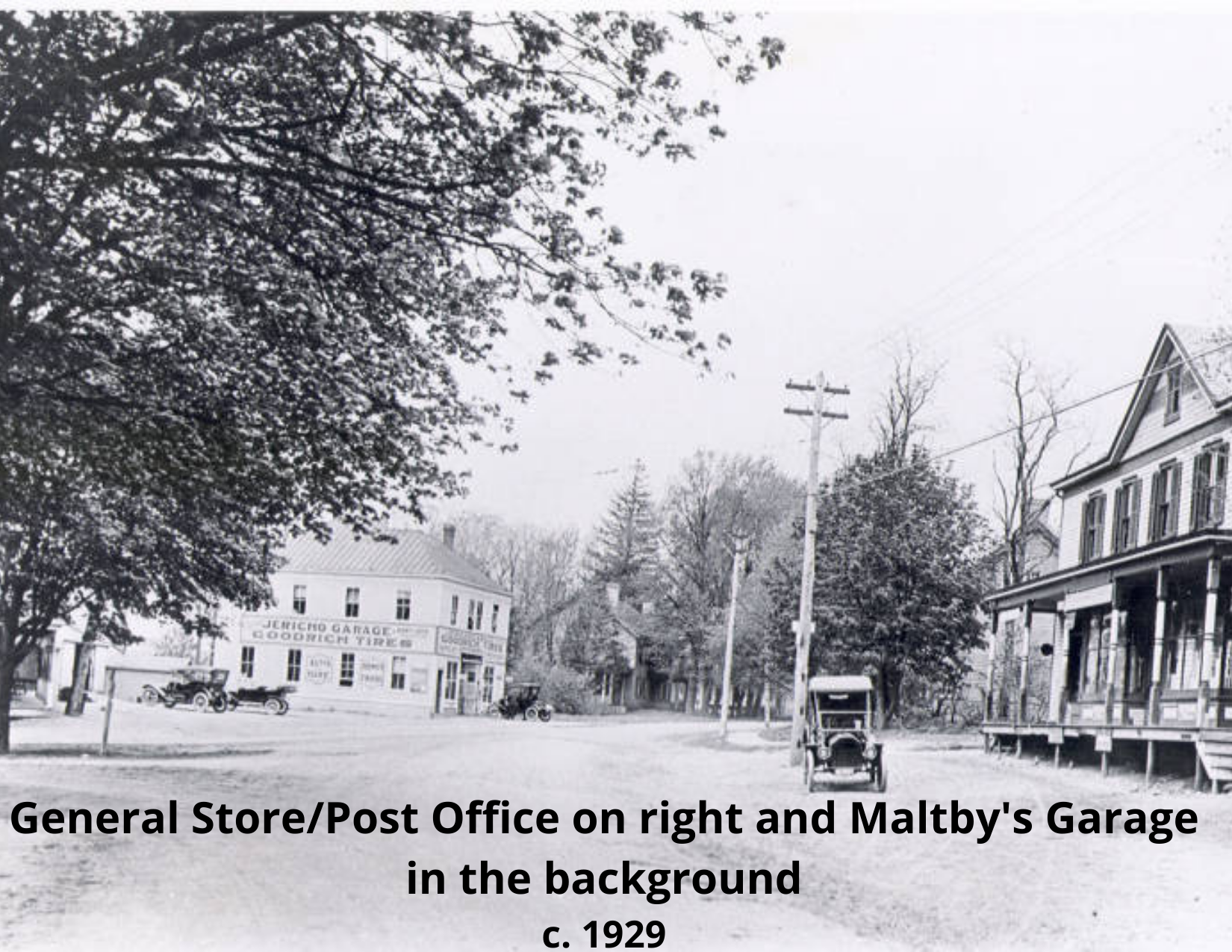 provide heat in the Meeting House and a horse and wagon shed was built near the road.
provide heat in the Meeting House and a horse and wagon shed was built near the road.
Jericho General Store = George Tappan was the proprietor of the first documented General Store in Jericho in 1859. His store was a simple wing built on his house which was located just north of where Jericho Turnpike crossed Broadway. For the very first time the Jericho Post Office was moved from a private home into the General Store where it would be located for the next one hundred years. In 1895, the General Store/Post Office, owned by Augustus Remsen burned to the ground. In 1897, Samuel J. Underhill built a new grocery store with his partners, Roy Hicks and Irving Place at the intersection of Jericho Turnpike and Broadway. This building became Jericho's General Store/Post Office for the next 60 years. It was the hub of the community where people came for provisions, gossip and their mail. If someone didn't show up for several days another person would check on their well-being. Roy Hicks was the proprietor and Postmaster from 1915 to 1920. Percy Remsen took over the store in 1920. He managed it until 1943. After WWII, Sosnow and Schwartz, developers of East Birchwood, built a shopping center on Broadway with a Walbaum's supermarket and a free-standing, new red brick Post Office next door. The old General Store, most of the commercial buildings and some homes were demolished in the late 1950's for the road widening project on Route 106/107, marking the end of an era in Jericho.
Jericho Garage = See: Halleran's Garage
Jericho Historic Preserve (1972 - to date) = See: Historic Preserve, Jericho
Jericho Hotel = See: Powell’s Hotel
"Jericho House" = the original name of the home built on Jericho Turnpike by George Edward Kent, Sr. in 1913. A "Classical Revival" style mansion, it sat on 98 acres landscaped by Olmstead. The architect of the house was W. W. Bosworth, and the landscape was done by Olmstead. The legal clash between Kent and his contractor is still a case study for Law students today. See also = Kent, George Edward.
Jericho Jewish Center (1955 – today) = located at 430 North Broadway, Jericho. It is the oldest and largest c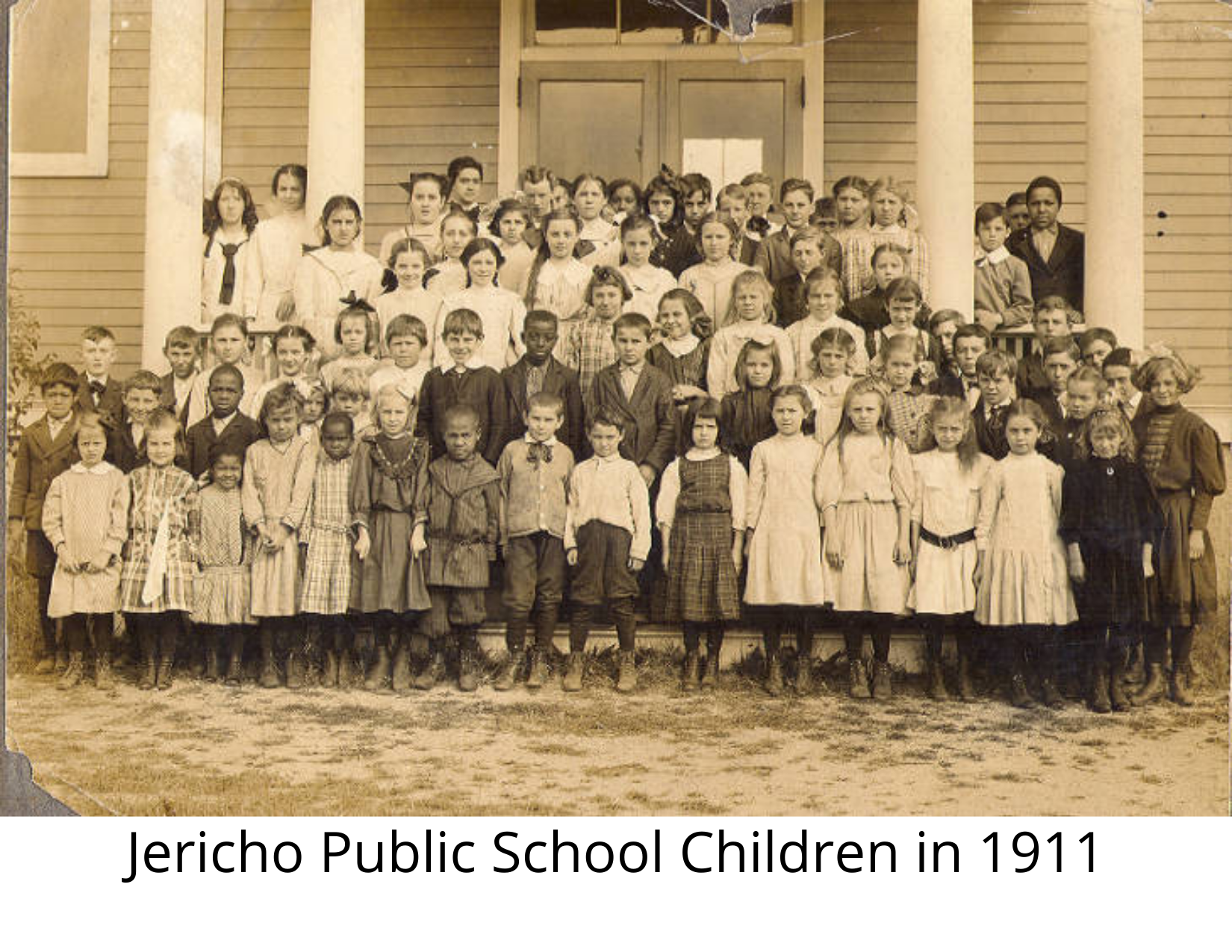 onservative synagogue in Jericho, founded in 1955. Charles Widlitz was the first president and Jack Grazi was the first Rabbi and Cantor.
onservative synagogue in Jericho, founded in 1955. Charles Widlitz was the first president and Jack Grazi was the first Rabbi and Cantor.
Jericho Middle and High Schools = This large school campus evolved from the 8-room brick elementary school built on this site in 1938. That brick building had been built directly behind the second Jericho Public School on Cedar Swamp Road that had been condemned by NY State as a fire trap because it was a 2-story, wooden frame building and had no fire escapes. By 1951 the enrollment in this 8-room grade school had doubled. Pupils upon graduation went to Hicksville, Westbury or Friends Academy for High School. More elementary schools were built in Jericho to accommodate the growing enrollment. In 1956 Hicksville announced they would no longer accept High School students from Jericho so plans for their own High School began with an addition of a ninth grade to the Robert Seaman School. It took three years to convert the Cedar Swamp School into a Middle School and a High School. The expansion cost more than $3 million dollars and the campus comprised 42 rooms on 15 acres. It went through another expansion in 2002 and has been named one of the top High Schools in America.
Jericho – name = Jericho is a hamlet located in the town of Oyster Bay in Nassau County. It was “founded” in 1648 when Robert Williams, of Hempstead “purchased” nine square miles of land from the Native Americans. To verify his ownership Robert actually lived in Jericho and convinced his widowed sister-in-law, Mary Washburne Willets, to settle here as well. The area was called the “Williams Plantation,” “Lewsum,” “Lusum,” “The Farms,” and “Springfield” or the “Springs,” at various times and in assorted documents. The name Jericho was made official in 1692 making it one of the 4 “Bible” towns of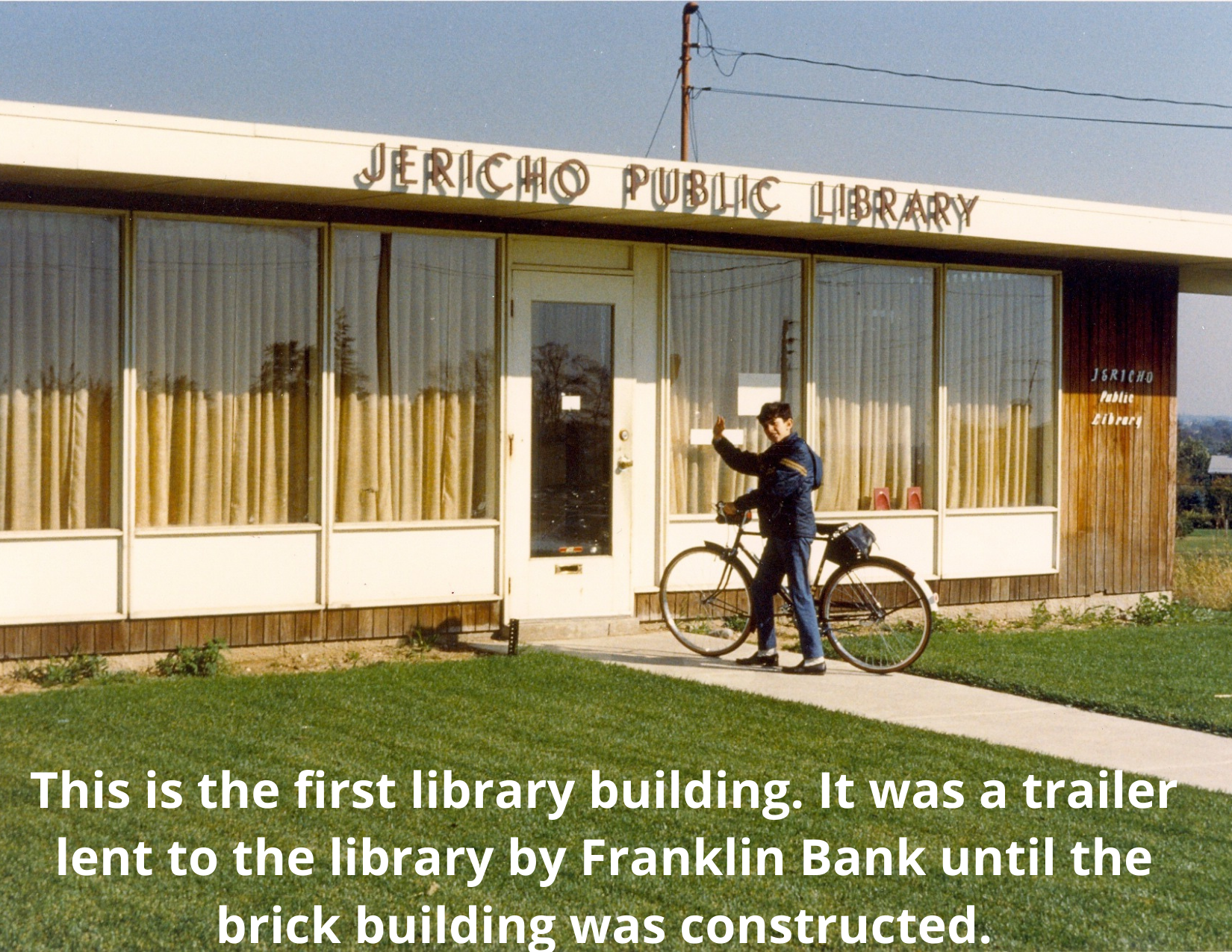 Long Island – along with Bethpage, Babylon and Jerusalem, now called Wantagh.
Long Island – along with Bethpage, Babylon and Jerusalem, now called Wantagh.
Jericho Park District = there are 46.68 acres of parks in Jericho.
- Birchwood at Jericho (East Birchwood) Maytime Dr. & Merry La. =1.80 acres
- Birchwood at Jericho (E, Birchwood) Merry La. & Hazelwood Dr. =5.30 acres
- Westbury Heath (West Jericho) Hillary-Mindy & Bruces La. =0.83 acres
- White Birch at Hicksville (S. Jericho) Kay St. off McCarthy's La. =0.93 acres
- Susan Park (West Jericho) Chapel Road =0.32 acres
- Princeton Park (Oakwood-Princeton Park) N. Marginal Road =5.54 acres
- Birchwood Park (West Birchwood) Chenango Drive =5 acres
- Suburban Estates at Jericho (East Birchwood) Fern Drive East =1.96 acres
- Jericho Community Park, Cedar Swamp Road =25 acres
Jericho Plank Road Company = In 1852 the NY State Legislature passed the Plank Road Act. The Jericho Turnpike Corporation reincorporated itself into the Jericho Plank Co. and hired Nelson & Co. to regrade the road with wooden planks. By 1869 it was proclaimed to be the best turnpike in Queens County. A few years later a new corporation was formed and Jericho Turnpike was extended east toward Smithtown. See also: Jericho Turnpike
Jericho Post Office = See: Post Office
Jericho Public Library (1962-to date) = founded in 1965 after the first two propositions were defeated in 1960 and 1961. Ruth S. Lang headed a group of volunteers who got the Jericho School Board to put the referendum to a vote and it passed. Franklin National Bank donated an old modular building to use until land was purchased and a permanent structure was built in 1971. The Absolute Charter was granted in 1970. Dottie Mills was hired as librarian and Director and the new building was dedicated on December 10, 1972. The first Board of Trustees were Morton Thielle, Hy York, Ruth Lang, Florence Irving and Irving James. In 1984-1989 the building was almost doubled in size. By excavating down a new entrance lobby, Meeting Room, Children’s Room, Theater and Technical Services department were added along with custodial and storage space. The driveway no longer went under the building but alongside the southern wall. The catalog cards were replaced by an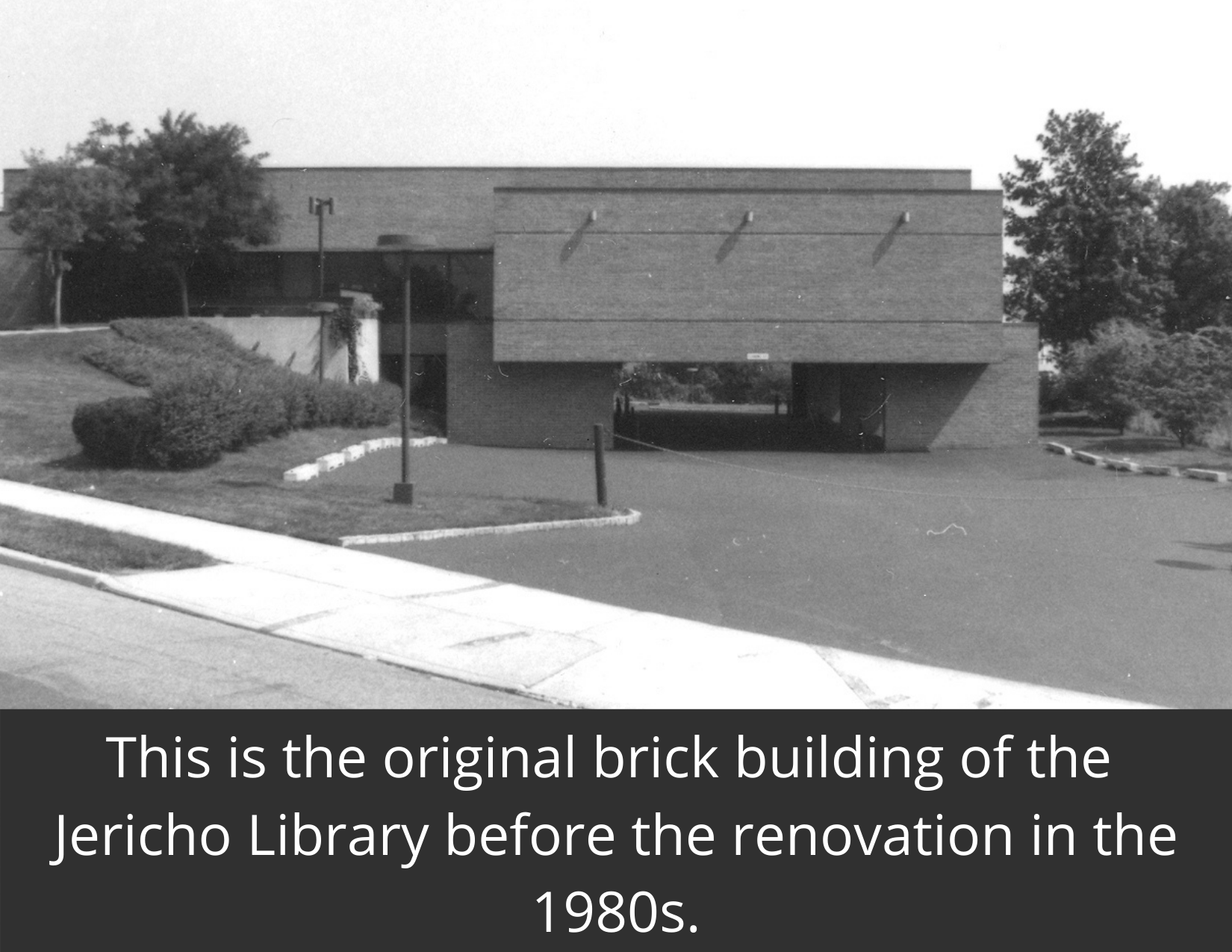 online catalog in 1995, soon followed by personal computers for public use. Today the library, equipped with the latest technology available, offers professional friendly public services, cultural events, children’s and teen events, and programs and meetings for all ages.
online catalog in 1995, soon followed by personal computers for public use. Today the library, equipped with the latest technology available, offers professional friendly public services, cultural events, children’s and teen events, and programs and meetings for all ages.
Jericho Public Schools = the first public school we know about was the 2-room, Jericho Public School was established around 1870, on the west side of the Oyster Bay Road (Rte. 106). In 1907, a new 4-room, 2-story wooden frame school went up on Route 107, Cedar Swamp Road. The third public school was built behind the second school building in 1938/40. It was an 8-room one story brick building. It was added on to in 1952. In 1954, the Robert Seaman Elementary School was built with 16 rooms. In 1957, the George Jackson Elementary School was built with 22 rooms. The High School on Cedar Swamp Road began operations in 1957 with 42 rooms. In 1960 seven rooms were added to the Jackson School and the 16-room Robert Williams School (aka South Parkway School) was built. That was followed, a year later in ’61, by the Cantiague Road Elementary School. In 1977, after a drop in enrollment the Robert Williams School was leased to become the Soloman Schechter Hebrew School. It became another Nassau BOCES School in 2019. See also: individual school names, i.e., Cantiague, Jackson, etc. and Friends School, Jericho.
Jericho Run Farms = 9 1/2 acres left out of the original 160 acres off Brookville Road that belonged to the S.S. Underhill family since 1870, was sold by grandson, Sam Mitchell, to developers in 1999.
Jericho Toll Gate = see: Jericho Turnpike Company-Toll Gates
Jericho Turnpike = the main route from the old Fulton Ferry in Brooklyn, through Jamaica to Jericho. The Turnpike left private hands and was made “public” in 1890. The road was extended to Suffolk County, to the Nissequogue River near Smithtown, around 1875. The dangerous “Death Curve” in Jericho was straightened by building a new road south of the Quaker Meeting House in 1927. The Old Jericho Turnpike road is still there today – a two lane road circling around between the Jericho Quaker Meeting House and the Malcolm property and heading north to Route #106.
Jericho Turnpike Company = incorporated on March 20, 1813, six years after the first 15-mile Jamaica to Rockaway stretch was completed. They charged a toll or user fee to pay for the use and maintenance of the roadway. To build the road, dirt was plowed to the center of the road with ditches for runoff – hence the name “Highway.” Stones were removed and planks were laid where the road was muddy. The Turnpike Company lasted almost to 1890.
Jericho Turnpike (and Motor Parkway) Toll Booths = Turnpikes meant tolls were collected and Toll Booths. It isn't at all clear how these toll booths operated on the original Turnpike. Some were gates where a person with the title "Overseer of Highways" collected a toll and opened the gate. The toll collector lived close to the road. Later there were Toll lodges for a car to drive thru and the toll collector would live in the toll house. Not many of these were built. See: The Toll Lodges of the LI Motor Parkway and their Gatekeepers., by Al Velocci
Jones Fund for the Support of the Poor = In 1836 Samuel Jones, a Quaker and resident of Oyster Bay, Samuel Jones established a $30,000 fund to support the poor and indigent of the town as was a practice of many Quakers. The trust had 5 trustees charged with maintaining a “Poor Farm” in Brookville. In 1914 it was moved to a modern facility in Hicksville, called the Jones Institute. In 1982 it was then moved to Bayville and called Jones Manor on the Sound. The facility was closed in 2015. More information may be found at the Oyster Bay Historical Society at 20 Summit Street in Oyster Bay.
K
Kaplan, Richard (1936-2017) = Kaplan was born in Manhattan. He graduated from William H. Taft High School in the Bronx and in 1958 from NYU. He went into advertising where he met and married Judy Kromash in 1960. They moved to Jericho in 1965 and had 3 sons. Richard became a volunteer fireman in 1966 and soon rose to Captain, from 1969 to 1973 and later from 1989 to 1991. He served as Assistant Fire Chief from 1973 to 1978 and Jericho's Fire Commissioner from 1981 to 1988. He was also an EMT. He retired from the financial industry in 1999 but not the Fire Department. He died in the line of duty in 2019 and has been memorialized on the Roll of Honor at the National Fallen Firefighters Memorial in Emmitsburg, Maryland.
Kaplan, Robert J. = son of Richard Kaplan, honored Jericho Firefighter. He served as Jericho Fire Chief in 1997. After he moved to Syosset, he became Syosset Fire Chief in 2011.
Kardel, Paul = Jericho Fire Chief from 1961-1963. He also served as Jericho Fire Department Chaplin until 1998 when he moved to Colorado.
Kent, George Edward (1860-1954) = son of Andrew and Catherine Kent, George married Lilias Juanita Grace (1874-1954) of Kings Point, the daughter of the mayor of New York City, William R. Grace founder of Grace Lines and a former mayor of NYC. In 1906 he hired architect Wilson Eyre to make plans for a house in Jericho, (the former Munson Morris property built in 1913) but never used those plans. Instead he went with plans by William Welles Bosworth and garden plans by Olmstead. Using contractors Jacobs & Youngs, the house was completed in 1914 and named "Jericho House," but the contractor sued Kent for non-payment of final funds. The suit is still a case for students today. Mr. and Mrs. Kent died within a month of each other in 1954. The house and extensive acreage on both the north and south sides of Jericho Turnpike were inherited by their daughter Lilias Kent Knott Mosley. The house was later sold and demolished. See also: "Jericho House."
Ketcham, Isaac Sherman (1823-1891) = son of John and Rebecca Sherman Ketcham. He was the husband of Mary(?). After her death he married Sarah Mann in 1867. Isaac was totally deaf, according to his daughter Phebe and died from a cold that developed into TB. In 1865 he purchased the Selah Carll house in Jericho from James Malcolm about 1865. Isaac owned the first commercial cider mill in Jericho, the Ketcham & Jagger Cider Mill with his brother-in-law William Jagger. His only living daughter Phebe inherited the property (currently referred to as the Ketcham/McAllister house) but never really lived in the house after her marriage to Henry McAllister of Colorado.
Ketcham, John (1865-1881) =son of David and Jane Seaman Ketcham, father of Isaac Ketcham, husband of Rebecca Sherman (c.1866-1881).
Ketcham/McAllister House = one of the original Quaker homes sitting exactly where it was built in 1816. It is now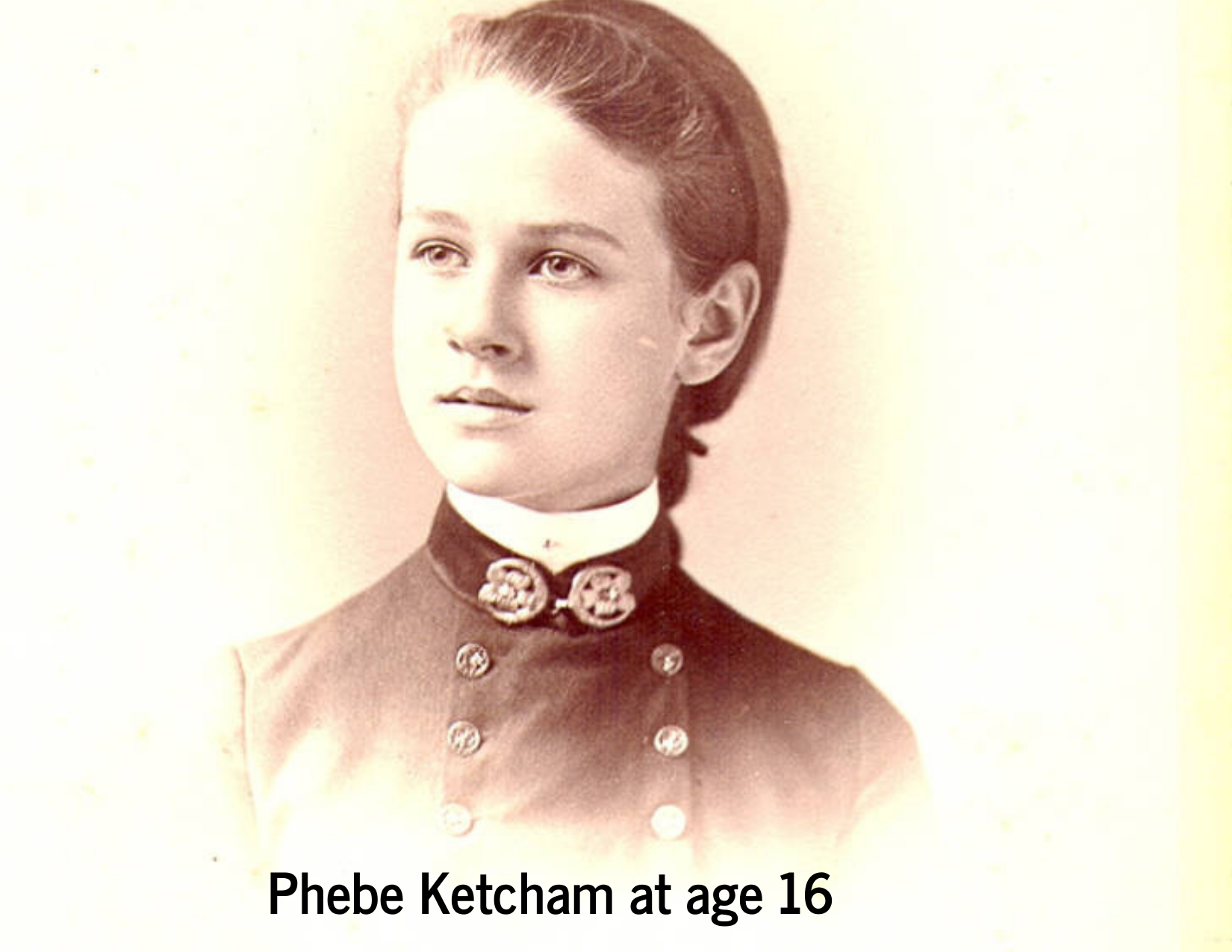 part of the Jericho Historic Preserve. The house was originally built by Dr. Selah Carll for his wife and children. After he died, it was sold to Newbury Sprague in 1859, then to James Malcolm in 1863 and a few years later to Isaac Ketcham. Nassau County purchased the property in 1974.
part of the Jericho Historic Preserve. The house was originally built by Dr. Selah Carll for his wife and children. After he died, it was sold to Newbury Sprague in 1859, then to James Malcolm in 1863 and a few years later to Isaac Ketcham. Nassau County purchased the property in 1974.
Ketcham, Phebe Hallock (1872-1944) = daughter of Isaac and Sarah Mann Ketcham. Phebe graduated from Swarthmore College and married classmate Henry McAllister Jr., a Quaker from Colorado, in 1896 and moved there. She inherited the Ketcham home in Jericho but never really lived there after her marriage. It was rented to various tenants until 1974 when it was sold to Nassau County as part of the Jericho Historic Preserve. Phebe wrote Family Affairs or Go to Jericho, See: JPL, LI Coll. [R B McAllister, Phebe Ketcham. Rare Book] in 1939. Only 2 copies were ever printed.
Ketcham, Rebecca Sherman (1792-1881) = daughter of Isaac and Margaret Sherman, married John Ketcham in 1816 at the Jericho Quaker Meeting. They had 4 children; Phebe 1817, William in 1819, Margaret in 1821 and Isaac Sherman Ketcham in 1823.
Ketcham, Sarah Mann (1832-1906) = daughter of John and Phebe Hallock Mann, second wife of Isaac Sherman Ketcham (1867) mother of Phebe (1872). She had served as a nurse in the Civil War in Virginia.
Ketcham & Jagger Cider Mill = Isaac Ketcham and his brother-in-law William Jagger purchase and run an existing cider mill on the Oyster Bay Road (now Route 106). In 1890, William Jagger died and Isaac sold the business to a Quaker, George Doughty, who had moved from Brooklyn to Jericho with his family.
Ketsoglou, Kerry J. (1990-) = Graduated from Jericho High School in 2004 and NYIT in 2011. He has been with the Jericho Fire Department since 2007. Assistant Fire Chief- Jericho Fire Chief, 2019. Married Brianna MacSaveny, August 28, 2020.
Ketsoglou, Theodore/"Ted" (1959-) = Ted was born in the Bronx and graduated from Fairleigh Dickinson University. He made and distributed ice cream under the name, Silver Crown Ice Cream. He is the co-owner of the Jericho Cider Mill. Ted is married to Emily Moraitakis and had a son, Kerry J. and daughter Paige Vicki Ketsoglou.
Kirby, Amy = See: Post, Amy Kirby (1802-1889)
Knoll, Dorothy (1913-1950) = daughter of Louis Knoll, she taught at Jericho Elementary School in the 1930s, as seen in school photo from about 1936.
Kramer, Albert Ludlow (1878-1948) = was born into a wealthy Philadelphia Quaker family. After he retired from corporate finance in 1916, he had "Picket Farm," built on 88 acres in Jericho in the Federal style. During the 1930s and 40s he wrote 5 books, 2 with his wife Alice. "Picket Farms" bordered the Ambrose Clark estate and became a favorite spot for fox hunting. The estate was next owned by Allan S. Lehman. The mansion sat empty for several years and burned down in 1977. Today the Picket Farm Homeowners Association operates the property as a condominium community with the name Hamlet Corporation.
Kroll, Arthur = Jericho Fire Chief from 1971 to 1973.
Kuhnicke, Edith = was a domestic servant who worked for Mary and Caroline Willits from her late teens. She donated the Willits "huck" towel to the JPL archives.
L
Laimbeer, William (2/23/1875-8/04/1913) = the son of William Elishia Laimbeer (1843-1892) and Maria Josephine Daly (1844-1892). He attended Berkley School and Harvard University (1893-94), but dropped out of school to work in finance at the New York Stock Exchange. At age 27, he married a 39-year-old divorcee, Clara Sutton Stephens Bloodgood (1868-12/5/1907) a Broadway actress who committed suicide in 1907. In 1909, William Laimbeer married Nathalie Pendleton Cutting Schenck Collins, recently divorced from Captain Charles Glen Collins, after the birth of her son, George Morgan Collins. Nathalie and William had two daughters, Nathalie Lee and Josephine Louise They lived in a large home with a windmill in Jericho across from the Cider Mill on Rte. 106. The house is still there but has been recently converted into a multi-family house. The windmill is gone and the remaining property has become an Equestrian Center. In 1913, William Laimbeer and Mr. Osgood Pell were killed in an auto accident. Their children were: George Morgan Laimbeer (1905-1952) [adopted], Nathalie Lee Laimbeer Cornell (1911-1977), Josephine Louise Fell Schiff (1913-2002).
Lang, Ruth S. = one of the founding members of the Jericho Public Library Committee formed in 1961 to get a public library built in Jericho. She also served for many years as a member of the Jericho Library Board of Trustees.
Laudiero, Tina = served as Jericho’s 28th Postmaster from 2004-2009.
Lehman Estate = 68-acre property on the north side of Jericho Turnpike west of Broadway, east of NY Tech., owned by Orin Lehman (1920-2008), NY State Commissioner of Parks, married to Jane Bagley who died in 1968, and Wendy Vanderbilt, divorced in 1975. The property was sold in 1971 to developers who created 320 upscale condominiums called The Hamlet.
Leonard, Charles Reginald, Sr. (1885-1956) = a son of Charles W. and Emeline Leonard of Boston and NYC, he married Jessie A. Hazard of Lawrence in 1914. Charles was a partner of the Moore, Leonard and Lynch stock brokerage firm. Their property on Route 106, aka "the East Norwich Road," opposite Brookville Road, was named "The Walls of Jericho." The original Quaker colonial farmhouse, with acres of farmland and horses, was built in the 1850s and renovated in the 1920s by the Leonard's. The house, modernized again, is still standing.
Locomobile = the only winning American car in the Vanderbilt Cup Races. Sometimes called “Old #16” it won in 1908 and was “headquartered” in Maltby’s garage in Jericho. That building later became the first Jericho Fire Department.
Long Island Expressway = reaching Jericho in 1959, it crossed Jericho Turnpike with an overpass at the western edge, south of the former Lehman estate (now the Hamlet).
Long Island Lutheran schools = a Christian college preparatory school, also summer camp developed on 32 acres of the former William Deering Howe estate on Brookville Road in 1960.
Long Island Terminal Moraine = See: Moraine
Lottes, John E. = Jericho Fire Chief from 2002 to 2003.
Lubcker, Robert (1937-2014) = Jericho Fire Chief from 1973 to 1975. Born in the Bronx, Robert attended Sewanhaka High School in Floral Park and Gettysburg College in PA before settling with his family in Jericho.
Lubek, Gotthelf (1897-1969) = Jericho Fire Chief, 1939???
Lutheran High School = built on the grounds of "Highpool," the Deering Howe estate at 131 Brookville Road. The first Jr./Sr. parochial school in NY opened in 1960 on 33 acres. The architects were Brown & Guenther, and the first Director was Rev. Elmer F. Eggold.
M
McAllister, Henry Jr. (1872-1954) = a Quaker from Colorado. He attended Swarthmore College where he met and later married Phebe Ketcham of Jericho. He was a successful lawyer in Colorado Springs and Denver.
MacDonald, William = Jericho Fire Chief from 1938 to1944.
Maine Maid Inn/Milleridge Inn = originally the 2-room home of Mary Washburne Willets, widow of Richard Willets and sister-in-law of Robert Williams and Sarah Washburne Williams. Mary Willets became a Quaker and welcomed travelers into her small home, offering free food and lodging by the fire. The house was first added onto by her son, Hope Willets. More additions came over the decades as it was handed down through the family. By the time it became the Jackson’s house it had become a large white clapboard house. It was rented to the Doughty family in the late 1800s and later housed unmarried school teachers.
In 1937 it became the Maine Maid Inn when it was leased to Percy Roberts. In 1950 when the Roberts failed in their attempt to purchase the building from the Jackson family Percy took the name, the Maine Maid Inn across the turnpike and bought the 17 room Valentine Hicks house, which became the new Maine Maid Inn. It was a successful colonial style family restaurant until 2009. Some of the succeeding owners were David Huschle (1963) and Philip Munson (1979- 1998). Later owners were not successful and the push by SPLIA and others to Landmark the building in 2012 did nothing to save its history. It was purchased by the Scotto Brothers and renovated extensively removing all the historical content of the building. It is now a modern restaurant called One North (2018), then became Opus (2021) and is owned by Anthony Scotto. See also: Milleridge Inn
The Mille Ridge Inn, originally the Willets/Jackson house, then the Maine Maid Inn, now Milleridge Inn, was purchased by four members of the Murphy family in 1961. With Ja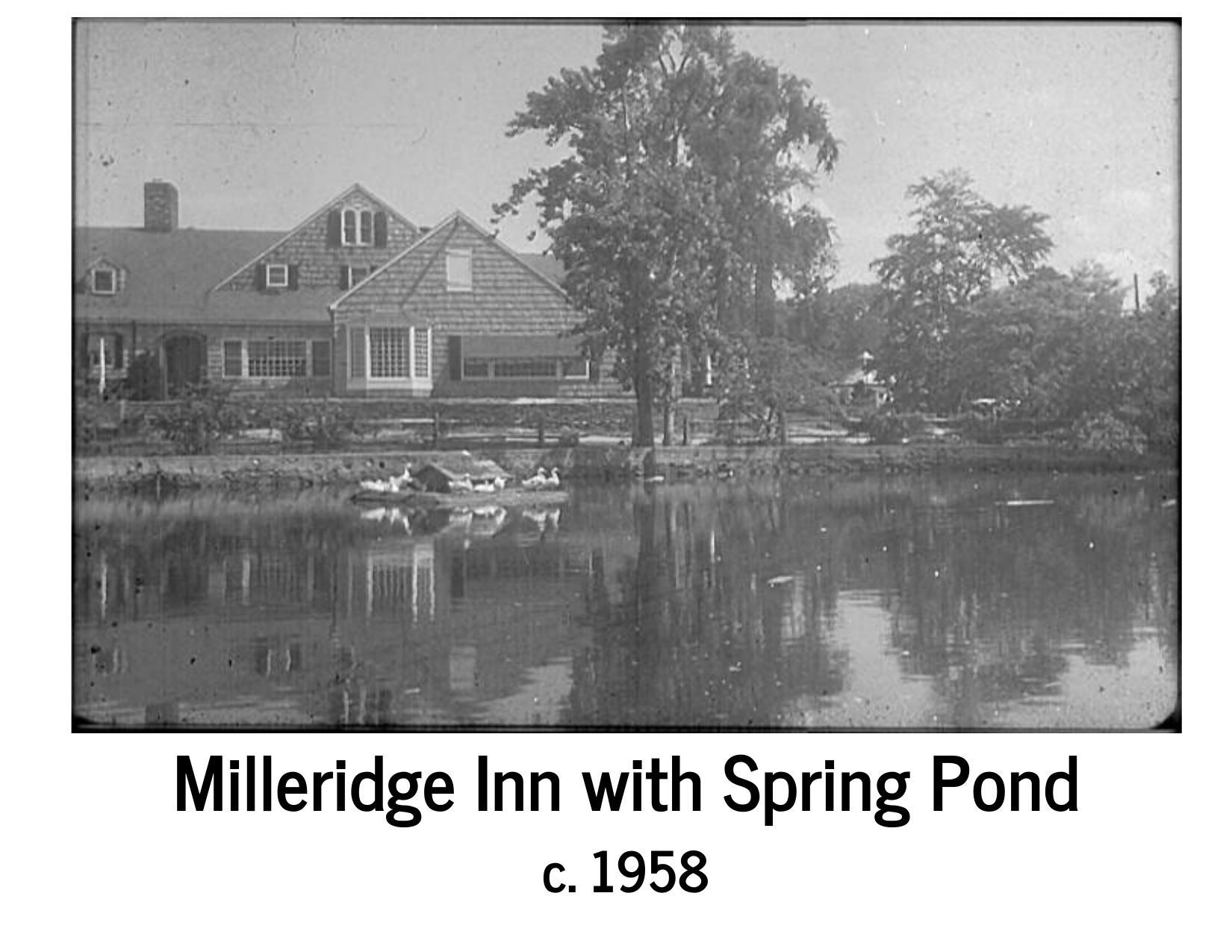 mes Murphy in charge of the 10-acre property he restored the restaurant with its colonial atmosphere. He first established a Country Store, soon followed by a cheese shop, a bakery, a toy shop and more in a quaint colonial shopping village. The main restaurant had three dining rooms, and a “Tap Room” There are restored upstairs party rooms for catering. The restaurant, with all its dining rooms, can seat up to 1,000 people and has parking for 550 cars. The separate catering Cottage came decades later.
mes Murphy in charge of the 10-acre property he restored the restaurant with its colonial atmosphere. He first established a Country Store, soon followed by a cheese shop, a bakery, a toy shop and more in a quaint colonial shopping village. The main restaurant had three dining rooms, and a “Tap Room” There are restored upstairs party rooms for catering. The restaurant, with all its dining rooms, can seat up to 1,000 people and has parking for 550 cars. The separate catering Cottage came decades later.
Malcolm House = (aka Jackson/Malcolm House) partially located on the west side of the Hicksville-Oyster Bay Road with the house on the east side just north of Old Jericho Turnpike. Originally Townsend property it was inherited by Dr. James Townsend who married Mary Hicks in 1757. They moved to this house where he established his medical practice. James Townsend also served as a member of the Provincial Congress prior to the British occupation during the American Revolution. It is believed the British established a camp in Jericho on the property the locals referred to as “Fort Nonsense.” After James Townsend died in 1790, the property was sold to John Jackson. Years later, John's great granddaughter Phebe Jackson married a Scottish immigrant, James Malcolm. James Arthur Malcolm, Jr. sold the western part of the property and barns to Nassau County in 1974. The house and rest of the land became part of the Jericho Historic Preserve in 2000.
Malcolm, James A. (1835-1912) = son of James Arthur and Hannah Underhill Malcolm, married to Phebe Underhill. They had 3 children, Sarah Jackson Malcolm, William Jackson Malcolm and James Arthur Malcolm. Served as Assessor for Town of Oyster Bay 1870-1874 and was Director of the Oyster Bay Bank.
Malcolm, James Arthur (1873-1948) = younger son of James Malcolm and Phebe Underhill Jackson, he married Hannah W. Underhill in 1913. James Arthur Malcolm, Jr. (1917-2010) was their only son.
Malcolm, James Arthur, Jr. (1917-2010) = only child of James A. and Hannah Underhill Malcolm, and only nephew of William Malcolm, he inherited the Jericho property after his father and uncle died. “Jim” grew up on the farm in Jericho, attended Jericho Public school and Friends Academy. He graduated from Swarthmore in 1938 and got his Master’s degree in engineering at Columbia in 1940. He worked for RCA and married Janet Dorothy Wilson (“Jaydee”) in 1942. In 1951 they moved to the house in Jericho with their three children, James (“Chip”), Betsy and John. Jim served on the Jericho School Board, Board of Trustees at Friends Academy and they were very active in the Jericho Friends Meeting. Jim sold the Malcolm barns and land to Nassau County in 1974 to be part of the Jericho Historic Preserve. The house and remaining property went to the County in 2000.
Malcolm, Phebe Underhill Jackson (1838-1895) = only daughter of William and Sarah Tappan Jackson. In 1862 Phebe married Scottish emigrant James Arthur Malcolm and had four children. One child died in infancy. There were two boys, William J. and James A. and a daughter Sarah, who never married.
Malcolm, Sarah Jackson (1865-1930) = daughter of James A. and Phebe U. Malcom. She never married but kept house for her father and brother.
Malcolm, Dr. William Jackson (1867-1950) = son of James and Phebe U. Jackson Malcolm. He had a younger brother, James and sister, Sarah. He probably graduated from New York University and became a medical doctor. He was the “staff physician” for the Vanderbilt Cup Races in 1905, 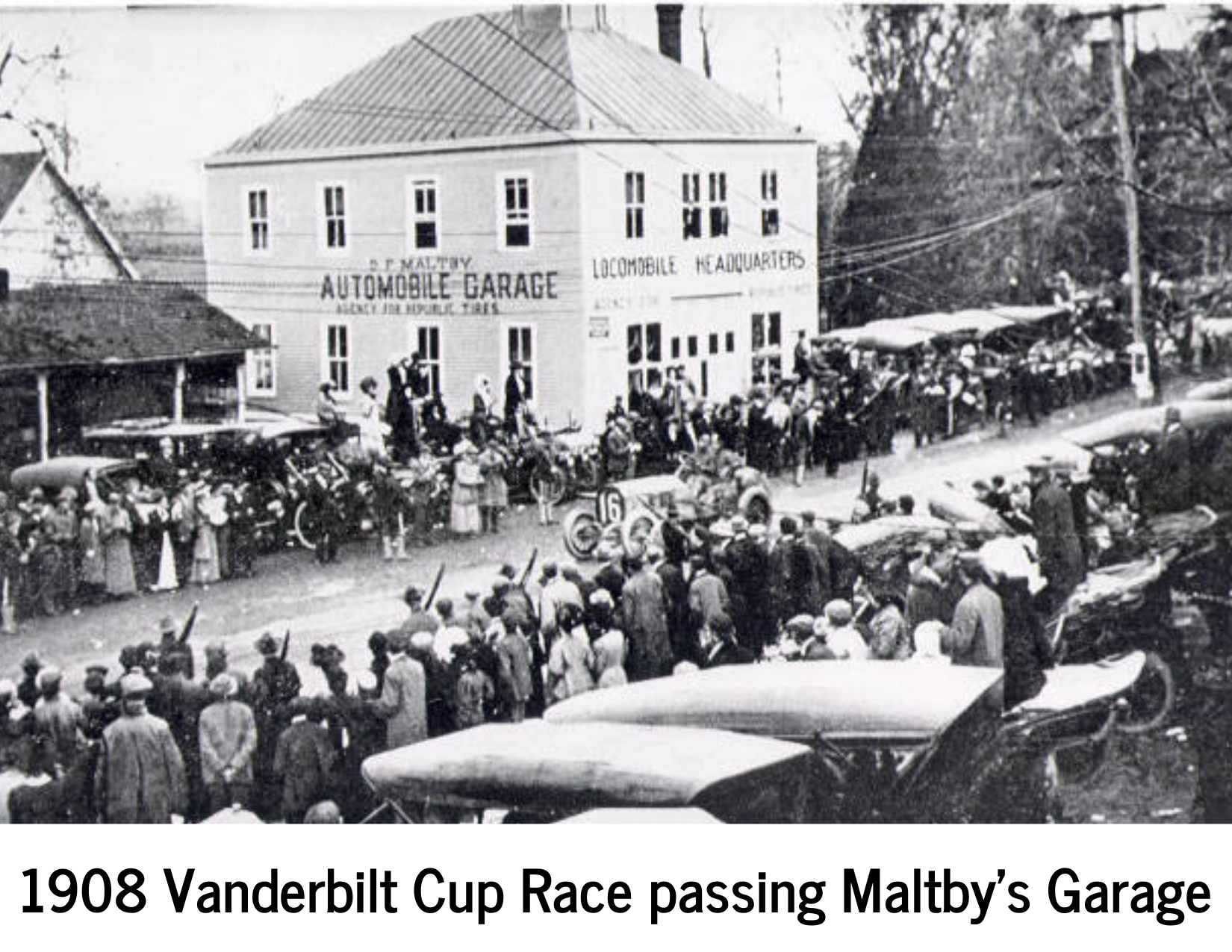 1906 and 1908 He never married, so when he and his brother James died, all the Malcolm property went to his nephew, James A. Malcolm, Jr.
1906 and 1908 He never married, so when he and his brother James died, all the Malcolm property went to his nephew, James A. Malcolm, Jr.
Maltby’s Garage = one of several garages owned by D. F. Maltby. This one was located in the center of Old Jericho on the north west side of the Hicksville/Oyster Bay Road at the intersection of Jericho Turnpike. It was named the Locomobile Headquarters in the early 1900s because it was the home of the only American car to win a Vanderbilt Cup Race. The building was later owned by Frank Curth, who sold it to become the first Jericho Fire House.
Manfroy, Rene (1911-??) = Jericho Fire Chief from 1951 to 1957.
Marmann, Eugene (1933-) = Jericho Fire Chief from 1968 to 1969.
Mansberger, William (1944- = Jericho Fire Chief from 1975 to 1979. Graduated JHS class of 1964. Co-captain of the Varsity Football team with John Saunders.
Mayz, Joseph = Jericho Fire Chief from 1963 to 1964.
Mayz, Ruth = Jericho resident from childhood, Ruth is seen in Jericho school photos [JPL LI Coll. Photo album], and she recorded an Oral History interview tape in 1976 [JPL LI Coll. Oral history tapes].
Meadow Brook Club = originally a Hunt Club with horses and hounds in 1894, it later evolved into a Polo Club. The 74-acre Polo field was sold to First National City Bank of NY in the mid-1900s. When Robert Moses wanted land for the Northern State Parkway and Long Island Expressway he acquired part of the property. The Meadowbrook Country Club and golf course was built in 1954 on the Middleton S. Burrill estate property just north of the expressway.
Merry Lane = beginning at Jericho Turnpike, it runs south past the Jericho Public Library through the East Birchwood development almost to the LIE. The traffic light at Jericho Turnpike at Merry Lane was installed after the death of a young girl (Arstark) trying to cross the turnpike on her bicycle.
Metzger, Edward, “Ted” (1904-?) = Ted moved to Jericho with his parents when he was 11 years old and attended the old wooden Jericho public school on Cedar Swamp Road. He married Helen Leonard in November of 1921 and had 2 or more children, Lillian and another. The Metzger's lived on the Underhill property. He worked for them and the public school for 43 years. His wife Helen, who worked in the school kitchen was "a super baker." Ted drove the Jericho school bus with “Lott” Halleran. The Metzger's moved south after their retirement.
Mid Island Shopping Plaza = See: Broadway Mall
Mille, Patsy “Pat” (c.1910-19?) = Jericho Fire Chief 1949 to1950. His son Pat Mille, Jr. (1938-to date) also a fireman, married Edwina.
Mille Ridge Inn/Milleridge Inn = originally the home of Mary Washburne Willets it was passed down through the family. By the 1890's the house was rented to the Doughty family. It later served as a sort of boarding house for Jericho school teachers. In the late 1930's the house was leased by the Percy Roberts family and opened as the Maine Maid Tea Room. When the Roberts moved across the turnpike around 1950, the restaurant was taken over by the Miller family from Texas and called the “Mille Ridge” Inn. The Mille Ridge Inn, evolved into today's Milleridge Inn. It was purchased by four members of the Murphy family in 1961. With James Murphy in charge of the 10-acre property, he restored the restaurant with its colonial atmosphere. He first established a Country Store, soon followed by a cheese shop, a bakery, a toy shop and more in a quaint colonial shopping village. The main restaurant had three dining rooms, and a "Tap Room." Upstairs, there are restored party rooms for catering. The restaurant, with all its dining rooms, can seat up to 1,000 people and has parking for 550 cars. The separate catering Cottage came decades later. The Murphy family ran it successfully until 2015 until no family members were left to take over. In 2015 it was bought by the Kimco Realty Corporation with a Murphy son-in-law, Owen Smith still in charge of operations until January 2016. Smith expressed faith the restaurant would remain as it was. So far, the new owners have kept the same ambience. In 2019 plans were announced to build a small hotel in the back portion of the parking lot.
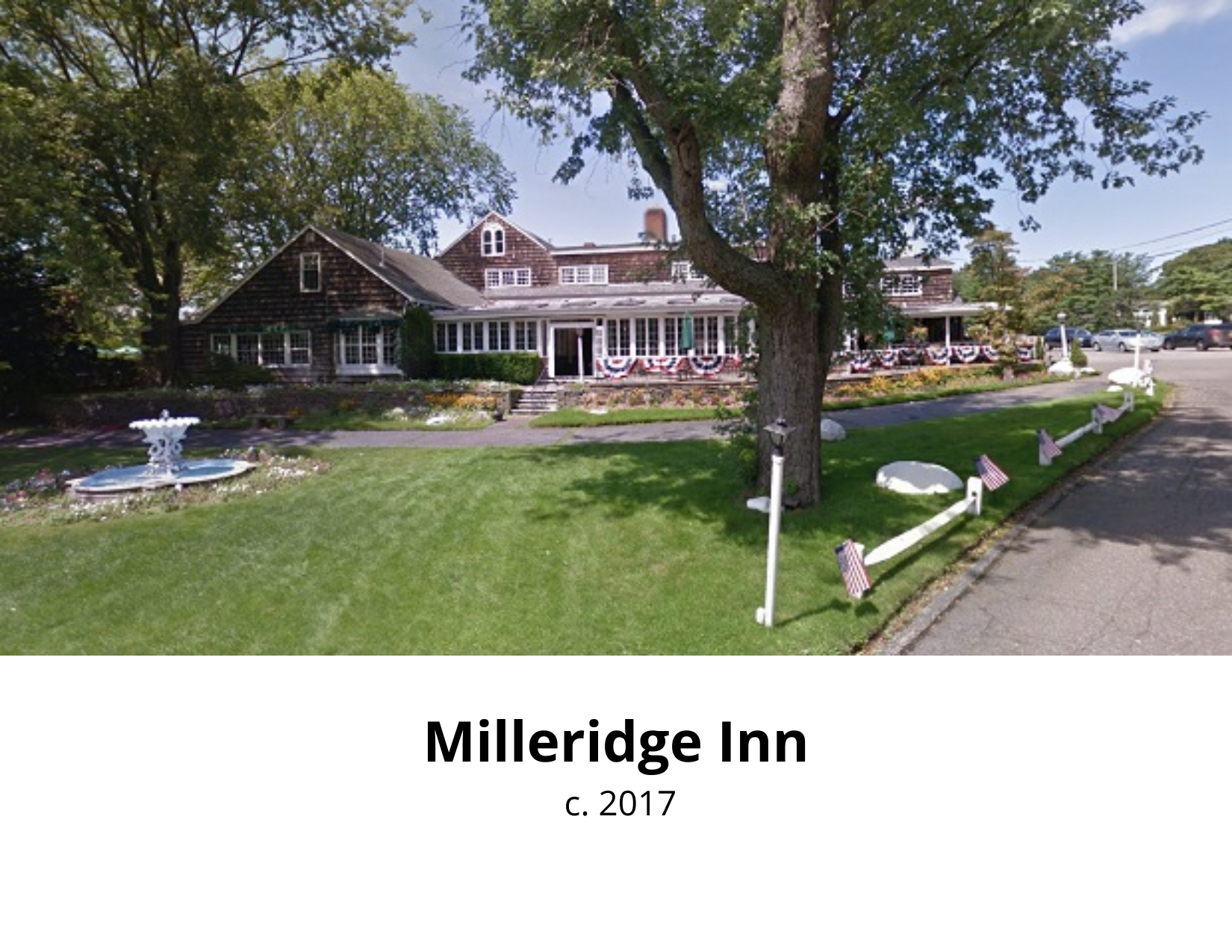
Mills, Dorothy (1910-1983) = “Dottie” was hired in May 1965 as Jericho Public Library’s first Director/Reference Librarian. She started work at the beginning of the fiscal year in July, in the basement of the Robert Seaman School, acquiring and processing books. The temporary library building opened in February, 1966 and the new building was finished and opened in 1972 with Dottie Mills still directing, with a small staff of clerks, part-time Children’s librarian and some volunteers. Dottie did most of the jobs herself, including book discussions, until she retired in 1982 because of poor health.
Milner, Michael Joseph (1968-) = Jericho Fire Chief, 1997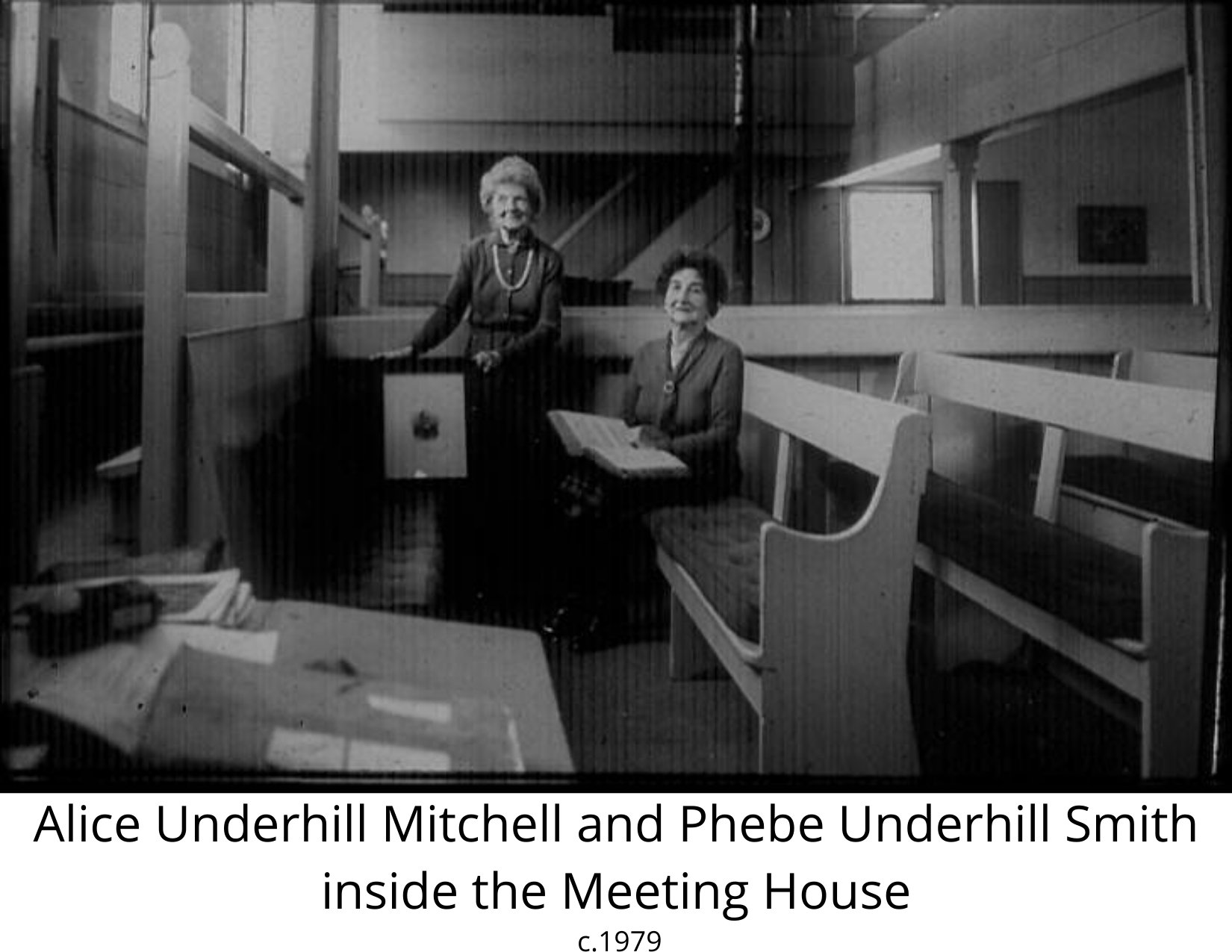
Mitchell, Alice Underhill (October 25, 1901- 2004) = older daughter of Samuel Seaman Underhill, Jr. and Carrie Holms Jackson Underhill, and the sister of Phebe. She is a member of the Daughters of the American Revolution through John Wright and her Great-Grandfather Jackson. She became a “convinced” Quaker at age 14 because her grandfather had been written out of the Meeting after he married a non-Quaker. Alice attended Jericho Public School and Friends Academy. She graduated from Maryland College for Women with a teaching degree and taught in the Jericho Station School in Syosset for two years. She went back to Cortland Normal and graduated in 1926 and taught in Mineola. She joined the Red Cross and the Charity Society of Jericho and Westbury. Alice married Myron Colyer Mitchell (a member of the Brookville Reformed Church) at home in 1929. They moved to Mineola and had one son, Samuel Underhill Mitchell (1931–2010). Alice taught briefly in the Jericho Public School and served as Clerk of the Jericho Quaker Meeting for 40 years (1947-1987). She worked on many charities and traveled around the world, toured the West, Alaska and spent a week on safari in Africa. She died in 2004 at age 103 and is buried in the Brookville cemetery. See also: Oral history tapes and photo album. See also: Underhill and Mitchell
Mitchell, Samuel Underhill (1932-2010) = son of Alice Underhill and Myron C. Mitchell. Cousin of Morley Lyford Smith and Phebe Alice Smith Apgar. Sam never married. He sold the S.S. Underhill property on Jericho Turnpike to developers for a retirement facility. After local protests and a case of arson that burned down the original farmhouse, the developers built private homes on the property.
Mobil Station = corner of Jericho Turnpike and Merry Lane, dating back to the Hallerans’ Garage, which had used Mobil Oil when they began as a gas station. It was demolished and became a T.D. Bank in 2016, after an unsuccessful bid for the land by the Jericho Public Library, for expansion of Library property.
Moraine, LI = a long ridge of hills formed by the Wisconsin Glacier in the last Ice Age. This geological formation runs the length of Long Island.
Munro, Alan = Jericho Fire Chief from 1959 to 1961.
Munson, Phillip G. (1927-2009) = a talented restauranteur, Phil ran the Maine Maid Inn very successfully from 1979 to 1998. He invited many celebrities who were performing at the Westbury Theater to dine at his restaurant and publicized their visits. It was a commercial success for more than twenty years. He retired and sold it to a corporate group.
Murphy family = they were owners of the popular Patricia Murphy’s Candlelight Restaurant and Lorraine Murphy Restaurants in Great Neck and Manhasset. James Murphy, his sisters and another brother acquired the “Mille Ridge Inn”, aka Milleridge Inn, with its ten acres from the Miller family in 1961. James had visions of a restaurant with a “side-attraction” similar to Knott’s Berry Farm in California, so he created the Milleridge Village of Shops near the restaurant on their large property.
Murphy, Neil = Jericho Fire Chief from 1964 to 1966.
Murphy, Ralph = first Nassau County police motorcycle patrolman. He covered Jericho Turnpike from the Queens line to the Suffolk County line. See framed photo in Archives.
N
Natasi, Vito = Jericho Fire Chief from 1966 to 1968.
Nichols, Francis Tilden = See: "Windfall"
Norwood Farm = a horse farm off Brookville Road on Route 25A - it was sold to developers about 1999.
O
Oak Hill = name of the Burden/Cary estate on Cedar Swamp Road and Fruitledge Road in Brookville.
Oakwood Princeton Park = development of 287 homes built in the 1950s-1960s on the west side of Broadway and south of Jericho Turnpike. The streets are named after U.S. Naval officers. These houses were built after the East Birchwood development on the east side of Broadway.
Old Brookville = just north of Jericho, the village was incorporated in 1929, an area of less than 4 square miles with about 68 homeowners.
Old Jericho Turnpike = part of Jericho Turnpike that was moved south in 1929. That stretch of road, which runs between the Malcolm house to the north and the Jericho Quaker Meeting house to the south, was renamed Old Jericho Turnpike.
Oliveri, Joseph Francis (1923-?) = one of 2 sons and 3 sisters of Dominick and Angelina Oliveri. They lived on 19th Street, Jericho.
Oliveri, Madeline E. (1921-2010) = daughter of Dominick and Angelina Oliveri, sister of Joseph and Carmine Oliveri. Seen in 1936/37 class of Jericho elementary school, she was able to identify many of the children in that photo and the teacher. She married --Gilson and lived in St. Charles, Illinois in 1995.
Oyster Bay Road = aka Route106
P
Page, Ernie = was a paid live-in custodian and dispatcher for the first Jericho Volunteer Fire Department in 1933.
Pell, Samuel Osgood (1875-1913) = the middle child, one of 7 sons and one daughter John Howard Pell and Caroline Elizabeth Hyatt Pell, Osgood had a career in real estate. He married Isabel Audrey Townsend in 1899. They had one daughter, Isabel in 1900, but they divorced soon after. He married Elizabeth K. Warden in 1903. Pell S. Osgood had a career in real estate. He sold estates to millionaires on the North Shore known as "Millionaire's Colony." He lived on almost 40 acres in Wheatley Hills, (now part of Long Island University campus) near the Morgan's, Whitney's, Winthrop's, and Phipps's families. One night in 1913, after dining with Willie K. Vanderbilt, he and William Laimbeer died in a car crash at a train crossing in Mineola. There was a lawsuit that didn't resolve much. Pell is buried in St. Paul's Church Cemetery in Mt. Vernon, Westchester, NY. In 1926 the former Pell mansion burned down and was replaced by a 20-room Georgian mansion referred to as Hutton House at LIU.
Petroglyph, Jericho = one of several prehistoric rocks found in the US that were left from the last Ice Age. It has prehistoric carvings verified by Stony Brook University. The rock is located in the Hamlet development and is not accessible to the public.
Picket Farm (1918-1977) = was designed by Peabody, Wilson and Brown on more than 90 acres around 1918 for Albert Kramer, Sr. (1878-1947). He was a lawyer, war work secretary president of Equitable Trust and the holding companies of General Electric and Westinghouse. Kramer was also the author of several books in the 1930-40s, including 2 with his wife Alice Bement Kramer. The property was bought in the late 1940s by Allan S. Lehman, of Lehman Brothers, NYC and his second wife Ann Margaret Roche. The property was abandoned and boarded up for many years before it was burned to the ground in 1977. It is now the site of a condo group called "The Hamlet" on the service road of the LIE.
Pitre, Edward C. = served as Jericho Postmaster, 1989 to 1990
Pluda, Paul R. = served as Jericho Postmaster 1990 to 1994
Post, Amy Kirby (1802-1889) = third daughter of Mary Seaman Kirby and Jacob Kirby of Jericho. Amy took care of her niece, Mary and nephew, Edmund after the death of their mother/her sister Hannah in 1827. Amy married her brother-in-law, Isaac Post (1798-1871) in 1828. Amy and Isaac later had 4 more children; Jacob in 1829; Joseph in 1832; Mathilda in 1840 and Willet Edmund in 1846. Amy was a cousin of Jemima Hicks and became a close friend of Elias Hicks in Jericho. She was a Hicksite supporter, staunch abolitionist, and worked for Indian and women's rights, suffrage, the Underground Railroad and she established an orphanage. See: Radical Friend; Amy Kirby Post and Her Activist Works, by Nancy Hewitt. [LI Coll Ref 289.673H]
Post, Isaac (1798-1871) = son of Edmund and Catherine Willet Post, he was born in Westbury, NY. He married Hannah Kirby in 1821 at the Jericho Meeting House and they moved upstate to the town of Ledyard. Isaac and Hannah had two children, Mary in 1923 and Edmund in 1825. H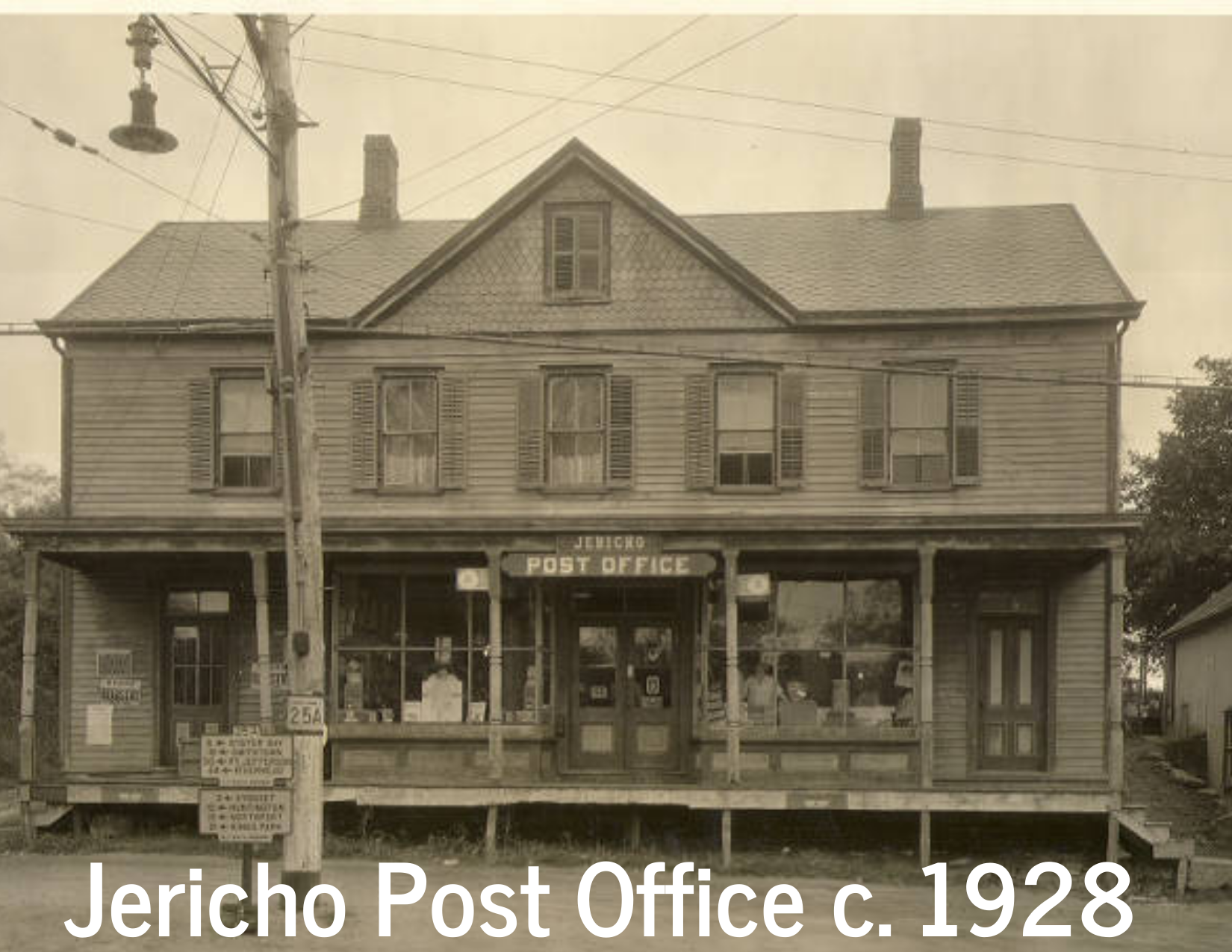 annah died in 1826 and Isaac married her sister, Amy Kirby at Scipio Meeting in 1828. Isaac died in Rochester in 1872 and is buried there.
annah died in 1826 and Isaac married her sister, Amy Kirby at Scipio Meeting in 1828. Isaac died in Rochester in 1872 and is buried there.
Post Office = Jericho was the first and only post office in what is now Nassau County (created in 1890). It was officially established in 1802 by the Postmaster General of the United States, in the home of a William Guthe (or W Guthrie). We have no other information about that first location other than it was probably located on Jericho Turnpike. The Jericho Post Office remained in the homes of several local postmasters until 1859, including Daniel Underhill, Valentine Hicks and Albert Carll, when it was relocated to the General Store owned by George Tappan on the Oyster Bay Road. See: The Mailman Cometh to Jericho by Linda Braner [974.7245 B] and Chapter 10 in Jericho, a History of a Long Island Hamlet. [974.7245 J]
Postmasters = see the list of postmasters from 1802 to 2009, on page 64 in the book, Jericho, a History of a Long Island Hamlet. JPL Circ and LI Coll. [974.7245J]. See Also: The Mailman Cometh to Jericho, by Linda Braner and Chapter 10 in Jericho, a History of a Long Island Hamlet.
Powell’s Hotel = also referred to later as the Jericho Hotel. Probably built in the late 1700s or early 1800s it was a stopping place for people on the Jericho Turnpike at the crossroads of the turnpike and the Oyster Bay/Hicksville Road. It became very popular during the Vanderbilt Cup Races (1904-1910) as an observation spot as the autos roared by the large front porch. The cupola and porch were lost in later renovations. When the DOT widened the roads and built the cloverleaf on Jericho Turnpike in the late 1950s the hotel was razed along with most of the buildings around this intersection.
Princeton Park = See: Oakwood Princeton Park
Prior, Elizabeth = a daughter of Thomas and Martha Prior, born in 1761. She married John Underhill in 1781. They had 3 children, Philomon, Phebe and John Augustus Underhill.
Public Library = See: Jericho Public Library
Public Schools = See: Jericho Public Schools
Pugnipan = The local Algonquian Sachem who lived in this area. Robert Williams drew up a “deed” to purchase the land that today makes up most of the Town of Oyster Bay. Pugnipan and eight other Native Americans “sold” the 9 square miles of land to Williams, except they didn’t know the meaning of the word “sold.” The paper, known as Pugnipan’s Deed was allegedly signed at Cantiague Rock.
Pugnipan’s Deed = we have a signed replica in the JPL archives.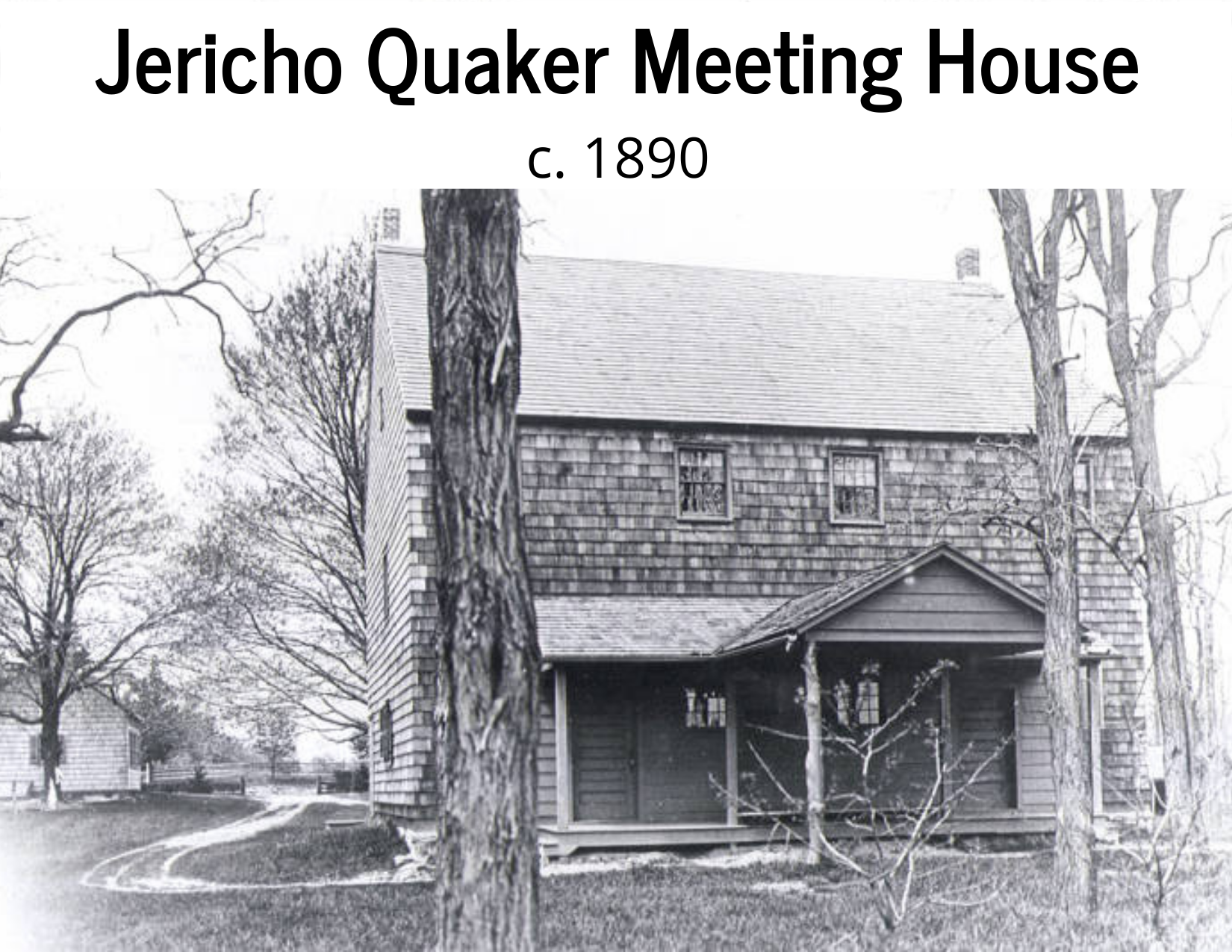
Q
Quakers = a common name for members of the Society of Friends
Quaker Meeting = the place where the Quakers (Society of Friends) hold their religious and business meetings. Also, the act of getting together for worship as well as the building.
Quaker School (1793-1870) = See: Friends School
R
Remsen, Augustus (1862-1930) = 12th Postmaster for the Jericho Post Office. He served as Justice of the Peace from 1894 to 1899 and was the owner of the Jericho General Store, where the Post Office was located for several years. The store burned down in 1895 and the Jericho Post Office had to be re-located to Eugene Robbin’s butcher shop nearby.
Remsen, Percy (1891-1966) = bought the Jericho General Store from Roy Hicks in 1928 and ran it until 1943. He served as Jericho’s 15th Postmaster from 1920 to 1934.
Robbins, Eugene (1859-1892) = son of Stephen and Esther Carpenter Robbins. Eugene married Ella Albertson in Glen Head in 1887 and they had three children, Stephen, Florence and Harold. He ran a butcher shop and the Jericho Post Office was moved there in 1895 after the Remsen’s General Store burned down. Soon after he died Ella remarried Jacob W. Jackson. She and her children took her new husband’s name.
Robert Hall Clothing Store (1950s-70s) = a local store that was part of a favorite American clothing warehouse-like chain for several decades. This store was located south of the LIE, west of Broadway. It was owned by Jacob Schwab who made up the name "Robert Hall" in his head. The chain shut down in 1977.
Robert Seaman School = founded in 1953-54, a ten-room school at 135 Leahy Street, the first separate new public elementary school built in Jericho when the old elementary school on Cedar Swamp Road was made into a Middle School and High School.
Robert Williams School (1960-1977) = the fourth public elementary school built on Barbara Lane and completed in 1960. It closed in 1977 because of lack of pupils and was leased to Solomon Schecter Hebrew School until September 2019. It is now a Nassau Co. Boces School.
Roberts, Percy Llevellyn (1884-1965) and Vivian B. (1888-1970) = Quaker restaurant owners who came from Sea Cliff to open the Maine Maid Tea Room in 1937 in the house that later became the Milleridge Inn. Vivian was born in Rockand, Maine and married Roberts in Rockland in 1913. They had 3 girls (Barbara, Grace and Nancy) and a son Nelson. See also: Maine Maid Inn
Rogers, Dr. Morris M. (1783-1860) = Jericho’s 3rd Postmaster (1821to1826) He was an M.D. and also served as Town of Oyster Bay’s Overseer of Highways and Commissioner of Schools.
S
Saint John’s Protectory Orphanage = about 1890, property owned by Bernard Earle was donated to the Roman Catholic Diocese of Brooklyn for an orphanage, dairy and farm. They acquired more land until the farm totaled 155 acres. Over 200 boys were sent to live and work on the farm. They raised produce and dairy products which were sent to the St. John’s and St. Joseph’s homes in Brooklyn to feed the orphans. It closed in 1937 and the land was sold to developers in 1952.
Saint Paul the Apostle Roman Catholic Church = the parish was established in 1962, but didn’t have a proper church site until 1966 when land was acquired from Jacob Schecter for a large church and hall to go with the Rectory and chapel which had been built first. Reverend Daniel J. Potterton was the first pastor.
Sandiford, Richard G. Jr. = served as Jericho Fire Chief from 2004-2005.
Saunders, John (1944- ) = Jericho High School Football co-Captain with Wiliam Mansberger. Wrestling team, Graduated JHS 1964.
Scanna, Maria = served as Jericho’s 26th Postmaster from 1999 to 2000.
Schiraldi, Richard = served as Jericho Fire Chief from 1987 to 1989, 1998 to 1999 and 2006 to 2008.
Schlessinger, Laura C. (1947-) = "Dr. Laura's" family moved to Jericho from Westbury in 1962. She came to Jericho High School in her Junior year, joined the Physics Club and became editor of the high school newspaper the Jer-Echo. She graduated from Stony Brook and Columbia for her Masters and Doctorate. She started her radio career in 1975 and her TV show premiered in 2000. She has written 13 books for adults and 4 for children.
Seaman, Anna (1861-1946) = daughter of Elias E. and Phebe Seaman. She bought the former Elias Hicks and Jemima Seaman Hicks house from James H. Seaman in 1910 and sold it in 1946 for $23,000 to Frederick M. Selchow. The house sat on only one acre at that time.
Seaman, Elias Hicks (1826-1904) = one of 7 children of Robert Seaman and Sarah R. Hicks (1793-1835). He married Phebe Underhill (1830-1903) in 1855 and they had four children, including Samuel Jackson Seaman (1859-1954).
Seaman, Captain John (1597-1672) = In 1630 John Seaman of Essex, England sailed with Governor John Winthrop to the Massachusetts Bay Colony in the New World. He relocated to Connecticut in 1636 and became captain of one of the Connecticut troops during the Pequot Wars in 1637. He married Elizabeth Strickland and had 4 sons and a daughter. When Elizabeth died he married Martha Moore in 1655 and had 4 sons and 7 daughters. By 1666 he was settled in Hempstead and they became members of the Society of Friends.
Seaman, Jemima = see Hicks, Jemima Seaman.
Seaman, John Jr. (1645-1697) = Captain John Seaman’s oldest son of his 16 children. John Jr. married Hannah Williams, daughter of Robert and Sarah Washburne Williams and had eight children.
Seaman, Jonathan (1716-1777) = son of John Seaman, grandson of Jonathan and great-great grandson of Captain John Seaman. Jonathan married Elizabeth Willis (1719-1777). They had three boys who died young and a daughter, Jemima who married Elias Hicks in 1771.
Seaman, Phebe Underhill (1896-1957) = only daughter of Robert Seaman and Hannah Willets Seaman who died giving birth to Phebe. She was raised by her grandmother Lydia "Lottie" Willets and lived in her home along with an apprenticed black girl, Florence Bates. Phebe and Florence grew up together and were lifelong friends. Phebe graduated from Swarthmore College in 1919. She never married and sold the remainder of the family’s Jericho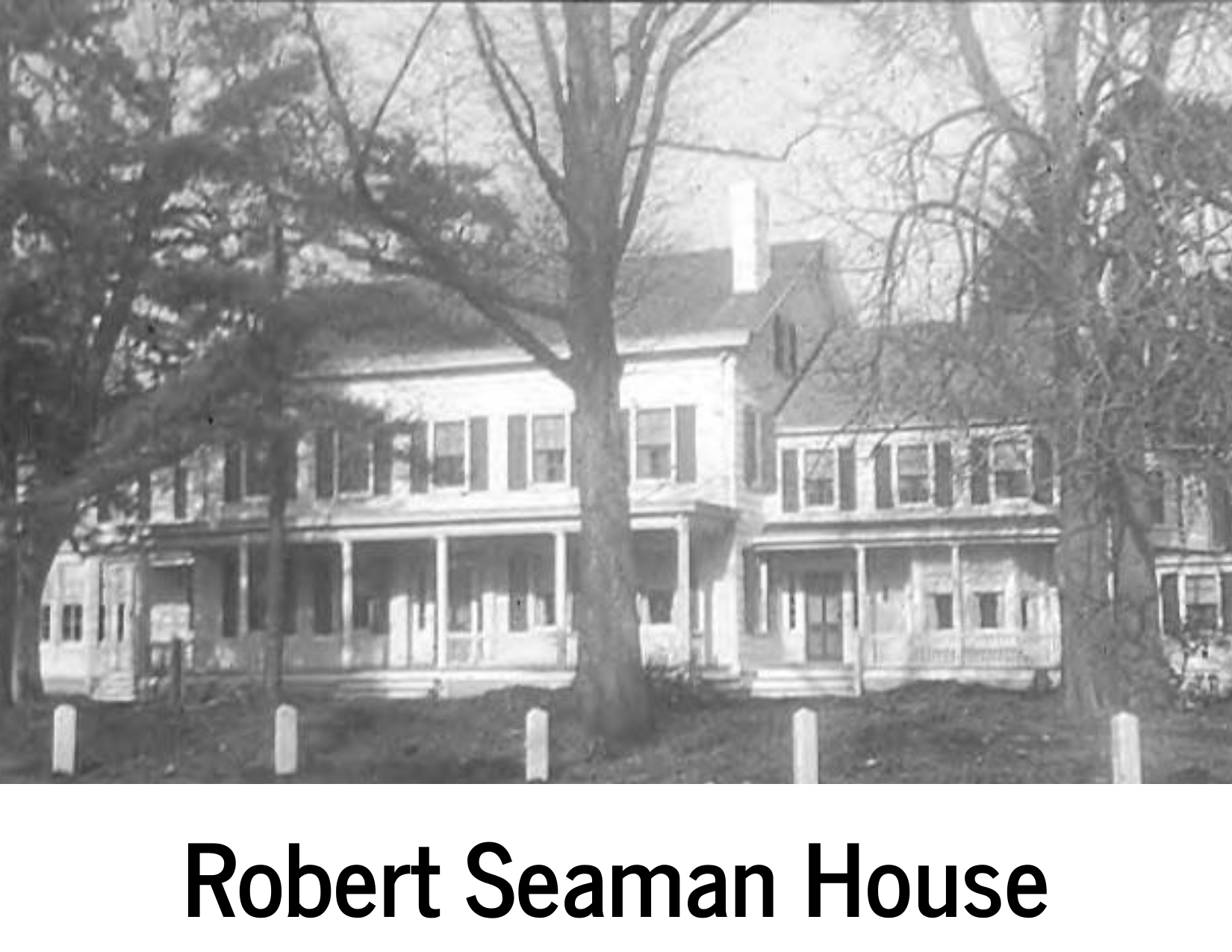 property to a developer in 1952.
property to a developer in 1952.
Seaman, Robert (1864-1955) = 9th generation descendant of Captain John Seaman and descendant of Robert Williams. Robert was the son of Elias Hicks Seaman and Phebe Underhill Seaman (daughter of Samuel J. and Mary Underhill). His grandmother, Sarah Hicks Seaman was the daughter of Jemima and Elias Hicks. Robert married Hannah Willets (1858-1896), daughter of Daniel and Lydia (Moore) Willets in 1894. Hannah died in childbirth and Robert never re-married. He and Hannah had only one daughter, Phebe Underhill Seaman who never married. Robert was President of Seaman, Taliferro and Eisemann, Inc., an insurance company in Hicksville, NY. He served as the 11th Postmaster in Jericho from 1890 to 1894. He was one of the founding trustees and President of the Board of Trustees of the Jericho Public Schools, and was connected with them for over 25 years. Robert helped finance the building of the second public school building on Cedar Swamp Road, along with James Malcolm and Emma Albertson Underhill in 1906. He donated some of his own land to build the Robert Seaman Public Elementary School in 1953 and attended that school’s dedication at age 89. He also served on numerous Boards, including Hicksville Savings and Loan, First National Bank, Sterling Bond & Mortgage. He also served as President of the LI Poultry Assoc., Inc., and was on the Board of the Queens/Nassau Agricultural Society.
Seaman, Samuel Jackson, Sr. (1857-1954) = son of Elias Hicks Seaman and Phebe Underhill Seaman. He married (first) Matilda Willets (1854-1896). They had 5 children. They lived in Jericho but later moved to Duck Pond Road in Glen Cove. He married (second) Jane Willets, Matilda's sister in 1878. He married (third) Katherine Valerie des Jardins Pilling in 1918. He was the Vice-President of the Glen Cove Trust Co. He served on the Board at Friends Academy and was Clerk of the Westbury Quaker Meeting.
Seaman, William Henry (1868-1954) = son of Elias Hicks Seaman and Phebe Underhill Seaman. He married Margaret Jagger Laurie (1869-1951) in 1893. They had three children. He served as Oyster Bay town supervisor in 1917 and became the first mayor-Supervisor of Glen Cove in 1918 and again in 1942.
Sidorski, Anthony = served as Jericho Fire Chief from1947to 1949 and 1950 to 1951.
Simcoe, Lt. Col. John Graves (1752-1806) = a Loyalist officer who marched his troops into Jericho in 1778. Simcoe went on to fortify the town of Oyster Bay. The troops were left in Jericho under the command of Lt. Col. Banastre Tarleton.
Simplex auto = See: Crane-Simplex auto
Smith, Benjamin S. = served as Jericho’s 10th Postmaster from 1886 to 1890.
Smith, Phebe Ella Underhill (1906-1999) = second daughter of Samuel Seaman and Carrie Jackson Underhill. She attended Jericho Schools and taught there for a while. She married Dr. Morley Lyford Smith and they had two children.
Society of Friends = formally called the Religious Society of Friends, this movement began in England during the Reformation in 1650 by George Fox. It is an adaptation of the words of Christ "I have called you friends." John (15:15). This sect usually goes by the name "Quaker." Their basic belief is that God can speak directly to any individual and, in turn they can speak directly to God and the presence of God is in every person. Each person is responsible for their own actions. The Quakers, suffering from persecution in England fled to the Netherlands where they were encouraged to settle in the New World in 1657. The very out-spoken group who land in New Amsterdam was soon outlawed by Governor Stuyvesant who passed an anti-Quaker law. The sect survived and grew over the many decades and still are found on Long Island today.
Solomon Schechter Day School = a Hebrew school that leased the Robert Williams Elementary School building in White Birch, Jericho from 1978 to 2019.
Sosnow & Schwartz = developers of East Birchwood.
Sprague, Newbury (1810-1870) = Sprague never married but he taught Jericho school children in a private school established by Solomon Jackson for his children on Brush Hollow Road. It looks like he had a sister, Elizabeth Sprague and was a friend of Robert W. Titus and a Rushmore. He bought the Carll property on the north side of Jericho Turnpike at auction in 1859. It consisted of 7 "improved acres" with a house, 3 horses and cows, at auction . In 1865 this property was purchased by Isaac Ketcham, and is now part of the Historic Preserve.
Spring Pond = a natural underground spring created this vital source of clean water in Jericho. Robert Williams built his home just north of the pond. He settled his widowed sister-in-law Mary Washburne Willets and her children closer to the pond. It was a source of drinking water for all who settled in the area and the major source of ice in the winter for preserving food in the summer. After decades of being a necessary resource it remained an attraction as a duck pond in front of the Maine Maid/Milleridge Inn. Around 1960 the pond was drained by the D.O.T. and diverted underground to make room for the widening of Broadway and the creation of the Jericho Turnpike overpass.
Stewart, Harry Joseph, Sr. (1898-1972) = Worked for the Nassau County Department of Highways. He served on Jericho Fire Department in 1939. Married Wilhelmina, had 3 sons.
Stewart, Harry, Jr. (1920-1990) = son of Harry Stewart, Sr. He served on Jericho Fire Department with his father in 1939.
Suicide Turn = a severely curved portion of Old Jericho Turnpike near the Underhill house that became the scene of many automobile crashes in the early 1920s. The road was redirected south of the Jericho Quaker Meeting house in 1929 to eliminate this dangerous curve. This caused the re-location of the General Store and Halleran’s Garage, which had to be moved back from their original locations many feet to accommodate the new road.
T
Tam O Shanter Country Club = This property was owned by the Deering family and was called Linden Hill. The club opened in 1962 on the corner of Fruitledge Road and Route 107 with the mansion as the clubhouse. The mansion burned down in 1970 and was replaced with a modern building. The golf course was designed by Robert Trent Jones in 1968 as a regulation 18-hole private golf course. The club offers tennis courts, a swimming pool and full amenity clubhouse for dining and events. It was sold to Titan Golf for $15 million in 2019.
Tappan, Frank (1892-1937) = son of Andrew Tappan, Frank was drafted in WWI. He was one of the original founders of the Jericho Fire Department, and served as Fire Chief from 1934-1937.
Tappan, George (1815-1903) = proprietor of a small general store on the west side of the Hicksville/Oyster Bay Road north of Jericho Turnpike. Part of the store served as the site of one of Jericho’s many Post Offices. George served as Jericho’s 8th Postmaster during the Civil War years, from 1859 to 1866 and again from 1870 to1886.
Tappan, Harry Moore (1887-1938) = a grandson of John J. Hicks, Harry inherited the second cider mill on the Oyster Bay Road (Route 106) in the 1930s. Harry modernized it with a steam driven press which he later converted to electric and ran it until his death in 1938. The mill made apple vinegar along with sweet cider. The mill was bought by John Zulkofske. Harry is buried in the Jericho Quaker Burying ground. He was married to Lucy A. Kennedy, and they had two daughters, Geraldine and Evelyn.
Tappentown Cemetery = located off Cedar Swamp Road and Cowpath within the “Cedarbrook Estates” in the Village of Brookville. Some members of the Thorne, Davis, Nostrand, Valentine, Isaac Seaman and Waldron families are buried here. See: Cemetery folder in Vertical File for research done by descendant of the Hicks family about 2005.
Tarkin, Malvin S. (1935-2020) = “Mal” attended Dewitt Clinton High school and NYU School of Commerce. He married Renee Schweinerin in 1956. Mal served for many years with the Jericho Unit of the Nassau County Auxiliary Police which was created in the 1940s for Civil Defense. In 1990, he was elected to the Crime Prevention Association Board.
Tarleton, Lt. Col. Banastre (1754-1833) = Son of a Liverpool merchant involved in the slave trade, he came from England with Gen. Cornwallis to quell the colonial rebellion in 1775 at age 21. He fought in Philadelphia, New Jersey and New York before coming to Long Island and earned the nickname “Bloody Tarleton.” He returned to England in 1781 and became a prominent Whig politician, while continuing to serve in the army.
Temple Beth Torah = (Conservative) Located on Cantiague Road, Westbury, this temple was created by a group led by Joe Einbinder in an area called Westbury Hills in 1960. They purchased land on Cantiague Rd and built the temple in 1963. Expansions in 1971 and again in 1994 included a social hall, classrooms, library and stained-glass windows. Cantor Kalman Fliegelman has been at the temple since 1963 and Rabbi Michael Katz since 1979.
Temple Or-Elohim = (Reform) Located on Tobie Lane, Jericho this modern, liberal temple opened in May, 1957. The congregation held its first meetings in the “Eldorado” model home at the entrance to East Birchwood, made available to them by the developers Sosnow and Schwartz. A permanent temple with lobby and social hall was completed in 1969. The model home building was retained as a school and office. Stained glass windows by Ami H. Shamir were added to the temple in a 1995 renovation.
Thorne, William (1744-1815) = son of Isaac and Hannah of Flushing. He married Jemima Titus (1741-?) at Westbury Friends Meeting in 1765. They had 3 children, Samuel, Nicholas and Phebe Thorne.
Tilles, Gilbert (1927-1990) = Real estate developer and patron of the Arts, Tilles, and his Tilles Investment Company, tried to build 218 luxury condos and 124 single family homes on 81 acres of Underhill property he bought from Henry Willets Underhill around 1980. Opposed by the public, the case went on for decades, but never succeeded. The case was settled in 2004 when the Town, the county and NY State purchased 50 acres of the property for conservation and preservation. The rest of the property was purchased by Bill and Ellen Doremus in the 1980s as a private residence.
Titus, Annie Smithson (1823-1865) = was the first wife of Soloman Seaman Jackson. They had two daughters, Josephine in 1859, who married George Prince and Grace Anna in 1864, who married Henry C. Woodnut, Jr.
Titus, Burt Hegeman (1908 -2002) = Son of Willet (1870-1924) and Harriet Burt Hegeman Titus (1872-1950). Burt married Marguerite E. Monfort (1914-2003) in 1935. They lived at 13 Titus Path, and had two sons, James and Peter.
Titus, Edmond (1630-1715) and Martha Washbourne (1637-1732) = Edmond came to New England with his parents Robert and Hannah and brother John, in 1635 on the ship "Hopewell." He came to Cow Neck, Long Island in 1650. He married Martha Washbourne, daughter of William and Jane, sister of Mary Washbourne Willets. She was a niece of Robert Williams. By 1671 he was a Quaker and sold his home with 29 acres of land in Hempstead and moved to Westbury (then called Plainedge or Woodedge) with another Quaker, Henry Willis, where they established a Quaker Meeting. Edmond and Martha had eleven children. Their daughter Martha married Benjamin Seaman (son of Capt. John) and a son, Peter married Martha Jackson (son of John Jackson).
Titus, Harriet Burt Hegeman (1872-1950) = daughter of Samuel Burt Hegeman and Harriet Burt. She grew up in New Hyde Park, married Willet Titus in 1897. They had three children, a daughter Elizabeth Willets [later Hollett] and two sons, Willet, Jr. and Burt. They are buried in Westbury Quaker Meeting grounds.
Titus, James Clifton (May 9, 1943-Oct 15, 2024) = older son of Burt and Marguerite Titus in Muttontown. The family spent their summers out east in Noyack. "Jim" graduated from Jericho High School in 1961, Farmingdale College, LI with a degree in Horticulture, and the Univ. of Georgia with a degree in landscaping. He served in the Army during the Vietnam War as a cartographer. For the rest of his career he worked for the City of New York designing parks and green spaces. He married to Phyllis in 1985. They have two daughters, Jennifer and Amy and several grandchildren.
Titus, Peter = younger son of Burt and Marguerite Titus, he is a professor at M.I.T., in Boston.
Titus Robert (1600-1670) & Hannah Carter (1604-1672) =sailed from England in 1635 with their sons, Edmond and John on the ship Hopewell during the Puritan migration. Robert, Hannah and by that time, their seven children were forced out of Massachusetts for religious reasons and settled in Huntington in 1654.
Titus, Willet (1870-1924) = son of Oliver Titus (1826-1903) and Elizabeth Willets (1824-1907). Willet married Harriet Burt Hegeman and moved to Jericho. They had 3 children, including a son, Burt Titus.
Titus, Willet Jr. (1906-2000) = son of Willet and Harriet H. Titus, older brother of Burt Titus.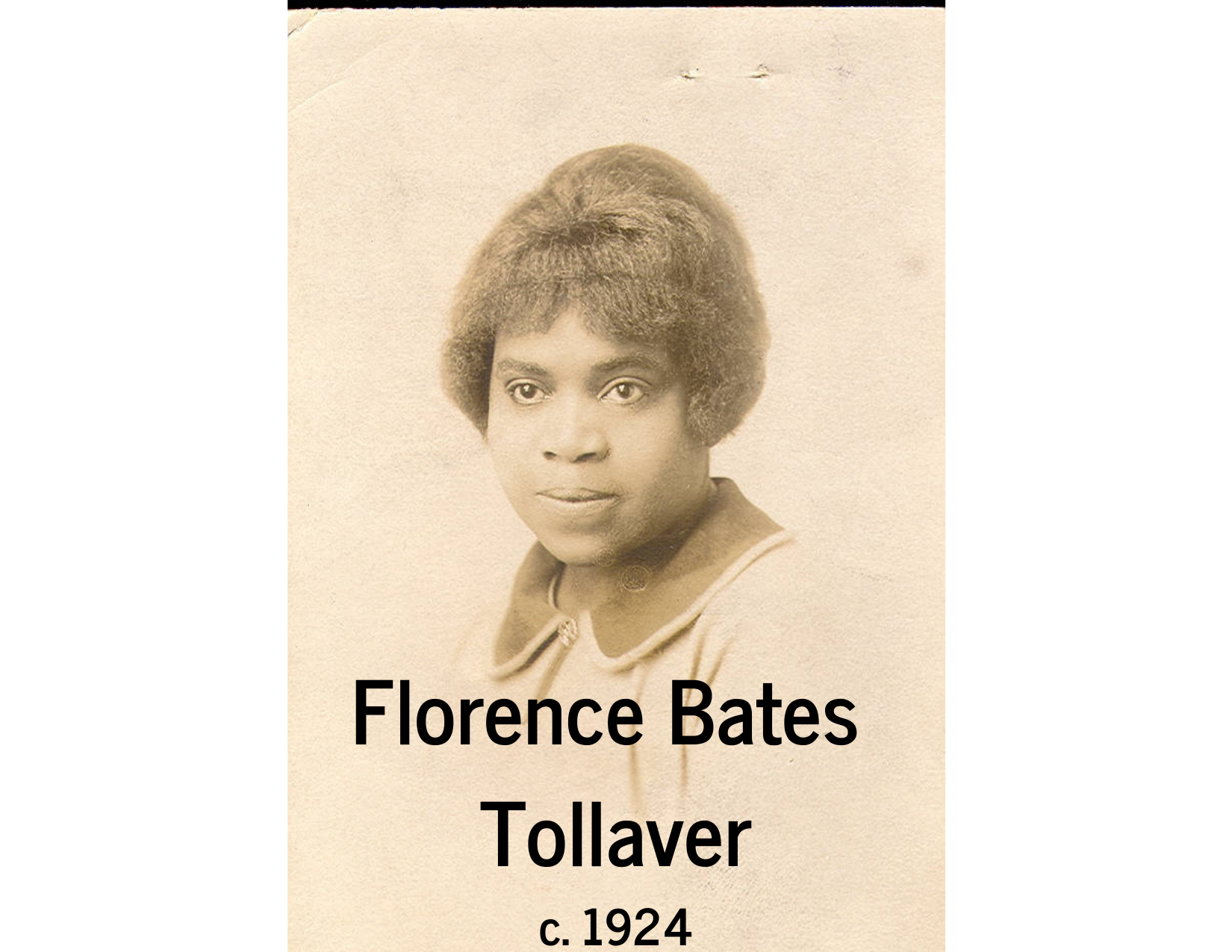
Tollaver, Florence Elizabeth Bates (1890-1986) = daughter of Ferdinand and Jennie Bates, Florence was born in Jericho and was “apprenticed to the Underhill sisters from age 4 to age 18. Florence lived with Mrs. Lydia “Lottie” Willets and saw her mother twice a year (her father died in 1890). Florence was sent to public school, attended the Quaker Sunday school and A.M.E Zion church every week. She was taught how to sew after school so she could earn a living as a seamstress like her mother and grandmother. Florence lived in the house with, and was a companion to Phebe Underhill Seaman, the orphaned daughter of Robert Seaman whose mother died soon after Phebe was born. Florence was 4 years old when Phebe was born. In 1902 she went to a huge garden party at Sagamore Hill and met President T. Roosevelt. He gave each guest there a glass punch cup with the date 1902, which Florence later donated to our archives. She was 18 when she married a stepson of her mother, Lewis Henry Tollaver in 1908. He was 15 years older than her Florence. They lived in Hempstead and then New York City with her brother Valentine Bates. Tollaver died in 1946 and is buried in Jericho. Florence spent the end of her life in Los Angeles, California with her brother Valentine. They are both buried in Forest Lawn Cemetery. She only returned to Jericho, “when sickness and death came to the house…and I always answered the call.” She donated many interesting letters, photos and memorabilia (including a pickle jar lamp with special shade) to the Jericho Public Library Archives.
Toscano, Ann (1923- ) = daughter of Nicholas and Margaret Toscano. She was one of their 5 children who attended Jericho Public Elementary School.
Toscano, Nicholas (1900-1989) = “Nick” was one of the original members of the Jericho Fire Department along with his brother Sam Toscano. He worked as a gardener for William Woodward in Brookville and in the aircraft industry. He was born in Italy and came to the US in 1909. He was married to Margaret, and they had 5 children. He is buried in Holy Rood Cemetery, Westbury.
Toscano, Samuel (1910-2006) = “Sam” one of the original members of the Jericho Volunteer Fire Department along with his brother, "Nick." He was the last of the original firemen to pass away.
Totter, Henry A. = served as Jericho’s 19th Postmaster from 1972 to 1988.
Townsend, George Henry II (1884-1957) = partner of Harrison H. Boyce, the inventor of the Boyce Moto-Meter, a valuable thermometer used on early auto engines.
Townsend, Dr. James (c.1735-1790) = married Mary Hicks in 1757 and moved to Jericho to establish his medical practice. A member of an early Provincial Congress before the British occupation, he was elected to the first U.S. Congress in 1789 but died in 1790 along with four of his seven children, probably of influenza, before he could serve. His house was later sold to John Jackson. Jackson's great granddaughter Phebe married James Malcolm and became known as the Malcolm House.
Townsend, Leah (1652-?) = married John Williams (1648-?), son of Robert and Sarah Washburne Williams. Leah and John had 2 daughters. Temperance married John Seaman and Hannah married David Seaman.
Townsend, Martha (1760-?) = daughter of Dr. James and Mary Townsend of Jericho. She manumitted at least 4 slaves left to her when her father died c. 1790. Martha married Edmund Willis in 1794. Martha made a request to transfer to NY Meeting in 1830.
Tredwell, Timothy, Dr. (17??-1814) = built a house in Jericho between 1800 and 1810, next to the Seaman/Hicks property. He married Mrs. Margaret Seaman in 1808. After he died around 1814, the property was purchased by Valentine Hicks for $3,550 for his wife Abigail and three daughters.
Trukafka, Catherine Veronica Freeman (1915-1999) = daughter of Michael Freeman and Elizabeth Blum Freeman, Catherine was the first woman to serve as Postmaster in Jericho. She was appointed in 1935. She married William Raymond Trukafka in 1946 but remained the 17th Jericho Postmaster until 1953. She found the Post Office had become so busy after the housing boom in Jericho she had to hire a part time assistant, Mrs. Signe Hopp Halloran in 1943.
Turner, George A. (19??-2013) = Jericho Firefighter who died in the line of duty in 2013 was honored in 2019 at Eisenhower Park by Nassau County Firefighters Memorial Endowment Association.
U
Underground Railroad = was a success because it was a well-kept secret -facts are hard to find, but there are stories of Underground Railroad activities in Jericho. Documents do mention secret hiding places at the Jackson/Malcolm house and activities at the Valentine Hicks house. Rachel Ketcham writes about helping slaves escape by hiding them in their wagon on their way to market. Efforts to have the Malcom house declared a documented stop on the UGRR by the U.S. government did not succeed. The building has since been gutted and remodeled into a modern restaurant.
Underhill, Adonijah (1743-1819) = son of Thomas (1702-1798) and Sarah Powell Underhill (1710-1798). He married Phebe Willets (1747-1819) at Westbury Meeting House in 1769. They had two children Daniel (c.1770-1821) and Rachel (1775-?). He freed his 4 slaves, Katurah, Charles, Jacob and Ann in 1799.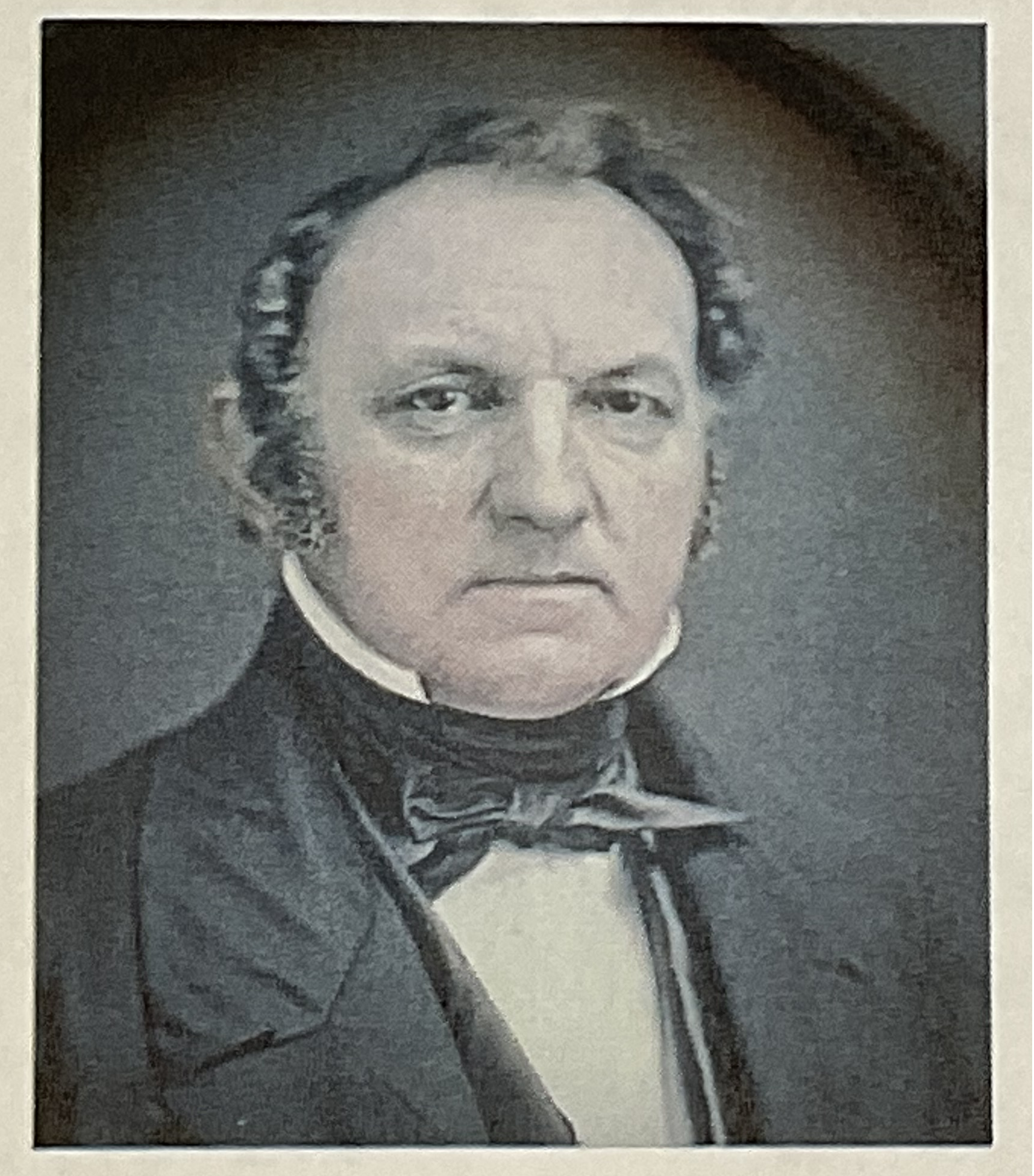
Underhill, Adonijah Jackson (1800-1854) = son of Daniel and Mary Underhill. In 1826 he married Phebe Hicks (1804-1852), the daughter of Valentine and Abigail Hicks in Jericho. They lived in New York City but had no children. They are buried in Jericho Friends Burying Ground.
Underhill, Alice J. = See: Mitchel, Alice J. Underhill = oldest daughter of Carrie and Samuel S. Underhill.
Underhill, Emma Albertson (1852-1937) = daughter of Richard and Phebe Albertson, Emma married Samuel Jackson Underhill (1848-1910), son of Daniel Underhill and Caroline Post, at her parents' home in Mineola, in October 1872. Emma and Samuel Underhill had 3 sons; Daniel (1874-1951), Richard (1880-1887), Henry Willets Underhill (1882-1926), and a daughter Helen (1887-1924).
Underhill, Daniel (c.1770-1821) = son of Adonijah (1743-1821) and Phebe (Willets) Underhill. He served as the second Jericho Postmaster from 1813 to 1821 and held the position of Pounder (dog catcher) and Fence Viewer (fence inspector) for the Town of Oyster Bay. In 1794 he married Mary Jackson of Jericho. Their son, Adonijah married Phebe Hicks, a granddaughter of Elias and Jemima Hicks in 1826. Daniel had 3 more children by his second wife, Phebe Underhill.
Underhill, Daniel (c.1826-1899) = son of Samuel Jackson and Mary Willets Underhill. He was first married in 1847 to Caroline Post. They had two sons, Samuel Jackson Underhill and James (1851-1859). They were married 35 years. After Caroline died in 1882, he married her spinster sister, Catherine Post in 1883 probably because she had been living with them for many years.
Underhill Estate = or property comprising more than one hundred acres running along the north side of Jericho Turnpike. It was owned by the Underhill family for more than 3 generations. After the death of H. Willets Jr. and Peggy Underhill it was purchased by Bill and Ellen Doremus and their two sons. After Bill’s death the property was purchased for a Senior assisted living residence, one of 15 Bristal Communities on Long Island.
Underhill, Henry Willets (1882-1926) and Helen Wallower (1886-1931) = son of Samuel Jackson and Emma Albertson Underhill, Henry married Helen Wallower in 1912, He was president of the Hicksville Bank and Treasurer of the Queens-Nassau Agricultural Society. He owned more than 200 acres on the northside of Jericho Turnpike. Henry and Helen had 3 children, Henry Willets Underhill, Jr., (see below) Catherine J. Underhill (1914-1926) and Samuel Jackson Underhill (1918-1942) a WWII US Navy pilot killed in the Battle of Coral Sea.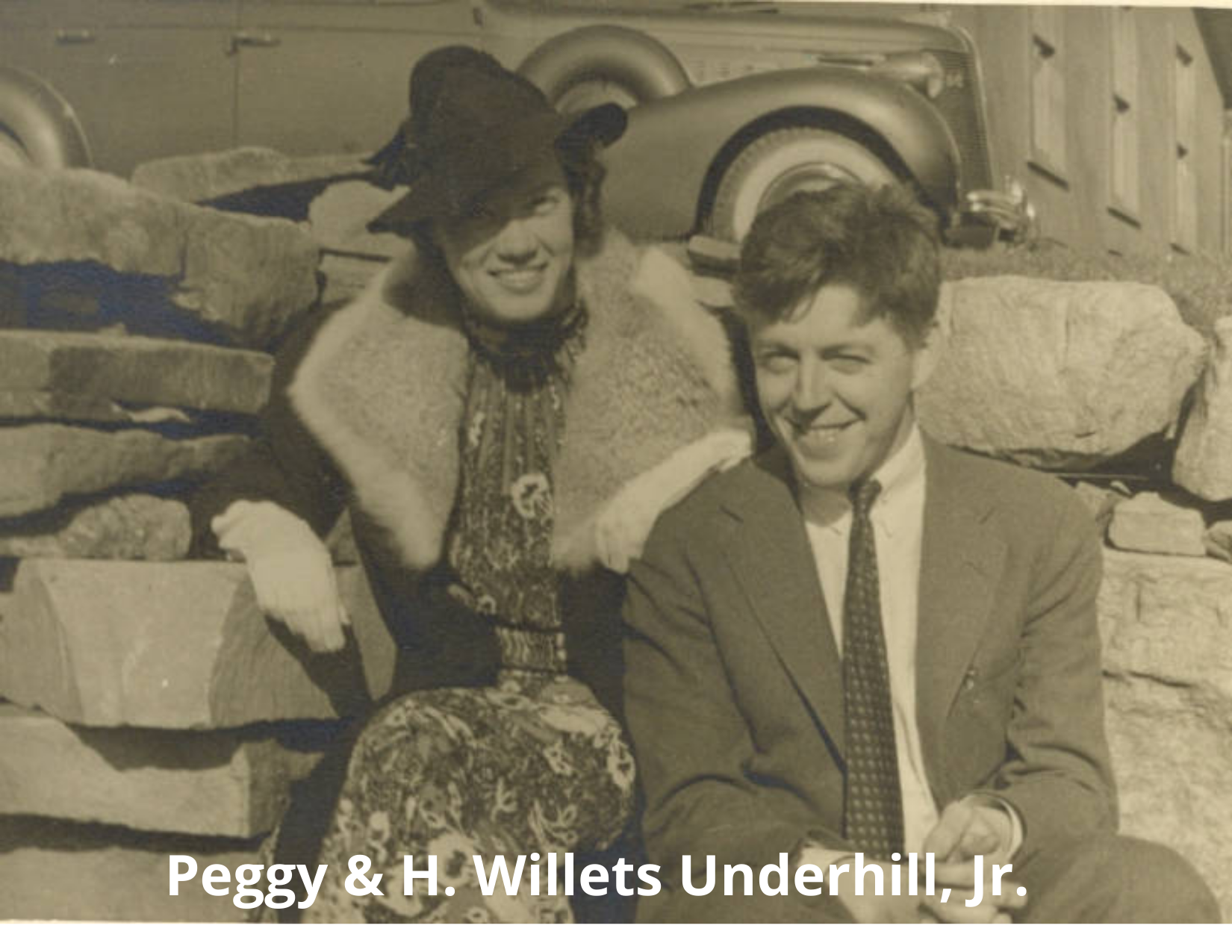
Underhill, Henry Willets, Jr. (1913-1990) and “Peggy,” Margaret Maitland Young (1912-1998) = only living child of Henry Willets and Helen Wallower Underhill. He met Peggy Young in college and they married in 1940 at the chapel at Princeton University. They had no children. Willets was trained as a Civil Engineer and served in the Naval Reserve. He and Peggy traveled and lived on their large estate on the northside of Jericho Turnpike. He was active in civic affairs and kept busy as a gentleman farmer.
Underhill, Captain John (1597-1672) = born in the Hague, Netherlands he married Helena DeHooch (1608-1658) in 1628. They had one son, John Underhill, Jr. After Helena died in 1658 he married Elizabeth Feake (1633-1675) in Southold. They settled finally in Oyster Bay at a large property called Killingworth where he died in 1672.
Underhill, Phebe Ella (1906-1999) = See: Smith, Phebe Underhill., Phebe married Dr. Morey Lyford Smith in 1932.
Underhill, Rachel Jackson (1775-?) = daughter of Adonijah and Phebe Underhill. In 1804, she married Obadiah Jackson (?-1825) at the Jericho Friends Meeting. They had 3 children, William (1806-1866), Elizabeth (1809-1827) and 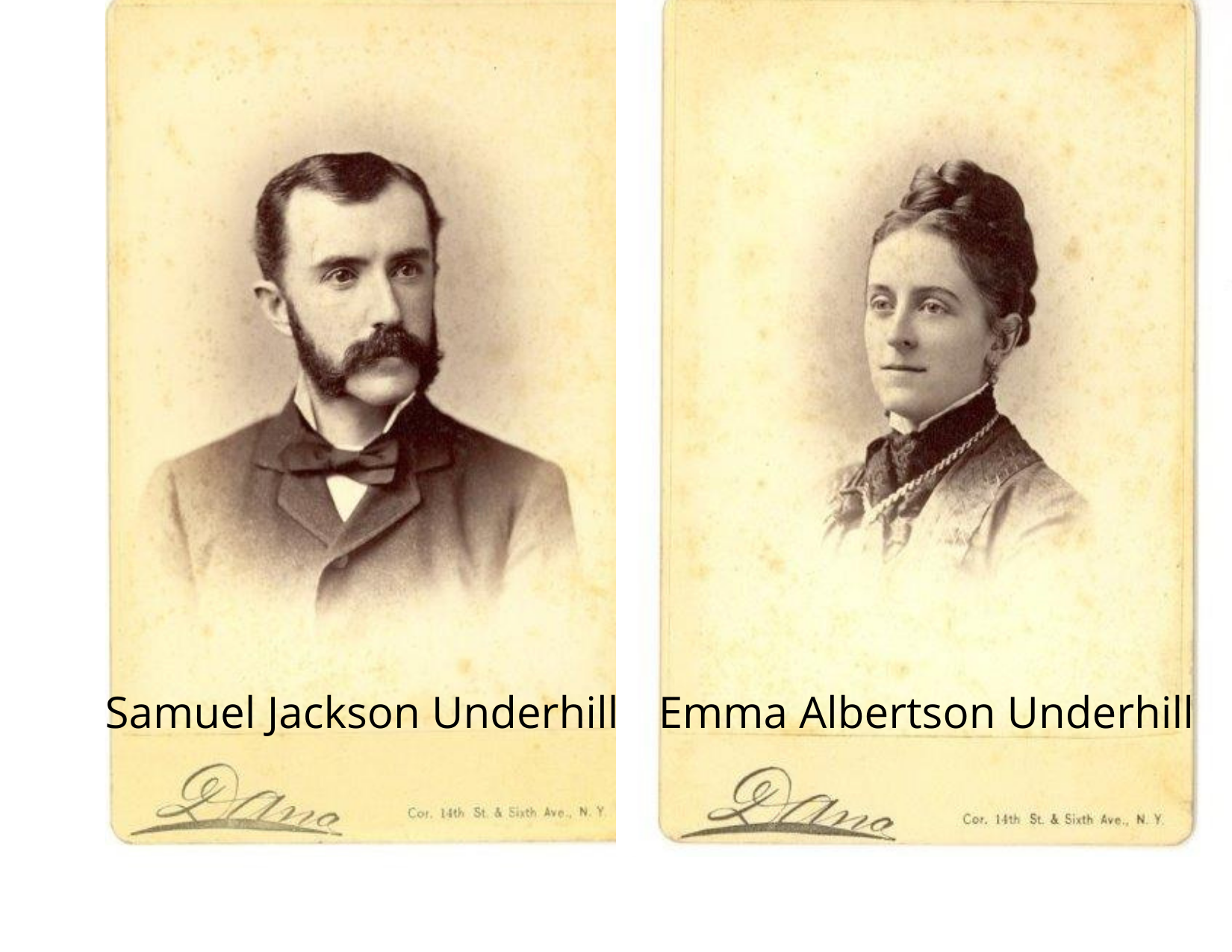 John (1813-??).
John (1813-??).
Underhill, Samuel Jackson (1848-1910) = son of Daniel and Caroline Post Underhill, he married Emma Albertson in 1872. They had two sons and one daughter. Daniel (1874-1951) married Bertha Coer in 1938 and Henry Willets (1882-1926) married Helen Wallower in 1912. Helen (1887-1924) married Levi Hollingsworth Wood in 1915, but had no children.
Underhill, Samuel Jackson (1797-1868) = a son of Daniel and Mary Jackson Underhill, was born in NYC. He married Mary Willets (1801-1878) in 1824. They had a son, Daniel Underhill (1826-1899) who married Caroline Post and daughter, Phebe, who married Elias Hicks Seaman.
Underhill, Samuel Seaman, Jr. (1878-1960) = son of a Jericho farmer, Samuel Seaman Underhill and Charlotte Galloway. “Sammie” married “Carrie” Holmes Jackson (1875-1948) of Jackson Corners, Syosset in 1900. They had two daughters, Alice and Phebe. He had a working farm and dairy on Jericho Turnpike just west of Robbins Lane and was at one time the Secretary of the Queens Agricultural Society.
Uris, Percy (1899-1971) = son of a real estate developer, he and his brother Harold created the Uris Building Corporation in NYC. Percy married Joanne Diotte and had a few homes on LI. One in Sands Point, "Sandy Cay" that burned down and 2 in Jericho, "Green Pastures" and later "Broadhollow."
V
Van Nostrand, Isaac (1762-1834) = son of John Van Nostrand and Jannetje Remsen, Isaac was born in Wolver Hollow, Oyster Bay. He married Martha Simonson in 1780. They had ten children.
Van Nostrand, LeRoy (1900-1961) = born in the house his grandfather built in Jericho around 1800. LeRoy was a founding member of the Jericho Fire Department and served as fire commissioner for 28 years. He started the first Boy Scout troop and was a member and former president of the Jericho Board of Education. He worked as a foreman for the NY State Department of Public Works for 38 years. He was married to Dorothy, and they had a son Paul and daughter Pamela. He is buried in the Brookville Cemetery.
Vanderbilt Cup Races (1904-1910) = William Kissam Vanderbilt II, age 26, sponsored the first automobile race on Long Island in 1904. Greatly opposed and very controversial, the race ran on public roads from Hempstead, New Hyde Park, Mineola, Westbury, on Jericho Turnpike past Powell’s Hotel, where people could watch the race while standing on the porch, and on to Hicksville. Spectators watching these races reached up to 100,000 to 250,000. The races were finally banned in 1910 after the death of several spectators and racers.
Voight, Emil (1938-) = a Jericho resident and seasoned teacher he came to Jericho School District in 1964 where he taught American History and World History on the secondary level until he retired about 1992. He was the executor of Linda Braner’s estate and bequeathed her book, The Mailman Cometh to Jericho, to the Jericho Public Library.
W
Waldbaum's supermarket (1960-2000) = the local supermarket for many decades. Whole Foods took over that location after an immense renovation of the whole shopping center.
"Walls of Jericho" = See: Leonard, Charles R.
Washington, Kenneth E. = served as Jericho’s 27th Postmaster from 2000 to 2004.
Wealthy people of Jericho = Elbert Gary, Arthur Scott Burden, Middleton Schoolbred Burrill, Ambrose Clarke, Richard Flint Howe, George Edward and Lillias Juanita Kent, Albert Ludlow Kramer, Virginia Fair Vanderbilt, Joseph S. Stevens and Bronson Winthrop.
Weil, Kenneth = 2nd JPL Director, December 1982-December 1987. Ken was on the job for the library building’s expansion downward, adding a new entrance lobby with Circulation Desk, a new Children’s Room, Meeting Room, Technical Services Department, custodial space and a beautiful theater.
West Birchwood = the second large real estate development, 823 homes built in Jericho in the 1960s on the west side of Broadway, south of the LIE.
Westbury = first called Woodedge. Quaker Meeting house built here in 1702. In 1787 the Jericho Meeting was “set off” from here to a new site for Jericho Quakers, while Westbury Meeting remains still active today.
Westbury Music Fair = actually in Jericho. A large music facility known for years to attract many famous musical performers. It has undergone several name changes over the years as new owners have acquired the facility. At this time, it is known as the (New York Community Bank) NYCB Theater at Westbury.
Wheatley, Village of = See: The Lost Village of Wheatley by Randall J. LeBoeuf, Jr., reprinted from the Nassau County Historical Society Journal Vol 32, No. 1, 1972. LI Coll. Ref. #974.7245 L. Located mostly at the intersection of Wheatley Road and Whitney Lane, the Village of Wheatley was seen on many maps in the 1800s, especially “Beers” Atlas of Long Island, 1873. It even had its own school house for District No. 16, a blacksmith, carriage shop and wheelwright shop and more. In 1931 the Wheatley School District was made part of the larger populated Jericho School District # 15. Read more of the story in the book.
White Birch = 4th real estate development in Jericho, lying south of the Northern State Parkway and east of Broadway.
Whole Foods, Jericho = replaced Waldbaum's on Broadway in 2000.
Wicks Farm = owned by George Wicks is also known as the "Sod" farm is 53 acres located in the triangle formed by the south side of Jericho Turnpike and the north side of the LIE. On the east is the residential neighborhood known as West Birchwood.
Willets, Charles = served as Jericho’s 7th Postmaster from 1852-1854. He may have married Martha A. Hicks in 1852.
Willets, Lydia Moore (1830-1904) = Quaker, daughter of Alfred and Charlotte Moore of Oswego, NY. "Lottie" married Daniel Willets (1824-1884) of Jericho. They had Amy, Charlotte and Hannah Willets (1858-1896). Hannah Willets married Robert Seaman in 1894. She died giving birth to her only child, Phebe Underhill Seaman in 1896.
Willets, Mary R. = lived with her sister Caroline Willets and housekeeper, Edith Kuhnicke who donated a “huck” towel, signed “Mary R. Willets, 1875” to the JPL archives.
Williams Plantation = Samuel Willis surveyed the Plantation in “The Plantation Book,” 100 years after the “purchase”, trying to document the boundaries in a vellum covered book that was stored in Robert Seaman’s bank safe for years. There is no evidence of where it is today. The Town of Oyster Bay did set some official boundaries at one time.
Williams, Robert (1622?- 1681) & Sarah Washbourne (16??-1693) = Robert and Sarah married about 1646. They lived in the English community in Hempstead and had 6 children; two boys, John (1648) and Hope (1650), and 4 girls, Sarah (1652), Patience (1654), Mary (1656), and Esther (1658). In 1648, Robert purchased a large tract of land from the Algonquians, about 9 square miles in what is now the Town of Oyster Bay. He made other land purchases in Oyster Bay and the Huntington area. The family moved to Oyster Bay about 1660. About 1667 he, Sarah, John and Hope moved to Jericho. Robert died on a trip to St. Mary’s, Maryland in 1681. Sarah lived on in their home in Jericho for many more years.
Williams, Robert, School = See: Robert Williams School
Willis, Edmund (1752-1813) = one of the sons of Samuel and Mary Fry Willis. In 1778 he married Abigail Titus (1755-1793).
Willis, Elizabeth = married Isaac Bates in 1863. She is the mother of Jennie Bates and grandmother of Valentine and Florence Bates Tollaver. Elizabeth was a seamstress who worked with her daughter, Jennie for the Underhill family doing sewing. She is buried in the Jericho Quaker Meeting Burying Ground.
Willis, Fry (1744-1820) = son of Samuel and Mary Fry Willis. In 1770 he married Anne Seaman. They had twins, Thomas (1771-?) and Isaac (1771-1793).
Willis, Henry (1628-1714) = Quaker co-founder of Westbury, along with Edmund Titus (1630-1727).
Willis, Martha Townsend = See: Townsend, Martha
Willits, Mary Washburne (1628-1713) = a daughter of William and Jane Washburn, sister of Sarah Washburne Williams and wife of Richard Willits (162? -1664). After Richard died Mary moved to (“Lusum”) Jericho to help her brother-in-law Robert Williams claim his rights to the “Plantation.” She joined the Society of Friends and became a “minister and reared her children in the faith.” Her two-room home, built on 350 acres about 1725, grew and expanded to become the Maine Maid Inn which later became the Milleridge Inn three hundred years later.
"Windfall" = aka "Bayberry Downs," a mansion on Brookville Road, Muttontown. It was built (1928-1930) on 65 acres for Francis Tilden Nichols (1903-1998), designed by the firm Howard & Frenaye (William E. Frenaye, Jr. (1901-1960). It is 3 structures, house, gate lodge and garage done in French architecture with brick and half timbering, a tile roof and carved woodland figures. The Nichols fortune was made by his grandfather at Allied Chemical & Dye Corporation. His great grandson is William N. Koller. The house was later owned by Esmond Bradley Martin(1941-2018), an animal conservationist who was murdered in Nairobi in 2018.
Wisconsin Glacier = the last glacier to cover parts of North America, from Washington state to the Atlantic and Canada to northern New Jersey during the last Ice Age.
Wolf, Margaret Hartigan (1915-1998) = the daughter of John and Violet Hartigan, Margaret grew up in Jericho and attended Jericho schools (see: photo of 4/5 grade in 1925) with her three younger brothers. She came back after college, as an adult to teach 2/3 grades in 1940. She married Christian Wolf in 1945. They had a daughter Margaret Jean.
Woodnutt, Grace Anna Jackson (1864-1947) = daughter of Solomon S. Jackson and Annie Titus. She married Henry Woodnutt C. Jr. in 1889 and they had Josephine J. Woodnutt (1895-1981) and Katherine A. Woodnutt (1893-1992), who resided in Jericho. The sisters never married. Josephine wrote poetry. See also: Woodnutt collection box.
Wright, Anna Augusta (1899-1964) = daughter of William and Theresa Wright, Anna “lived in” for a time with the Bayer family in the Valentine Hicks house. She married John Bodine Doughty.
Y
YMCA = a small non-descript building on the north side of Jericho Turnpike on the western edge of the office building complex in the 1980s. Later it may have served as a Scout meeting facility before it was demolished for more office space.
Z
Zederbaum, Robert = Jericho Fire Chief from 1984-1985.
Zog 1 (1895-1961) = King of Albania. His real name was Ahmed Muhtar bey Zogolli. He rose from tribal chief to Prime Minister, then President and King of Albania until 1939 when he went into exile during WWII, with his Roman Catholic wife, Geraldine and their son, Leka. Zog purchased Knollwood Estate, built by Charles Hudson on Rte. 106 in 1951 for more than $100,000. He planned to refurbish it into a mini kingdom, but never moved it. The abandoned property was vandalized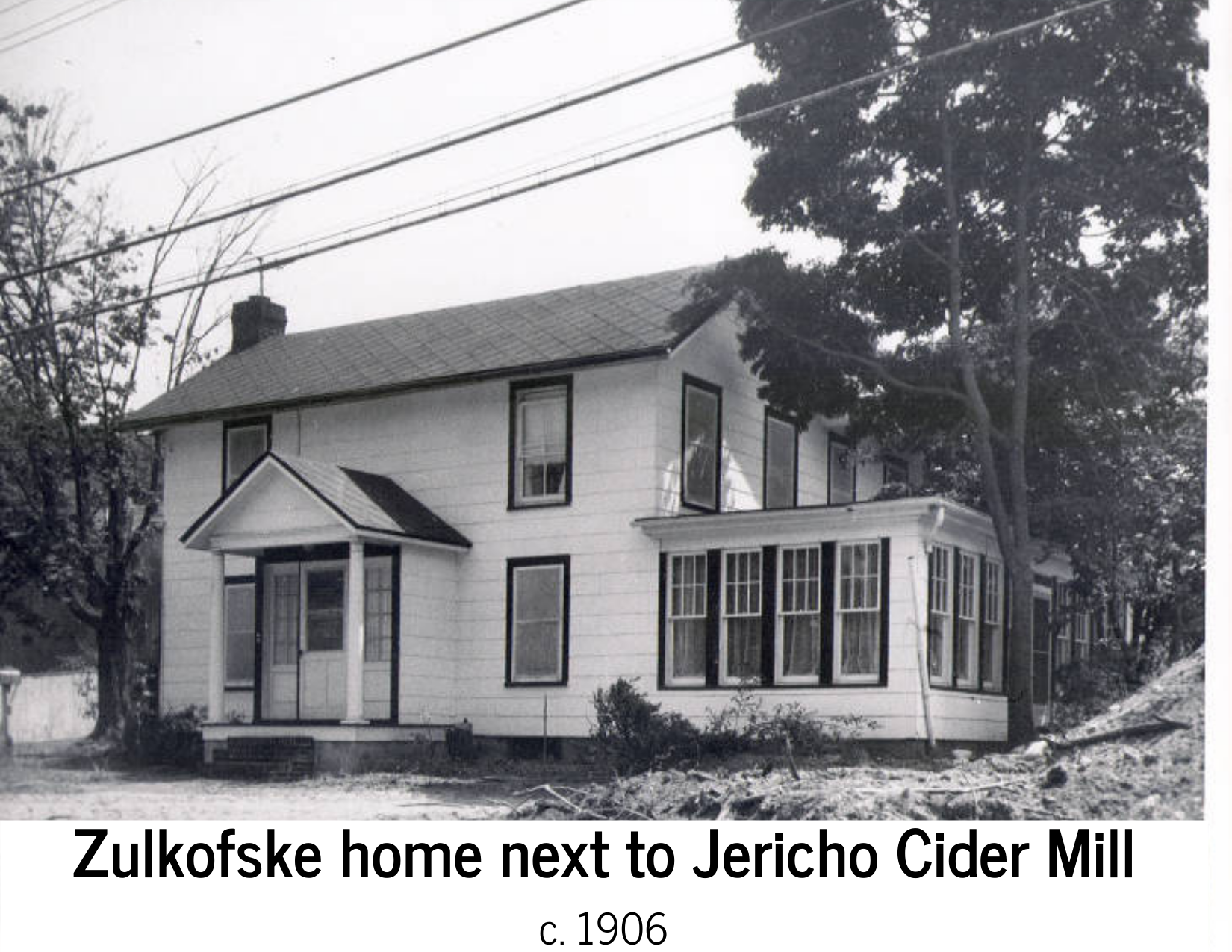 and fell to ruin. It was sold to Landsdale Christie in 1959. It is now part of the Muttontown Preserve.
and fell to ruin. It was sold to Landsdale Christie in 1959. It is now part of the Muttontown Preserve.
Zulkofske or Zulkofski, Bertha (1923-) = daughter of John and Mary. She married Charles Dwyer in 1947.
Zulkofske or Zulkofski, John Joseph (1894-1987) and Mary (1899-1987) = John was called “Farmer John” probably because he had vegetable farms on Jericho Turnpike. He married Mary Noheji in 1918. John, a founding member of the Fire Department, said that after one of his barns burned down in 1933 it helped show the need for a Fire Department in Jericho. He bought the Jericho Cider Mill in 1938. It was open from fall to spring, and eventually was selling more than 100,000 gallons of cider per year. They also sold apples and pies made by his wife Mary. The mill was taken over by their son, George in 1974. John worked as a mechanic at Grumman Corp. during WWII. Mary died in April 1987 and John died in September 1987 at age 93. Both are buried in Holy Rood Cemetery, Westbury.
Zulkofske, George (1935-2016) = son of John and Mary, George graduated from Jericho schools and Hicksville High school in 1953. He married Carol Thorschmidt in 1961. He was an active member of the Jericho Fire Department. George took over the Cider Mill from his father in 1977. His daughter Deborah also worked at the Cider Mill.
Zulkofske, Phillip George (1927-2002) = He married Margaret Hnatuk and ran a retail fuel oil business. They lived next door to John, Mary and his brother, George Zulkofske. He served in the US Navy.
